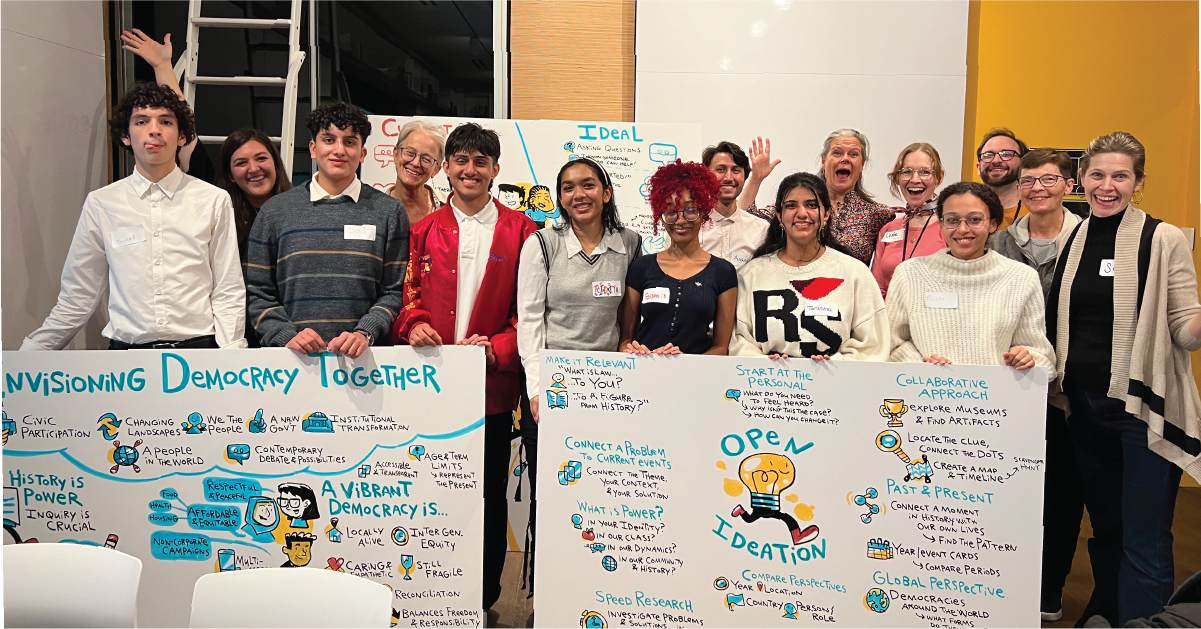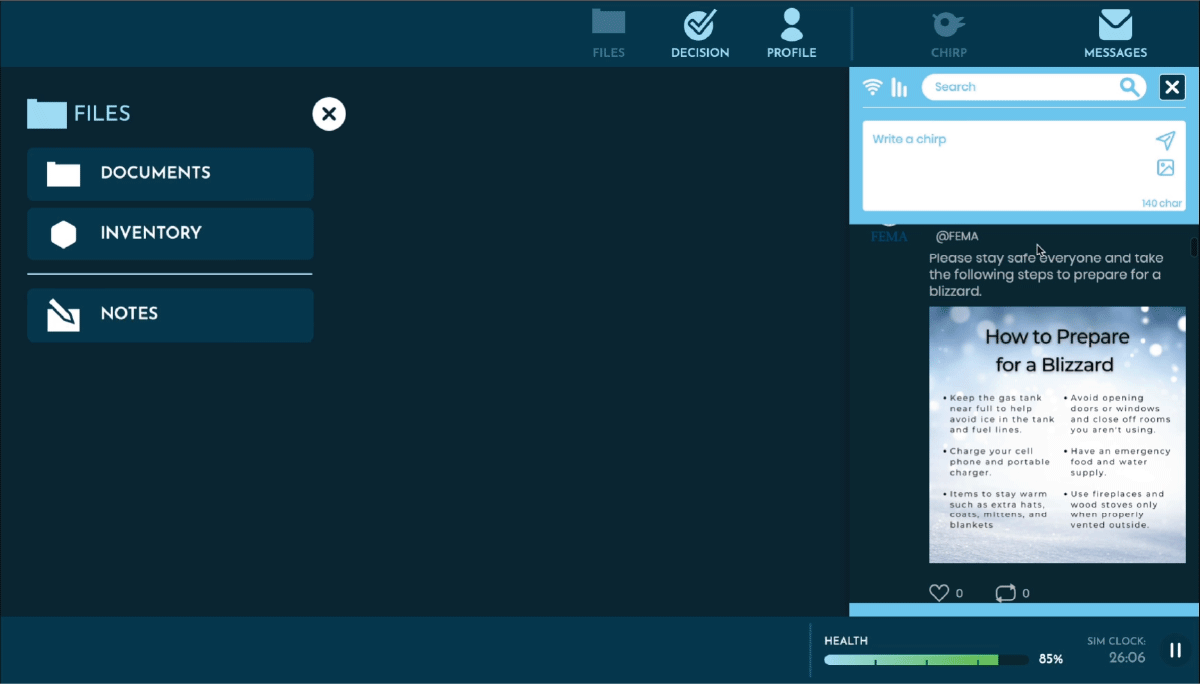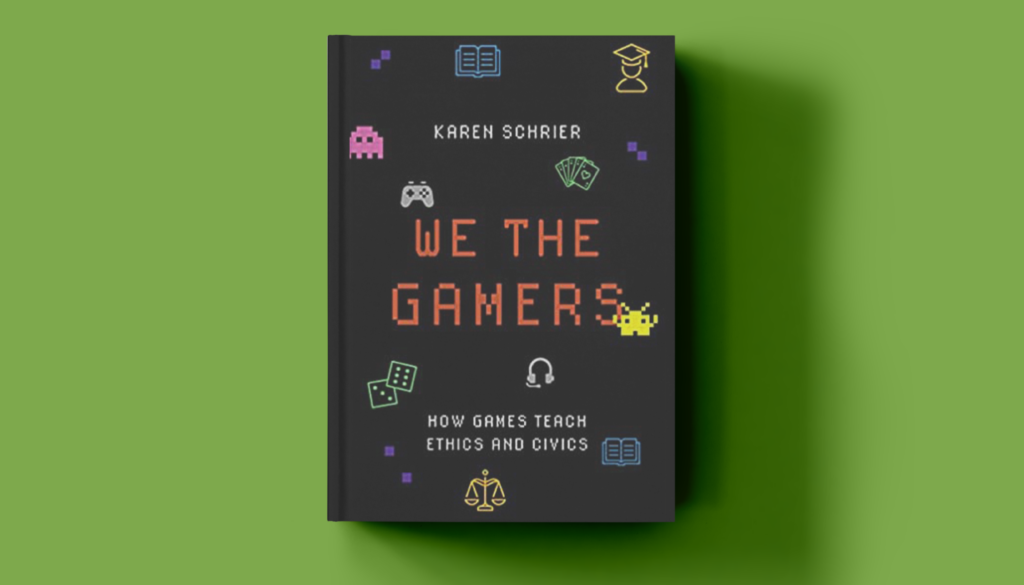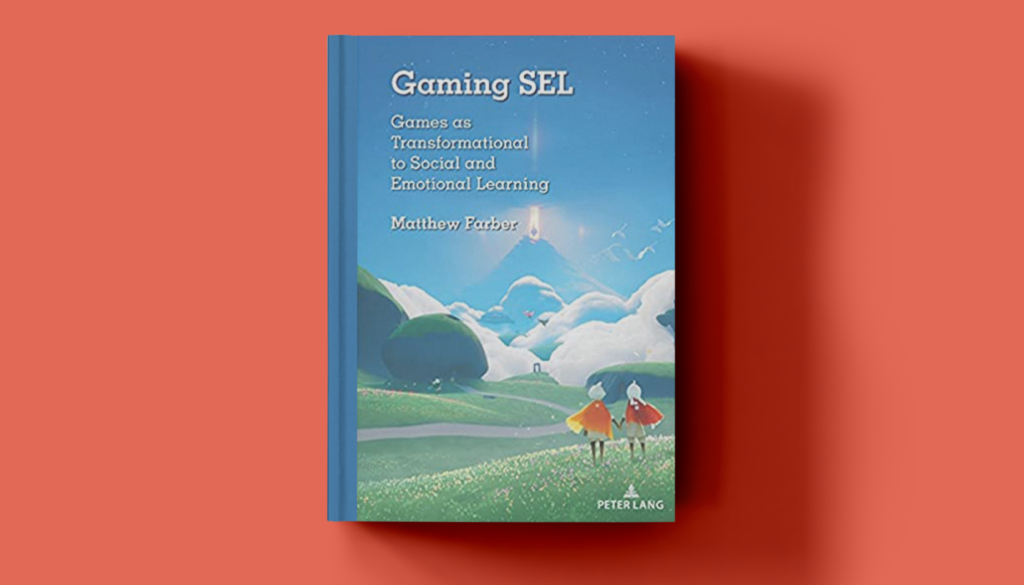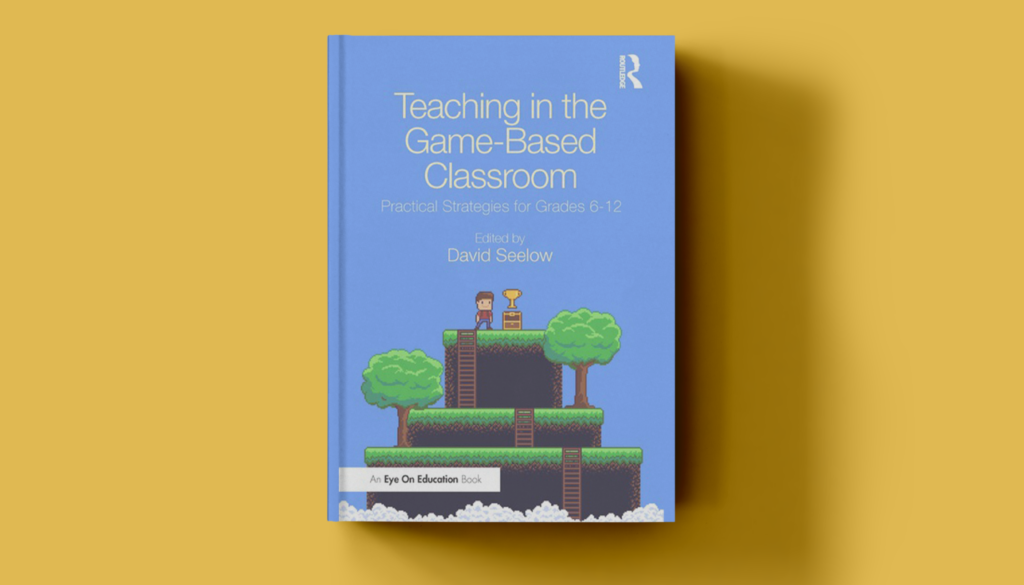Teen Co-Design is Teen Learning: The Story of The Porcelain Child
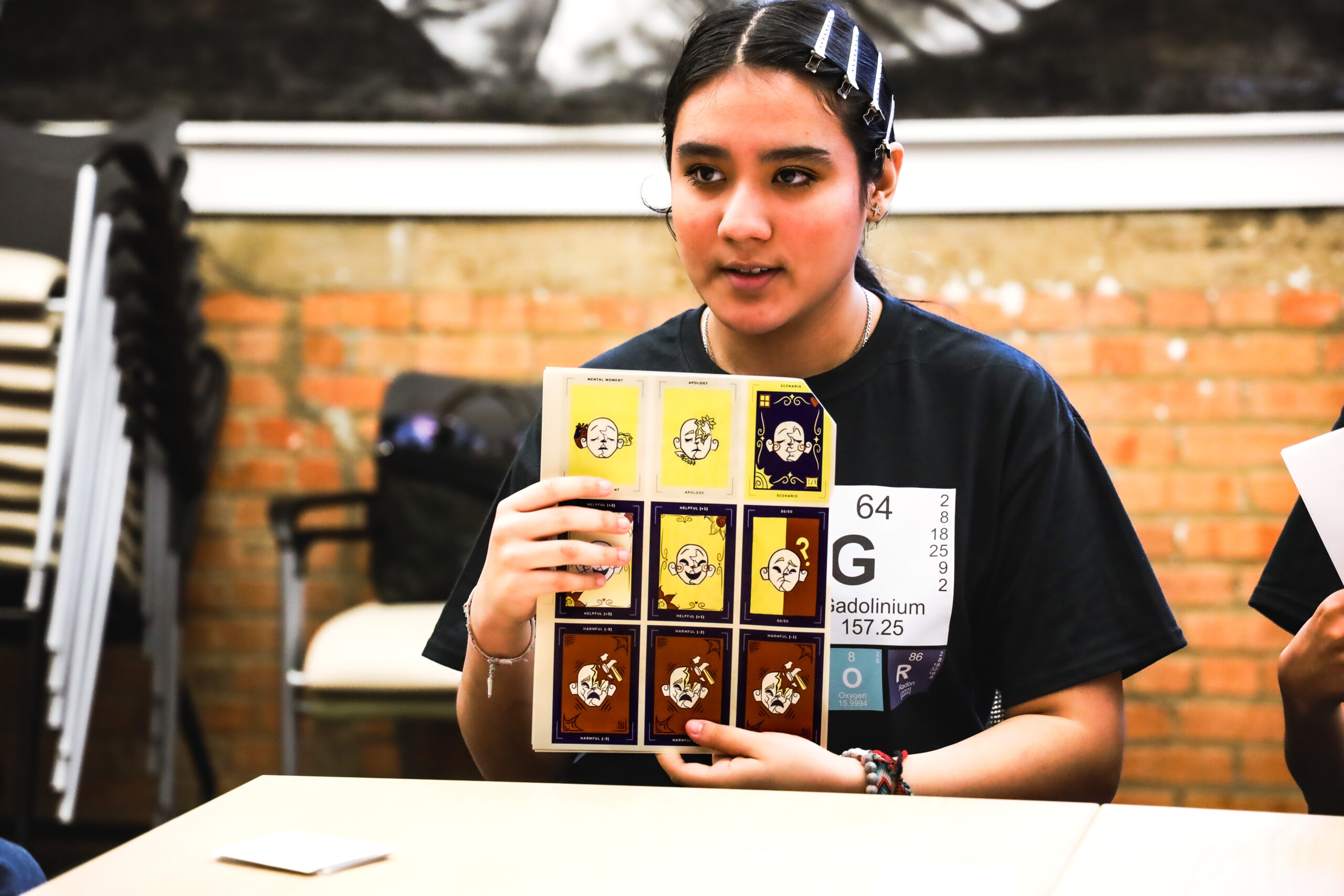
What happens when teens are invited not just to play—but to design, decide, and disrupt?
In a workshop room in Dallas, Texas, a group of teenagers gathered around a table and began to share their wishes for how they wanted adults to show up for them. One talked about the way their teacher dismissed them. Another reflected on the echo of a parent's words. "It's like being made of porcelain," one teen said. "Every time it happens, you crack a little." Together they asked, what if adults knew how much their words can hurt us?
From that conversation, a game was born to help adults learn. It was called The Porcelain Child—and like the teens who made it, it doesn't flinch from the truth.
A GAME DESIGNED TO BE HEARD
The Porcelain Child is a teen-designed tabletop game about the impact of adult words and actions on young people. Through collaborative gameplay, players consider scenarios, choose reactions, and see—in real time—how words can hurt or heal. It's a mirror, a conversation starter, and a call to action.
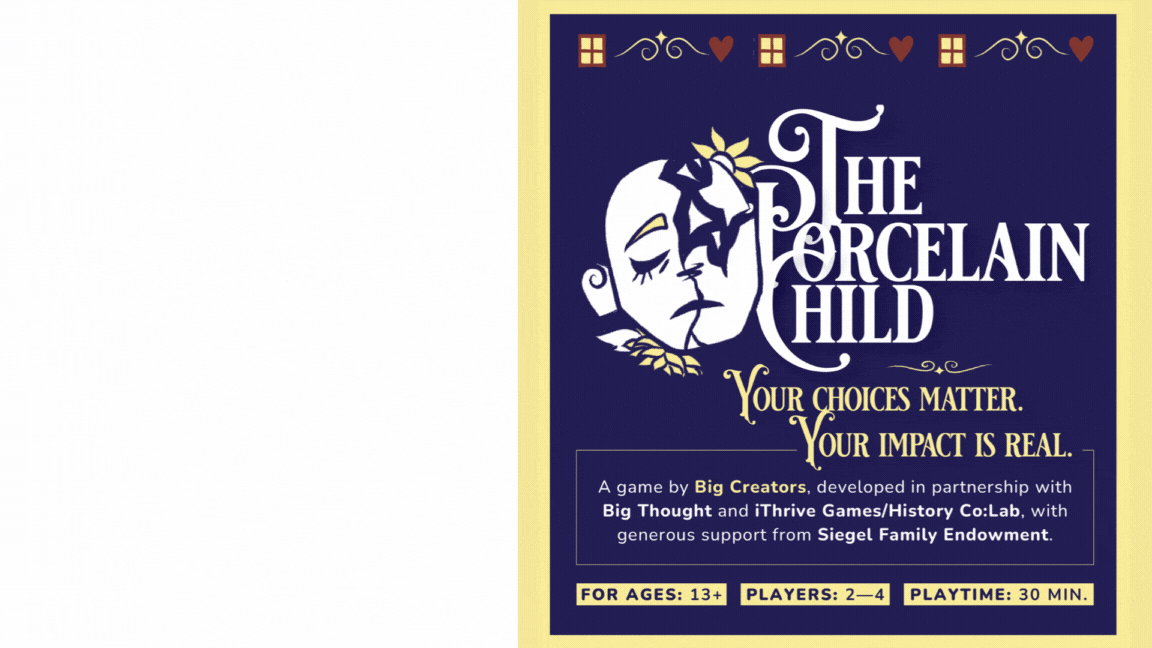

Pictured are the teen-designed game materials from the tabletop game The Porcelain Child, including the body board (left) and card options (right).
Created by 25 teen designers in a Game Design Studio (GDS) co-hosted by iThrive Games at the History Co:Lab—in partnership with Big Thought and Fit and Faithful Living, and with generous support from the Siegel Family Endowment—The Porcelain Child was designed entirely by youth. From early brainstorms to the final prototype, the teens—who later named themselves Big Creators—led every step of the process.
What emerged was not just a game, but a powerful learning experience supportive of collaborative growth and the social-emotional skills needed to thrive as contributions in a connected world. "I usually do everything solo," one Big Creator shared. "But this made me realize how powerful it is to create with other people—and be heard."
LEARNING IN LAYERS
The Game Design Studio model is more than a method for making games—it's a process for making meaning. Rooted in learning science, adolescent development as well as systems and design thinking, Game Design Studio supports youth in analyzing real-world challenges, envisioning change, and expressing their truth through game design.
"Co-design in the Game Design Studio experience is about teens learning and playing together," shared Susan Rivers, Chief Scientist at iThrive Games, co-lead at the History Co:Lab and co-architect of the Game Design Studio model. "They learn best as they make something meaningful together. Through the creative collaboration process, they build trust, grapple with understanding the systems surrounding them, and express themselves. The process invites teens to use their voice and their lived experiences to contribute to important conversations and imagine what's possible. The game is an artifact of their learning and an invitation for others to engage with them."
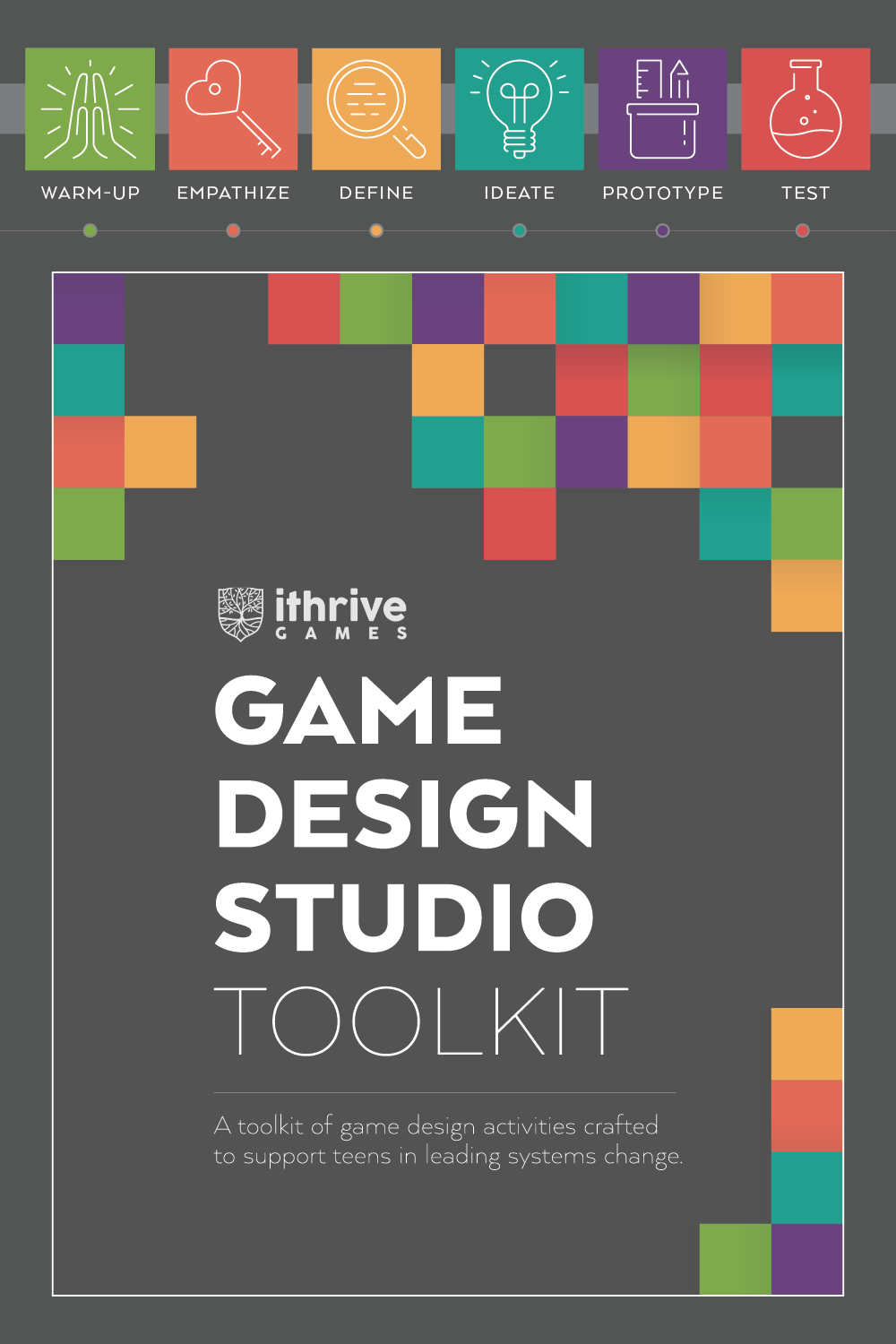
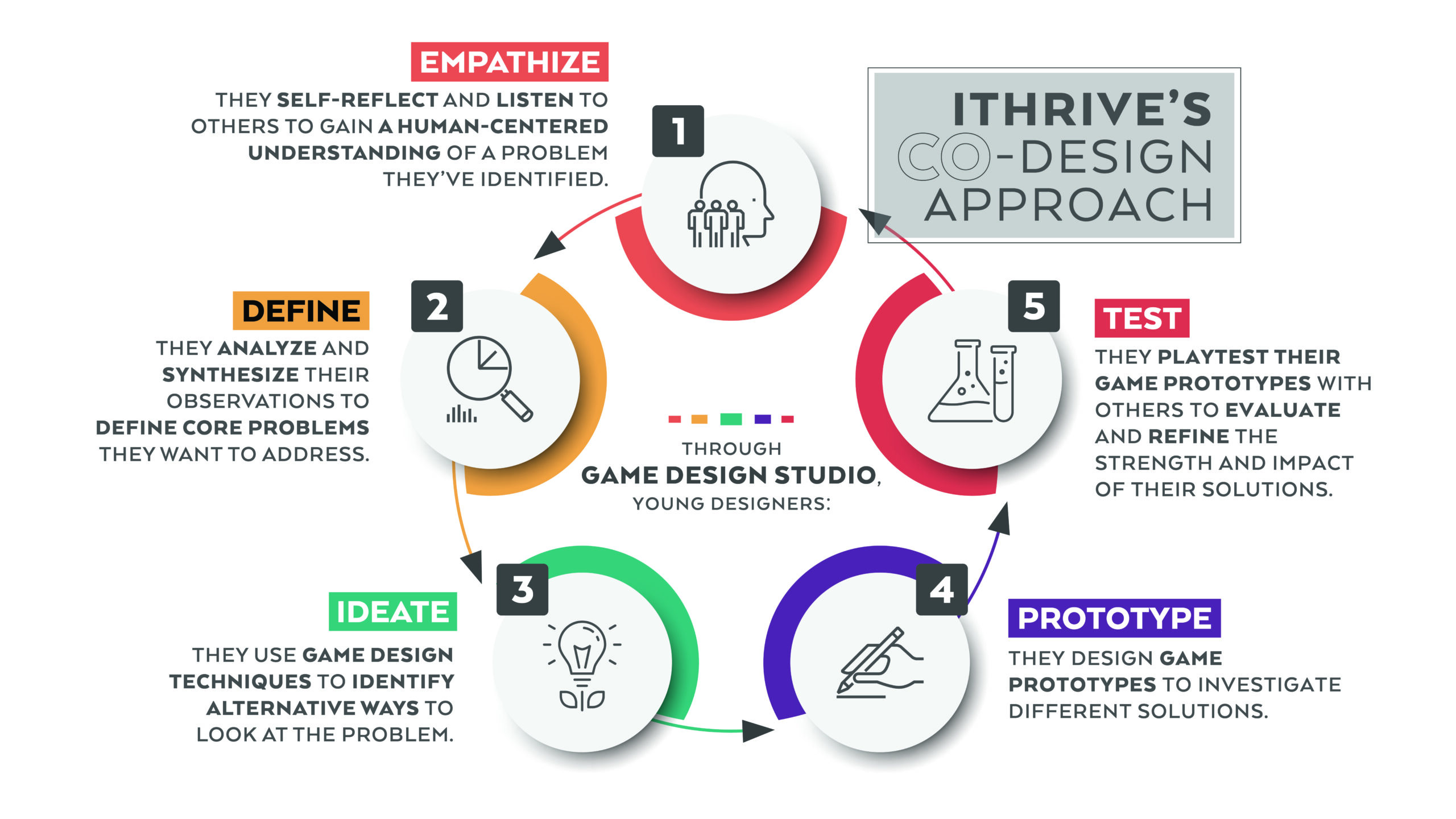
Game Design Studio (GDS) is a teen-led and teen-centered learning experience that invites youth to turn their lens and lived experience into games that spark dialogue, connection, and change. Download and explore the GDS toolkit.
Game Design Studio offers a different way to learn-one centered on teens and where they are developmentally.
"It just taught us how to communicate with each other and learn from each other," shared one Big Creator. "We all built off of each other to end up with this amazing game." Another added, "To be able to listen to other people's ideas and take it in and mix it together to get a final product—that's a big thing we are going to have to use."
RESONANCE BEYOND THE ROOM
In March 2025, the Big Creators debuted The Porcelain Child at SXSW EDU in Austin, Texas. Invited by the Siegel Family Endowment, the team of teen designers facilitated playtesting sessions and shared their stories with funders, educators, and attendees from across the country.
The feedback was personal and profound:
"This game made me realize I've got work to do," said Gregg Behr, Executive Director of The Grable Foundation. "It felt personal."
"The relationship between play and learning is incredibly strong," said Bo Stjerne Thomsen, Head of Impact at LEGO Education. "It provided an invitation to speak about issues in the family that are really difficult to uncover without play."
"It's a game I wish my parents had access to when I was a teen," shared Alicia Cagle, Youth Programming Manager at the World Affairs Council of Pittsburgh. "..It's a great tool to prompt valuable conversations."
"It's a powerful conversation starter," said Jason Swanson, Senior Director of Strategic Foresight at KnowledgeWorks.
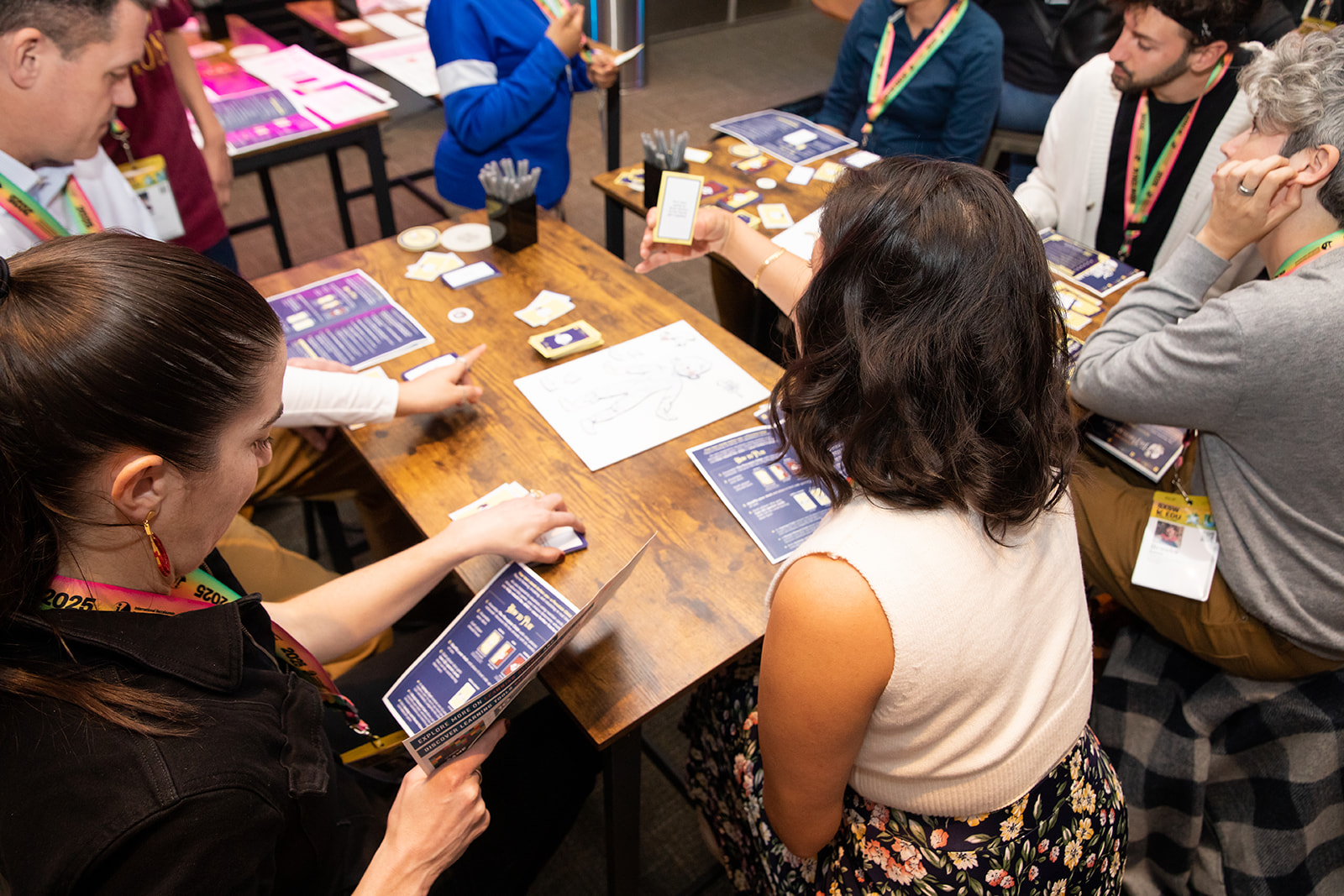
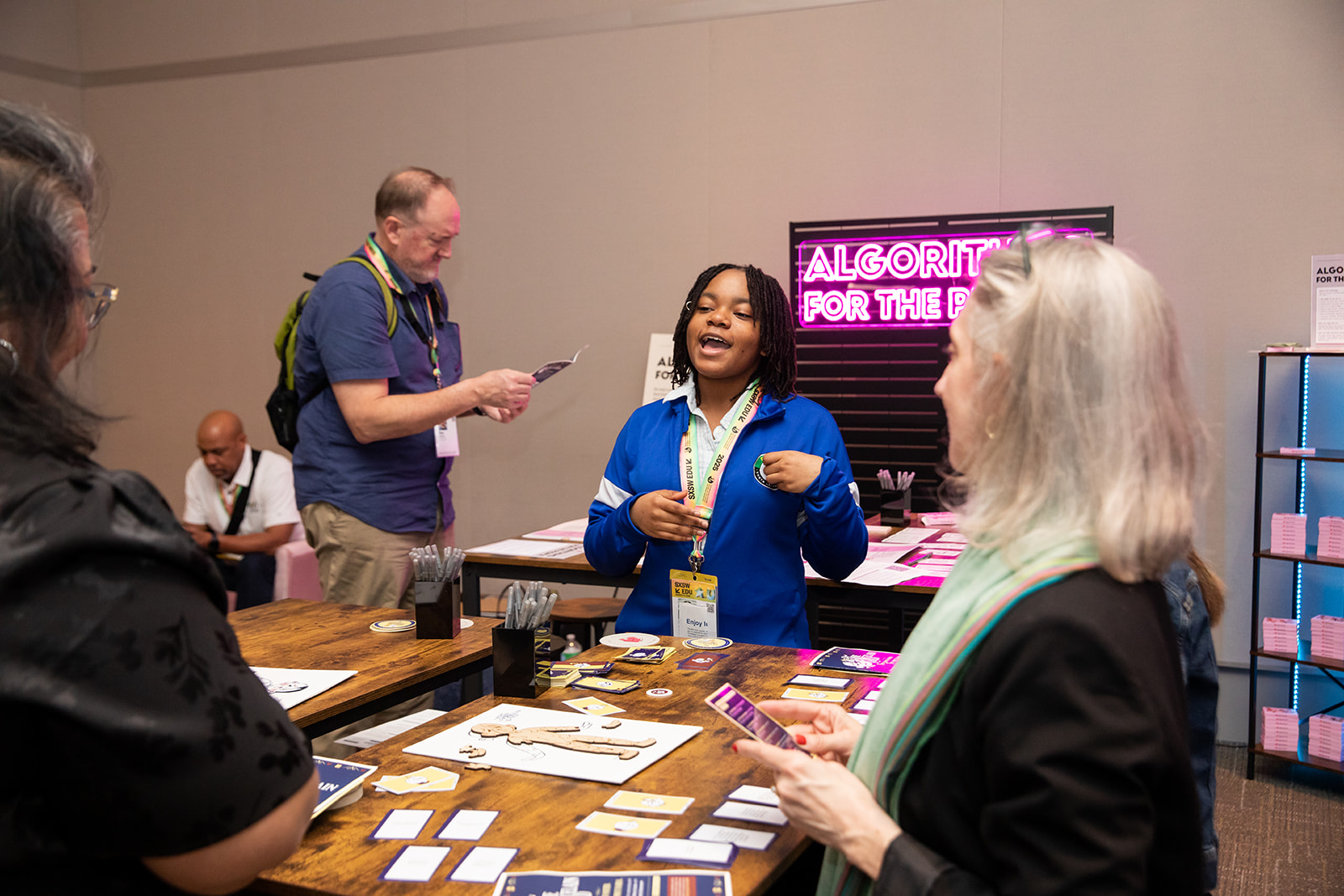

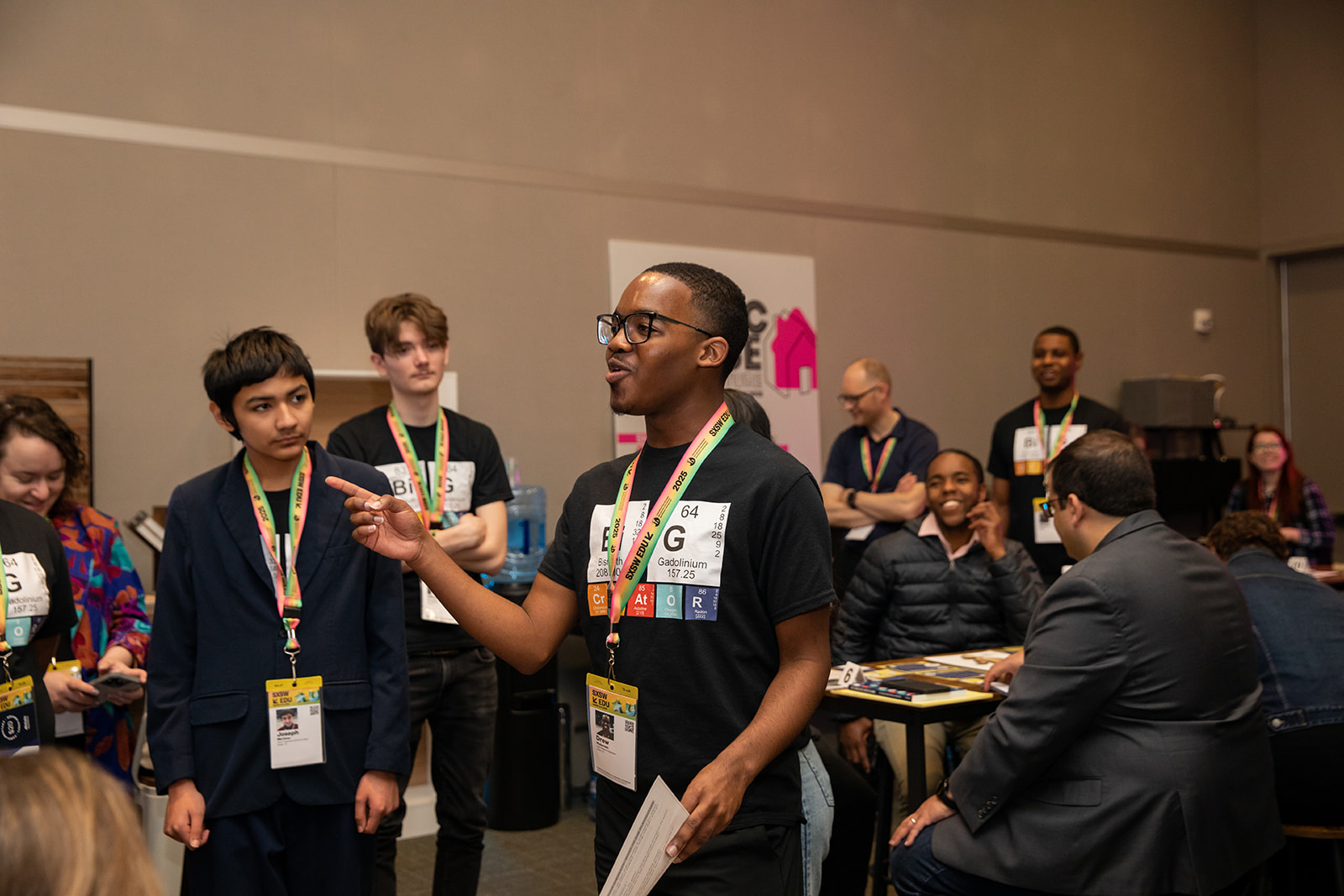
The teen design team behind The Porcelain Child was invited by the Siegel Family Endowment to present and playtest their game at the Stanford d.school lounge at SXSW EDU 2025 where adults engaged, reflected and offered feedback.
The Big Creators noticed the impact of their co-designed message, too. "Watching adults play the game, it gave me a different perspective," one said. "The parents who already had children were like, 'I could've done this differently.'"
Some youth took away an even more lasting message: "Being part of the art team gave me a great idea of what I'd be getting into if I was to do work like this professionally," shared one Big Creator.
Through co-design, they weren't just crafting gameplay—they were shaping a message. One that carried their truth, their experiences, and their hopes about disrupting adultism into places far beyond their original design table. In doing so, they discovered their strengths, clarified their values and realized their message—rooted in care, courage, and truth-could move people, shift conversation, and ripple far beyond the room.
COMMUNITY GROWN, RELATIONSHIP-DRIVEN
The Game Design Studio experience is designed to deepen relationships between teens and adults—showing what's possible when adults listen, support and step back to let teens lead. Nearly every Big Creator spoke to the impact of how adult facilitators show up during their co-design journey. "They gave us an open space," one teen shared. "They stepped back—but when we needed them, they stepped forward for us. So that really helped us grow."
That balance of support and respect was intentional. "When I say 'greatness,' we just want kids to get the best," shared Reggie Dupard, co-founder of Fit & Faithful Living. "We want our young people to know that if you need somebody in your life, we're here for you and we'll be that person that advocates for you."
Teen designers credited their team of adult collaborators-including our design team at iThrive Games/History Co:Lab, Big Thought's Armando Banchs, Evan Cleveland, Rachel Hull, and Denesha Ogunsegha; Art by Martell's Martell Holloway; and Fit & Faithful Living's LaChanda and Reggie Dupard, and the iThrive / History Co:Lab team—for creating space to explore, reflect and lead. The adults offered guidance when needed and consistently affirmed the genius and brilliance of the youth they worked alongside.
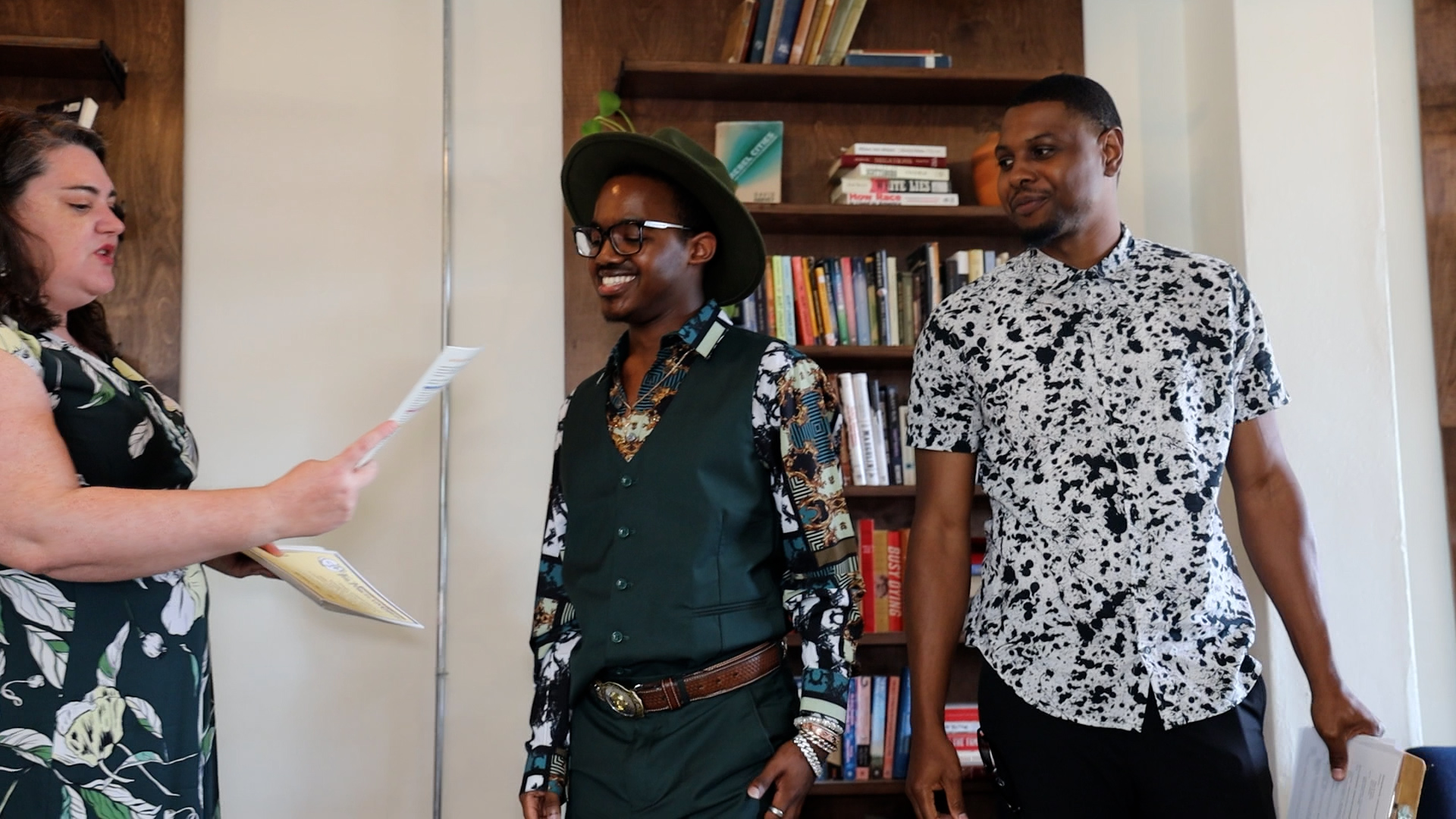

On Celebration Day, the teen designers behind The Porcelain Child celebrated their growth, reflected on their game and honored the intergenerational community that made it possible.
Big Thought's commitment to youth creativity through its Creator Archetype framework and direct-to-youth programming helped make this co-design experience possible. Their environment empowered teens to lead, explore, and shape meaningful artifacts of change. As Amarando Banchs, Sr. Manager, Creative Archetype, shared during the intergenerational team's Celebration Day, "These are the skills—grit, rigor, muddiness, storming and norming—that youth need to step into a world that's constantly shifting." He reminded the parents, guardians, friends of designers, and all listening that the most powerful artifact of this learning experience wasn't just the game—it was the teens themselves. "This work is about the heart. Look at the youth in the space that worked on this... because they're really the artifact."
On the culminating Celebration Day hosted at Big Thought's HQ, youth, families and collaborators gathered to honor what they built together. "This wasn't just a project," shared Fernande Raine, founder of and co-lead at History Co:Lab. "It was a coalition rooted in belief: belief in youth brilliance, and in the power of making meaning together."
MORE THAN A GAME
The Big Creators designed The Porcelain Child to do more than entertain—they designed it to invite adults into conversation, reflection, and change.
"This experience taught me how my voice can change situations I believe are unfair," shared one teen designer. "My hope is that adults reflect and realize how their actions impact a teen's mind," added another. "This game shows them," emphasized a third.
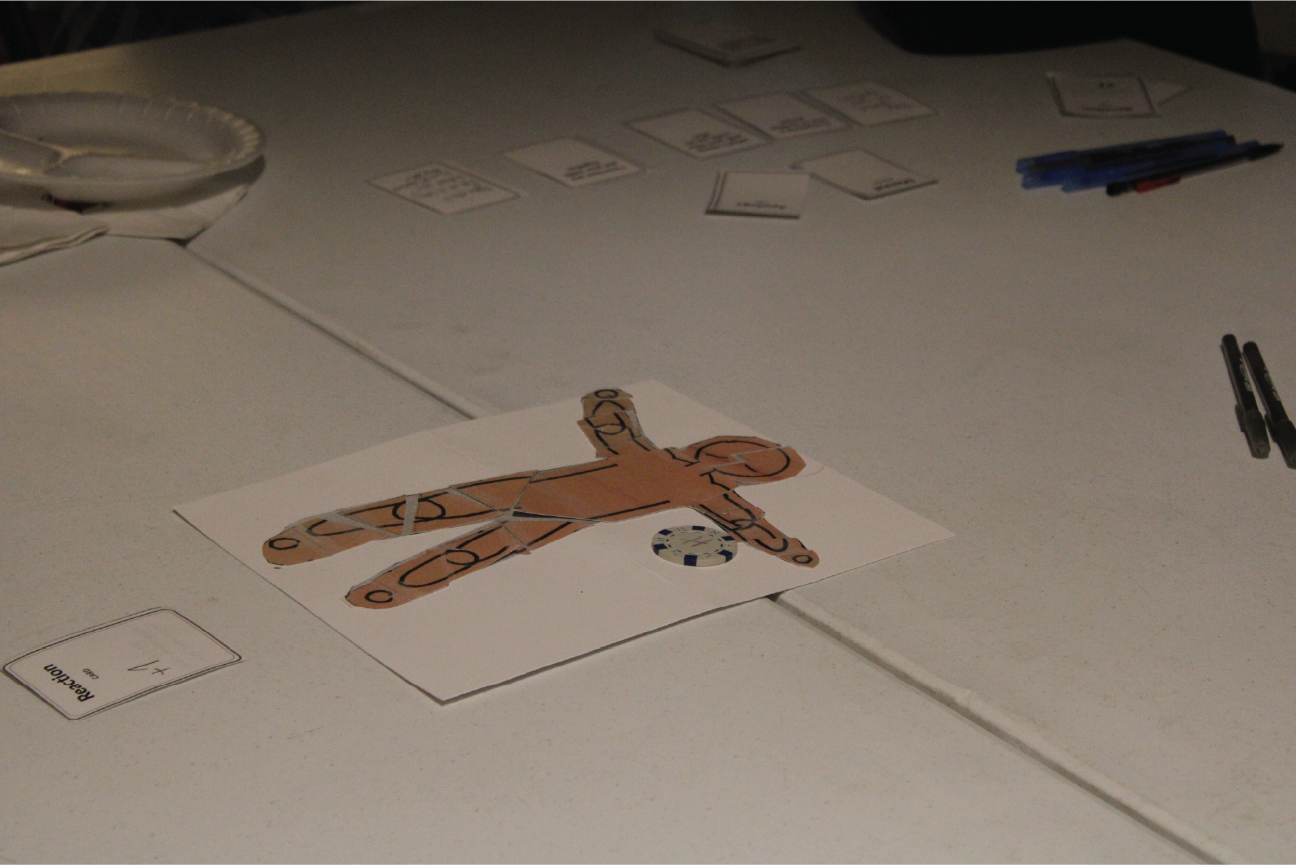
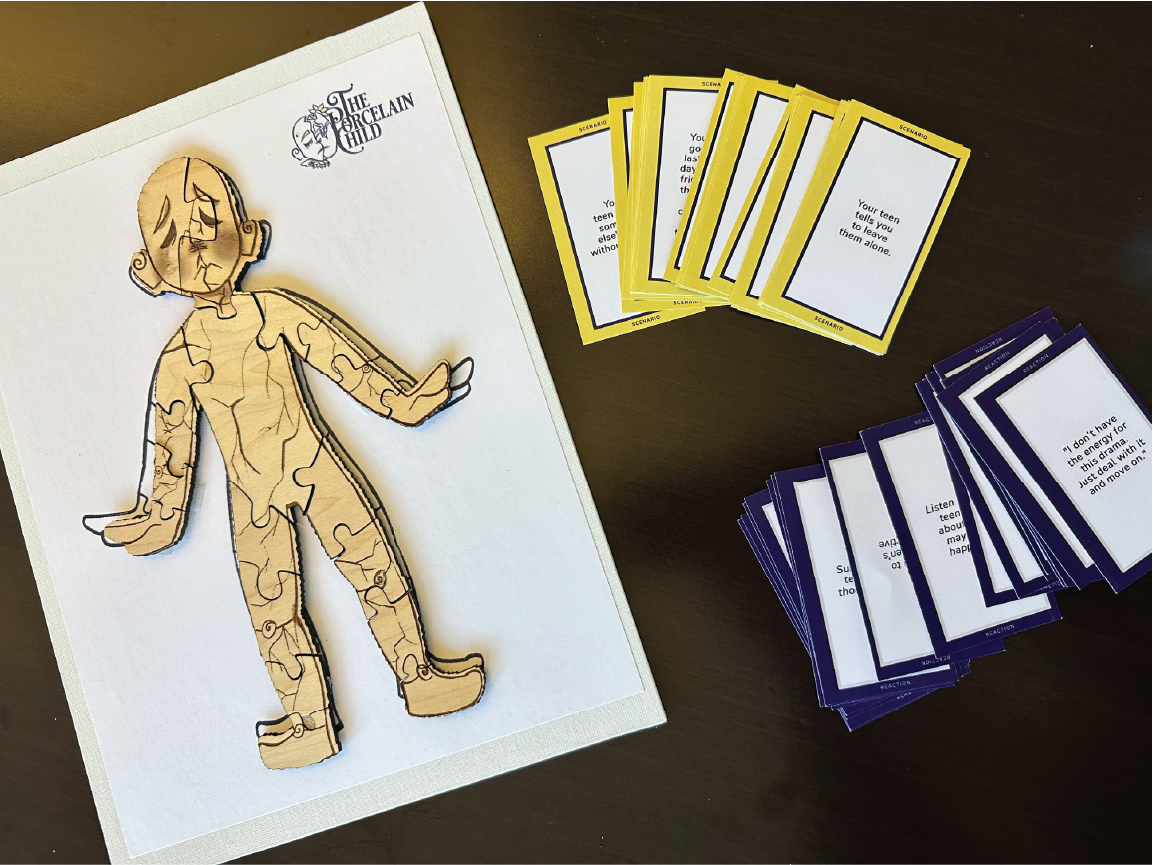
Early ideation vs. prototype phases of The Porcelain Child.
Through co-design, the youth behind the game transformed lived experiences into a critique of the systems that impact them. They deliberately designed mechanics, narratives, and choices to reveal how words and actions ripple through a young person's life. The result is an empathy-building, intergenerational dialogue tool that invites players to pause, reflect, and connect. As of May 2025, The Porcelain Child is being playtested across Dallas—on kitchen tables, in school gyms, and at community events—sparking conversations about listening, care, and the small moments that build or break trust between adults and youth. Each card played is a spark. Each round, a reflection. Each conversation, a step toward healing and change.
This game is just one example of what's possible through Game Design Studio—a model and toolkit used by educators and youth-serving institutions who believe in the power of young people to make meaningful change. Across schools, community programs, and even international settings, GDS invites teens to design tabletop games, digital stories, and immersive simulations that center their lived experiences and civic imagination.
Game Design Studio meets teens where they are—and offers them the tools to imagine, build, and lead us somewhere better.
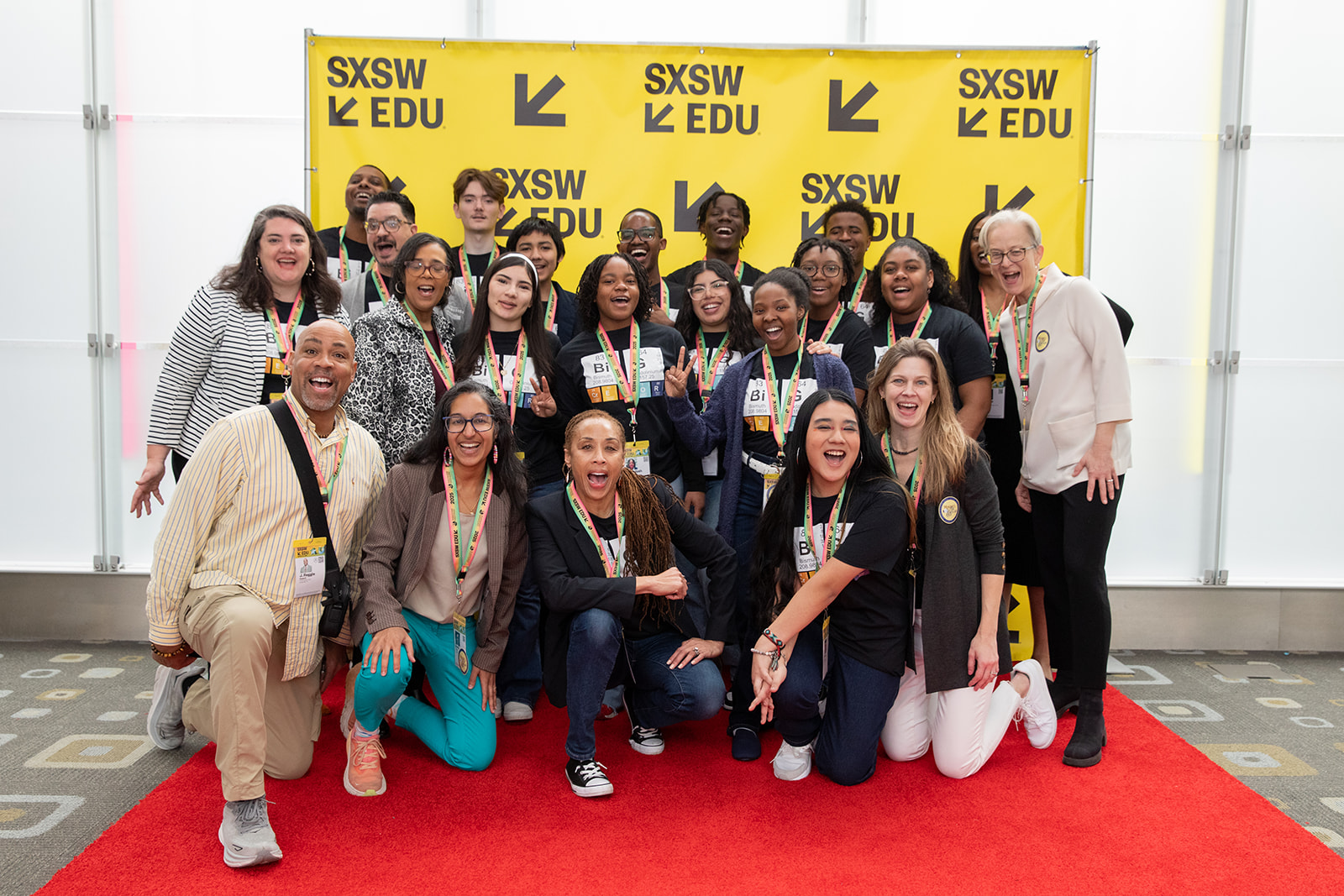
After leading their workshop at SXSW EDU 2025, the Big Creators stop for a candid, celebratory moment.
If you're a partner (i.e., educator, funder or youth-serving organization) ready to center teen voice in a transformational way—we invite you to connect.
Using SEL Tech in Classrooms? Five Questions Every Educator Should Ask
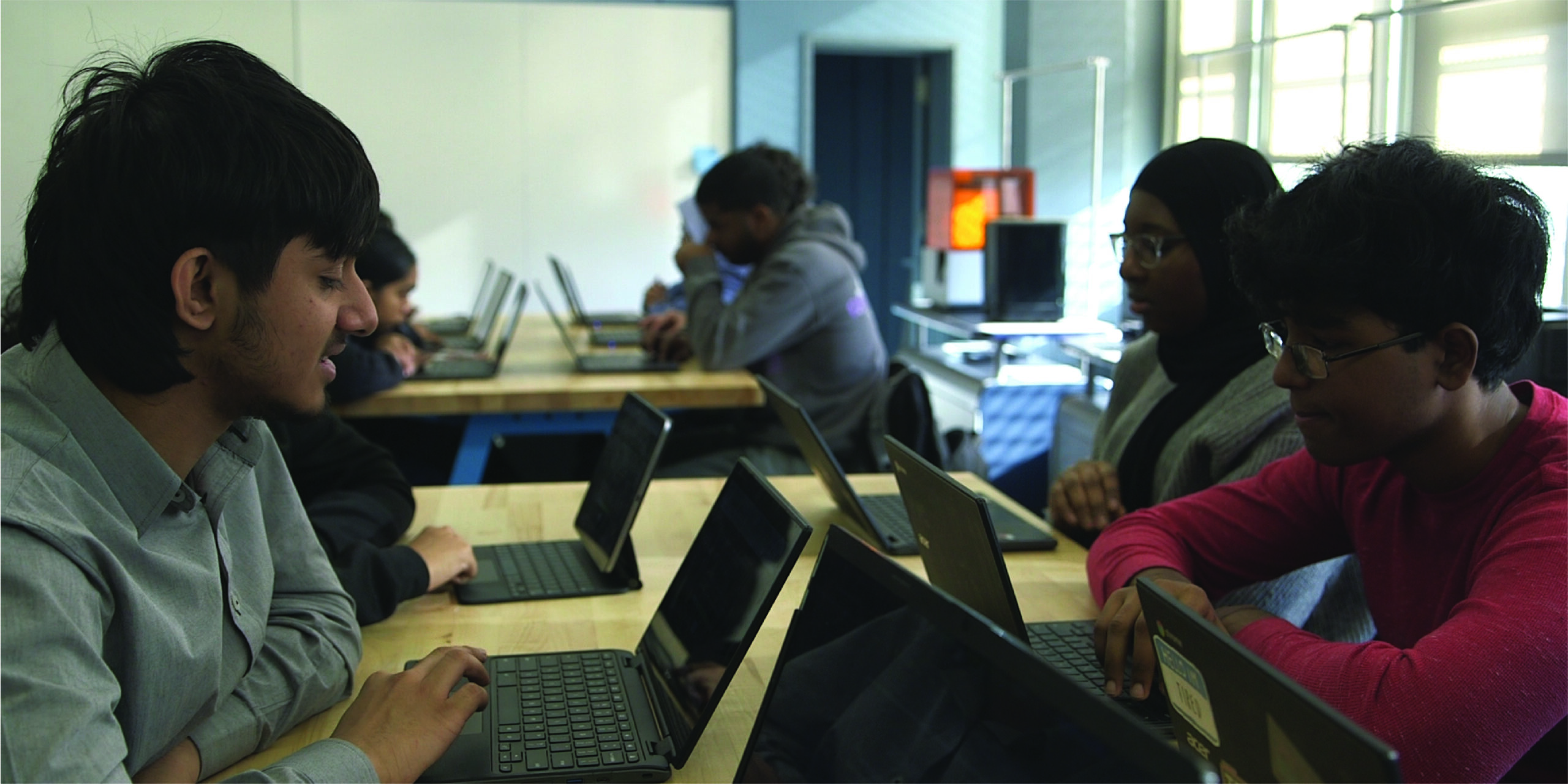
What transforms a classroom into a socially and emotionally supportive space where learners thrive? At its heart, it's connection—the relationships that make students feel seen, supported, and valued.
Research consistently shows that students excel when they trust their teachers and feel a sense of belonging with their peers. These bonds fuel engagement, emotional growth, and academic success.
As educators, you already know the power of relationships. But in today's classrooms, technology is also shaping how we connect, teach, and learn. In fact, roughly nine in ten K-12 educators in the U.S. believe education technology positively impacts student engagement and use it in their classrooms (Zipdo, 2023). The potential for tech to enhance learning is immense—but how can it be used thoughtfully to strengthen the relationships and skills at the core of social and emotional learning (SEL)?
In the "SEL and Technology" chapter of the newly released Second Edition of the Handbook of Social and Emotional Learning, co-authors Susan Rivers and Michelle Bertoli of iThrive Games/History Co:Lab, alongside Urban Assembly's David Adams and Eaton Middle School's Letha Mellman, explore how technology, by design, "must value and center learners in all their diversity of capacities, interests, motivations, contexts, and experiences." They emphasize that social and emotional learning (SEL) technology should "center and enable meaningful relationships between learners and the adults involved in their learning, as well as with themselves, other learners, and the larger community and planet."
To fully harness the potential of SEL tech, educators must intentionally choose technology that will support relationship building in classrooms. Doing so ensures that learning environments remain human-centered and that learning remains relationally driven.
SEL TECH USE IN THE CLASSROOM: FIVE CRITICAL CONSIDERATIONS
SEL tech offers tools to foster connection, amplify engagement, and help students practice essential skills like empathy, self-regulation, and collaboration. However, realizing its promise requires intentional integration. Educators, here are a set of five questions to ask yourself when evaluating and using SEL tech that help ensure it supports a meaningful, learner-centered classroom.
- How does it strengthen relationships?
Technology should enhance, not replace, human interaction. Tools that create opportunities for meaningful teacher-student and peer-to-peer relationships can deepen trust and foster collaboration. Tools like OKO provide a platform for students to build knowledge together, engage in creative problem-solving, and make learning a shared experience supportive of connection and care in classrooms.
- Does it prioritize ethical data use and privacy?
Many SEL tools collect sensitive information, such as students' emotions or behavior patterns. Protecting this data is critical to maintaining trust and establishing emotional safety. Educators should assess terms of service and privacy policies to ensure that any tool they use is transparent about its data practices, protects student data and is used solely for their benefit. Common Sense Privacy Program offers helpful resources for rating and reviewing the privacy standards of ed-tech tools.
- How does the technology offer accessibility for all learners?
Technology should bridge gaps, not widen them. SEL tools must be designed to serve students of all abilities, backgrounds, and contexts. When choosing a tool for your classroom, evaluate its inclusivity and accessibility. Use CAST's Universal Design for Learning (UDL) principles as a guide to ensure the SEL tech you integrate supports diverse learning needs and fosters equity in every learning experience.
- How does the technology support emotional readiness and safe engagement?
SEL tech should help students learn how to manage their emotions and prepare for meaningful learning by fostering calm and focus. Tools that include emotion-regulation exercises or gamified experiences can help students build self-awareness and manage stress effectively. For example, apps like Calm teach students strategies to regulate emotions, enhance focus and navigate social dynamics in collaborative learning environments.
- How does the technology provide opportunities for practice and feedback?
Interactive tools are uniquely positioned to offer repeated practice and immediate feedback—essential for helping students actively refine their SEL skills and master SEL competencies. Apps, simulations, and games can help students develop skills like empathy, decision-making, and collaboration in dynamic, low-risk scenarios. For instance, iThrive Sim, our award-winning digital platform that hosts a library of tech-supported, role-playing simulation games, lets students role-play real-world challenges, giving them a chance to practice SEL skills in a safe and engaging environment.
RELATIONSHIPS FOSTER GROWTH
Technology is a powerful tool, but it is relationships—with and between teachers, students, and communities—that drive true growth. To be effective, SEL tech needs to support and amplify relationships that make classrooms thrive, not replace them. As Rivers, Adams, Bertoli, and Mellman highlight in the Handbook of Social and Emotional Learning, "Caring relationships are the lever, driver, and home-base of successful SEL,and technology must be designed and deployed in service of the warm and supportive connections that nurture, sustain, and motivate each learner."
Achieving this vision for SEL tech means designing to support optimal learning conditions for all learners and "putting learners and their relationships at the center." By integrating SEL tech in ways that prioritize human connection, educators contribute to this vision, creating classrooms where students feel valued, engaged, and ready to thrive.
Explore iThrive Games' free library of game-based and tech-supported social and emotional learning resources to enrich your classroom, and sign up for our mailing list to stay informed about our new tools and updates!
The chapter SEL and Tech can be found in Handbook of Social and Emotional Learning, Second Edition, edited by Joseph A. Durlak, Celene E. Domitrovich, and Joseph L. Mahoney, published by Guilford Press.
iThrive Sim: A Game-Changing Tool for Adolescent Research

For researchers studying youth behavior, development, mental health, education, and social dynamics, a youth-centered approach is crucial.
Choosing a method that allows young people to be seen, heard, valued, and supported directly impacts the quality and authenticity of study outcomes. At iThrive Games, we know from experience that play offers a viable and valuable research method that meets young people where they are with what they know. Our award-winning iThrive Sim game engine is an example of this, creating simulation games that serve as rich conduits for exploration, experimentation, and learning. When used by psychologists, sociologists, and education researchers, iThrive Sim offers a game-based way to explore how young people confront challenges and navigate decision-making. We invite all with inquiry to connect with us to learn how they can use the platform in their research.
WHAT IS ITHRIVE SIM?
iThrive Sim is an accessible, web-based, and device-agnostic digital game engine to engage young people in any in-person setting or home with Wi-Fi. Designed for classroom use meeting in-person and virtual learning needs, it meets classroom requirements including low internet speeds, firewalls, time constraints, student absences, and child protection laws.
Named a 2022-2023 Learning Engineering Tools Competition Growth Award Winner and having won multiple industry awards, iThrive Sim offers single and multiplayer role-playing simulation games. Players step into assigned roles and encounter unique stressors as they navigate challenges and make real-time decisions that shape the unfolding narrative. Each player's experience concludes with a customizable outcome report, reflecting their in-game engagement and behaviors.
WHY ITHRIVE SIM WORKS AS AN ADOLESCENT RESEARCH METHOD
In adolescent research, finding methods that truly engage young people while delivering meaningful insights can be challenging. iThrive Sim bridges this gap with its plug-and-play technology, interactive capabilities, and thoughtful design, creating a robust environment for research. Its tech specs and unique approach to gameplay and learning make it an ideal tool for studying the complexities of adolescent development and social interactions. Here are five reasons why:
1. ENHANCED ENGAGEMENT AND MOTIVATION
Using a game-based research method like iThrive Sim increases engagement and motivation for adolescent participants by leveraging the immersive and interactive nature of games. Games provide a familiar and enjoyable environment where teens can explore scenarios, make decisions, and see the immediate consequences of their actions. This dynamic approach keeps participants interested and invested, as it feels more like play than traditional research. Additionally, the challenge and rewards encourage sustained participation and deeper involvement, leading to richer data and more authentic insights into adolescent behavior and decision-making.
2. REAL-TIME DATA COLLECTION
iThrive Sim supports data collection of in-game behaviors. Real-time interactions in the game platform allow adolescent researchers to gather time-sensitive data linked to in-game decision-making, stressors, information processing and sharing and more. Researchers can add video capture to support observational data collection of interpersonal interactions and nonverbal behaviors. Surveys administered pre, post, and during gameplay support for additional insights.
3. SIMULATION OF REAL-WORLD SCENARIOS
iThrive Sim's role-playing games offer a unique window into adolescent behavior. Role-playing games (RPGs) are known for fostering creativity, collaboration, and problem-solving. iThrive Sim goes further, providing a powerful tool for studying complex psychological processes in a natural setting. In the safe, playful environment of iThrive Sim, researchers can simulate real-world scenarios, allowing teens to make decisions and observe the outcomes without real-world risks. This approach yields valuable insights into behaviors and decision-making processes that are challenging to study through traditional methods, making iThrive Sim a unparalleled tool for adolescent research.
4. CUSTOMIZATION AND FLEXIBILITY
iThrive Sim's dynamic features empower researchers to create tailored experiences that precisely meet their study's needs. The platform's authoring tools allow for full customization of the research environment, enabling adjustments to difficulty levels, roles, decision points, and scenarios. Through this, researchers can also focus on specific variables, making iThrive Sim a versatile tool for targeting precise questions. This flexibility is particularly valuable in adolescent research, where the ability to adapt and refine the experience ensures that the study remains relevant and impactful, providing deeper insights into complex behaviors and decision-making processes.
5. SCALABILITY AND ACCESSIBILITY
With iThrive Sim, adolescent researchers can significantly broaden their reach. The platform is designed to engage a larger and more diverse population, including remote or hard-to-reach groups. Researchers can scale their studies to include participants from various regions and demographics, thereby enhancing the generalizability of their findings. iThrive Sim's user-friendly technology and adaptability to different internet conditions and hybrid settings ensure seamless scalability. This flexibility allows researchers to effectively conduct large-scale studies, reaching diverse populations and gaining richer, more comprehensive insights into adolescent behavior and development.
ENLIST ITHRIVE SIM IN YOUR ADOLESCENT RESEARCH
In adolescent research, it is crucial that young participants feel seen, heard, and valued as active contributors to science rather than just subjects. This approach not only enriches the data collected but also upholds ethical standards that prioritize the well-being and agency of young people. iThrive Sim embodies this philosophy, offering a platform where teens can engage deeply, explore real-world scenarios, and provide authentic insights in a safe and supportive environment.
By choosing a research method that resonates with the needs of young people, adolescent researchers can ensure their work is both meaningful and impactful. At iThrive Games, now part of the History Co:Lab, we work as an interdisciplinary team of game and experience designers, developmental psychologists, and learning science experts who are committed to unlocking the potential of games as tools for positive youth development. Contact us today to find out more about using iThrive Sim in your research!
Our Year of Knowledge-Building, Knowledge-Sharing & Play
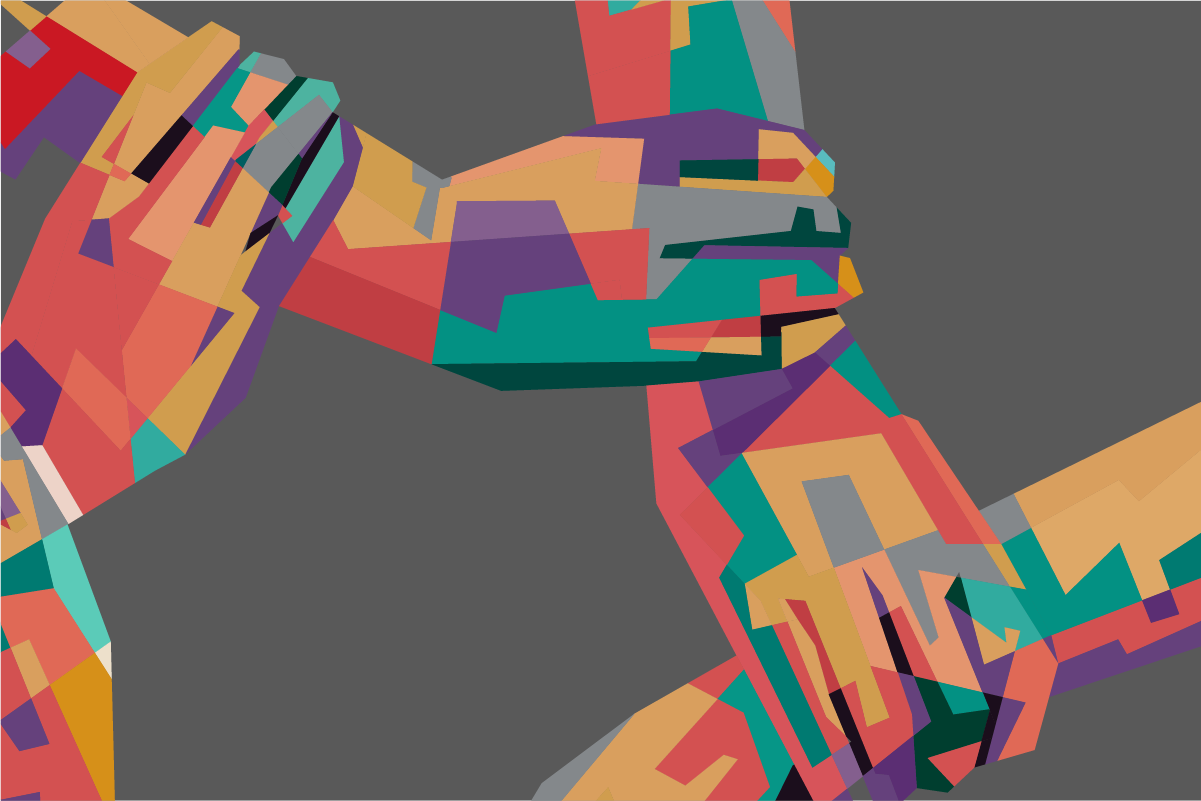
Joy enriches. As a connector, joy helps realize the 'we' and nourishes the 'us' that directs how we gather, steers how we imagine, and inspires what we create.
This year, joy guided our work alongside young people, nonprofits, government agencies, school communities, research institutions, game developers, subject matter experts, and learning experience designers. With teens and our partners, we built knowledge, shared knowledge, and co-designed transformative experiences for teens supportive of their learning, mental health, and thriving.
Throughout 2023, partnership propelled impact and possibility, helping us and those we collaborated with expand it in places where teens learn and play. Collaboration and community-building were consistently parts of all we did this year— from our co-design sessions that led to co-created games and learning experiences to the conferences and panels we were part of. In togetherness, we pooled strengths with teens and others. We leveraged the diversity of our experience and expertise and those we merged genius with to accelerate progress toward the world we each yearn—one where young people have the tools to live full, safe, healthy, and purposeful lives. It was amazing.
In celebration of what the year has been and all that is to come, here is a look back on eight joy-filled memories in no particular order, as well as our favorite collaborative moments, and unforgettable highlights from 2023:
#8. PLAYTESTING CADENCE FORD AT PLAY NYC
At Playcrafting's Play NYC this year, an event that magnified the power of play and brought hundreds of game industry professionals, indie game developers, and game designers together to exhibit their games to players and peers, we shared an iteration of Cadence Ford, the single-player, text-based strategy game we created with the One Love Foundation and Playmatics, LLC.
 |
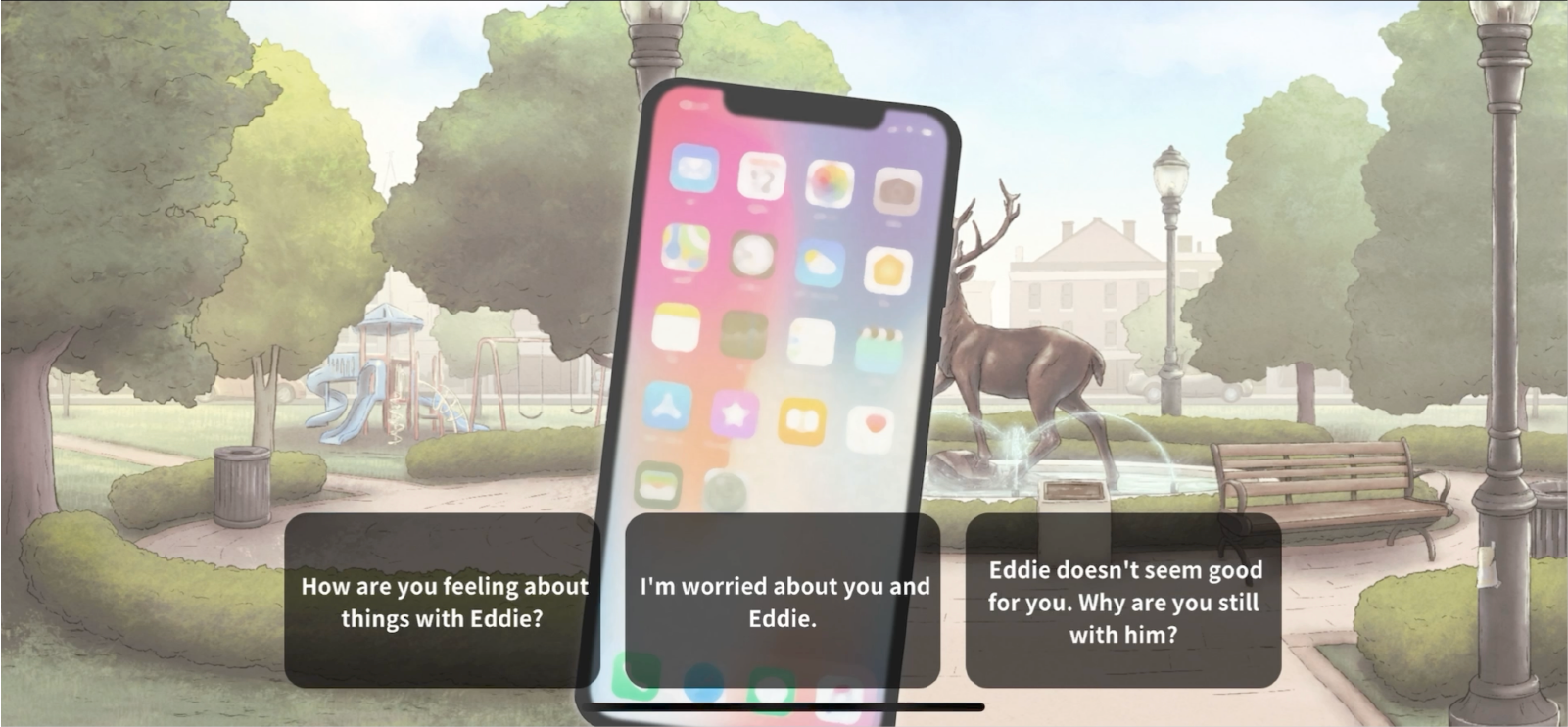 |
Building on One Love's mission to empower young people with the life-saving prevention education, tools, and resources they need to see the signs of healthy and unhealthy relationships, Cadence Ford supports young people in learning to love better, in being with partners who practice healthy Love and communicating with loved ones who are in unhealthy relationships. While New Yorkers of all ages played the game demo and shared feedback, teens, many of whom went on to become members of our Teen Hub, were particularly moved by the game's storyline, mechanics, and captivating 2D art. Read about Cadence Ford's co-design process and the forum for listening to and learning from young people we created at Play NYC.
#7. OUR CO-DESIGN WITH TEENS AT THE NEW YORK HISTORICAL SOCIETY
For the students from Thomas A. Edison High School who gathered at the New York Historical Society with us, History Co: Lab, a graphic notetaker, and others in Educating for American Democracy (EAD)'s network in November 2023, the co-design workshop presented an opportunity rare in their worlds—a chance to share how they envision democracy and impact civic learning that supports the future of it.
Our Game Design Studio model at the center of the co-design experience engaged them not just as students at the end of learning experiences but also as thought partners in co-designing them, setting the stage for meaningful co-creation. The teens, who ended up devising and developing a prototype for a new interactive EAD-inspired card game created to inspire high-quality civic learning experiences by the end of the workshop, called it "promising," "progressive," "unique," "revitalizing," and "relief." Read how the model brought many across the civic education ecosystem together and what came of the teens' collaborative experience.
#6. THE LAUNCH OF OUR DESIGNING FOR TEEN THRIVING MAILING LIST
Impact-driven nonprofits, youth-serving programs, and government agencies trust us to preserve their commitment to teen wellness and thriving.
This year, we launched Designing for Teen Thriving, a mailing list that gives people like them access to the resources and insight of iThrive's game designers, learning experience designers, and teen social and emotional development experts. Subscribing to the list helps individuals looking to create developmentally nourishing experiences and wellness-supporting games for teens (with us or on their own) ensure what they create meets young people where they are and supports their thriving.
Join the Designing for Teen Thriving mailing list today!
#5. THE SOFT LAUNCH OF DISASTER MIND, AN ITHRIVE SIM GAME MADE WITH FEMA
The work of disaster preparedness, response, and recovery is as emotional as it is manual. Disaster Mind, the single-player simulation game built on the iThrive Sim platform with Federal Emergency Management Agency (FEMA) Region 8, supports young people's understanding of it.
This year, the FEMA Region 8 team soft-launched the game after one and a half years of development.
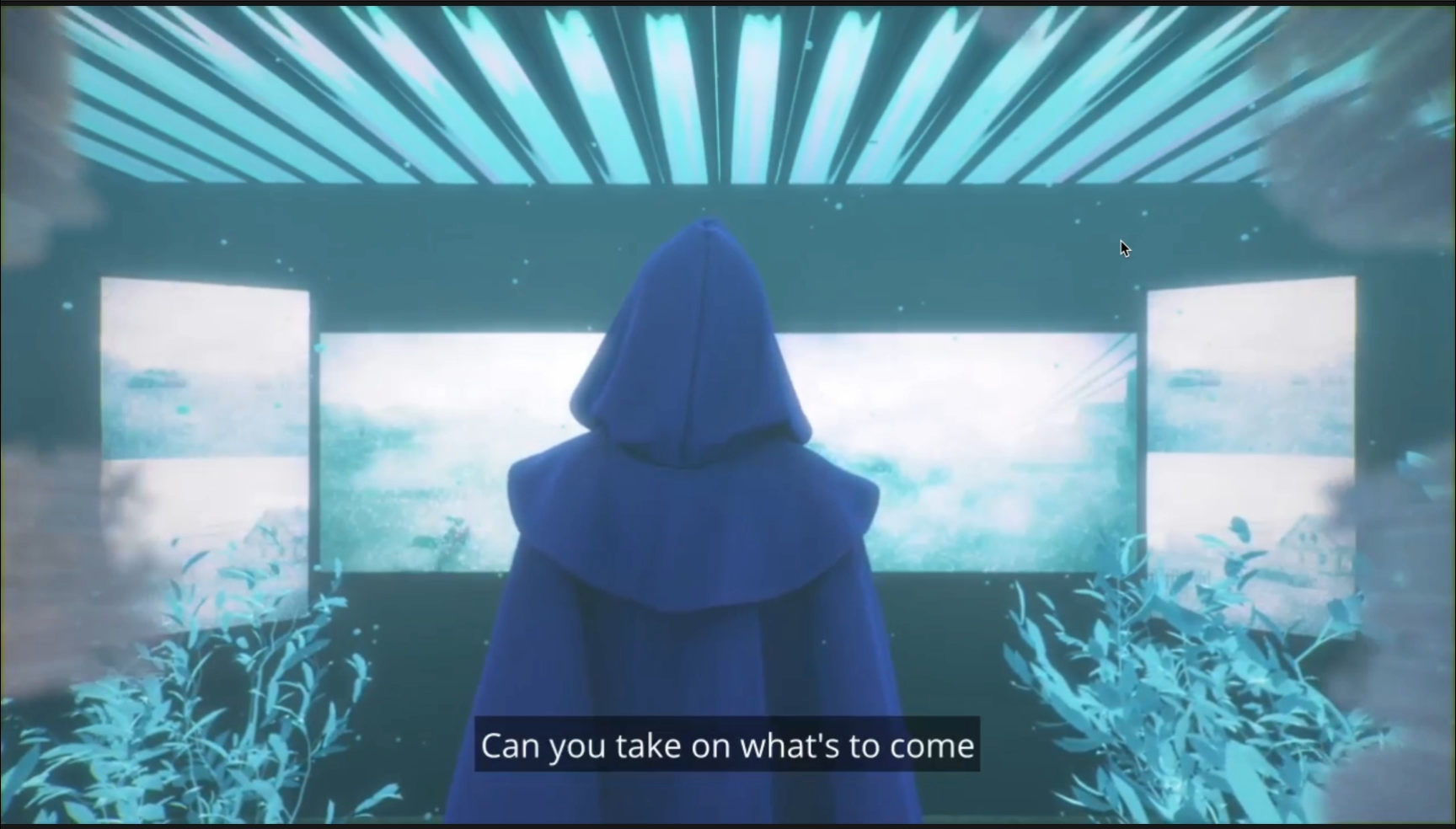 |
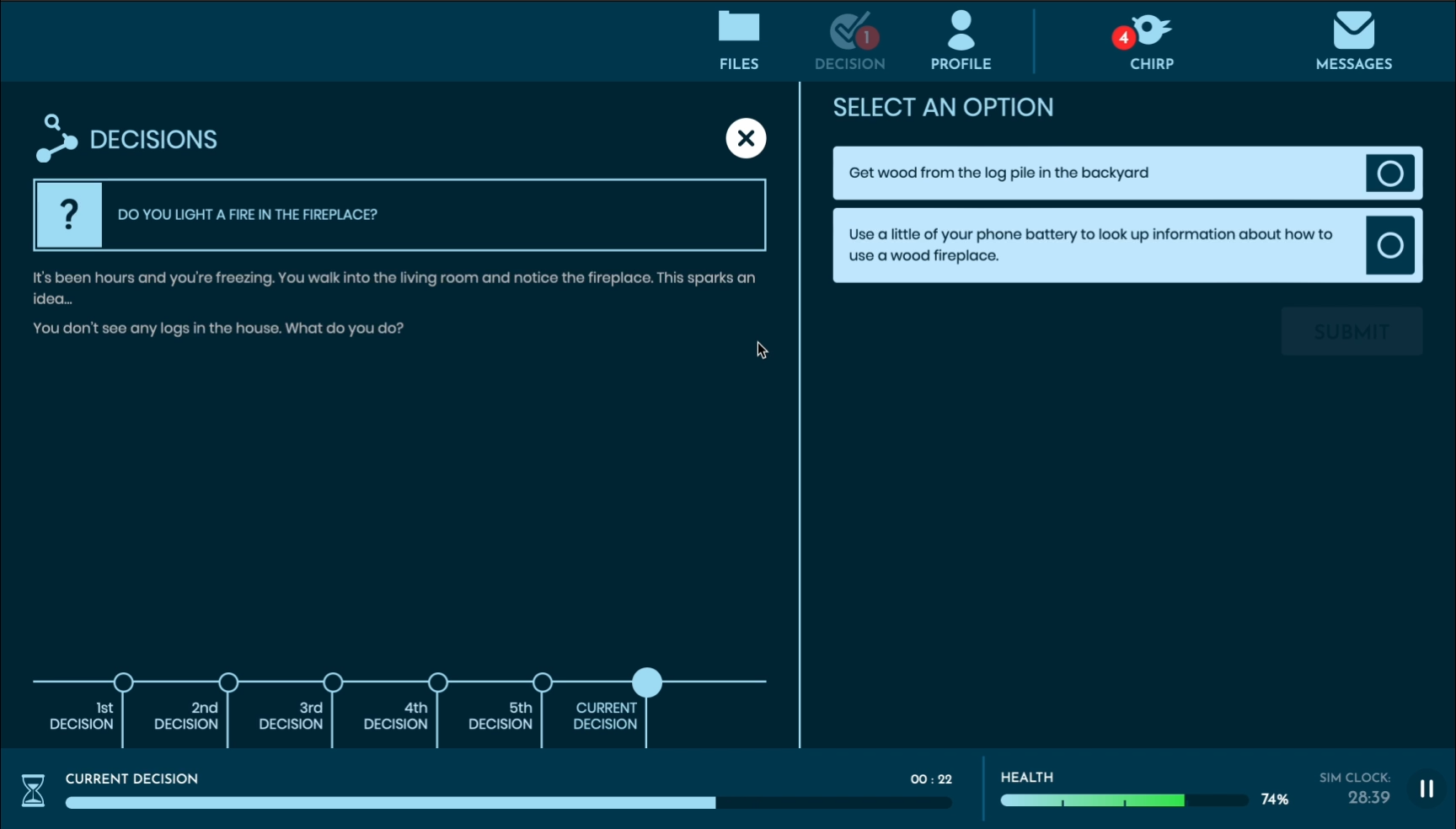 |
Young people who've playtested the game have reported feeling more confident in preparing for an emergency, managing the associated stress, and understanding the intentional mindset that underpins disaster preparedness. Many also have relayed plans to turn their awareness into action, mentioning specific disasters and sharing plans to talk to their families about exit plans, emergency kits, and meeting locations. Dive into the Disaster Mind's co-design process and explore what teens had to say about its readiness and resilience-building play experience.
#4. OUR CO-DESIGN WITH H.S. STUDENTS FROM THE GLOBAL NOMADS GROUP
Also this year, as part of an exciting learning experience design project currently underway with History Co: Lab and the XQ Institute, members of the iThrive Games team had the opportunity to gather virtually with high school students from the Global Nomads Group across two co-design sessions.
True to our norm of iterating for impact, the young people, hailing from several countries across the world, met with us to go over parts of the game-based, social and emotional skill-building experience we're creating, lending their ideas, feedback, and expertise to make it as engaging, accessible, inclusive, and resonant as possible. The play-filled meetings featured icebreakers, stretches, constructive questions, and Jamboards. It was an honor to learn from them while supporting their design thinking in the connective experience.
#3. ITHRIVE SIM NAMED A LEARNING ENGINEERING TOOLS COMPETITION WINNER
This year, the iThrive Games team was named one of the 32 winners of this year's Learning Engineering Tools Competition, selected from over 1,000 edtech innovation proposals submitted worldwide.
The win and accompanying $100,000 Growth Phase award in the Transforming Assessments track enables our team to expand iThrive Sim, our playful engine that hosts, powers, and evaluates immersive and interactive role-playing simulation games, with new ways to measure and assess the teen social and emotional learning fostered in them while developing alongside others in the growing learning engineering discipline. We are honored to share this win with our software development partners at Affordance Studio and EdTech Recharge's Kripa Sundar. Learn more about the Tools Competition and the expanded iThrive Sim to come.
#2. THE CONFERENCE CONNECTIONS
Attending game-filled, educational, and ed-tech conferences was an absolute favorite for us this year.
At Games for Change, we learned tons from designers, researchers, and changemakers, and at ED TECH WEEK NYC, we explore how tech innovation continues to support access, learning, and workforce development.
Members of our team also had the opportunity to showcase our co-designed games at ED Games Expo and PLAY NYC and lead discussions elsewhere too. In March, as part of MA Civic Learning Week, we shared on iThrive Sim's transformative civic learning games for high school classrooms. At ASU+GSV Summit in April, our Executive Director and Chief Scientist Susan Rivers talked about the necessity of social and emotional skills in today and tomorrow's careers on an American Student Assistance panel alongside others invested in the thriving of this generation's learners. At NSLA's Summer Learning Summit in October, she joined the Education Innovation Stage with other thoughtful experts to discuss learning and youth development that can inspire, challenge and deepen summer learning.
Each space we shared with others was carried by joy and animated by an eagerness to connect and collaborate with others eager to merge genius and create better systems of care and learning.
#1. OUR CREATIVE COMMONS-LICENSED, GAME-BASED LEARNING LIBRARY
Access enables impact. This year, we opened access to our game-based, social and emotional learning educational resources by licensing them under Creative Commons. Educators and teen-serving adults who care deeply about young people's thriving can merge it with their work and expertise.
Each iThrive Curriculum unit, iThrive Sim curricular surround, iThrive Game Design Kit, iThrive Game Guide, and iThrive-authored PDF resource can be remixed, redistributed, and built upon. Dive into them!
Whether you're a teen who co-designed or playtested with us, a partner or collaborator who co-created with us, an educator who brought our resources to your students, a game designer who used our game-making resources, or a supporter who read our blogs and cheered us on, we appreciate each of you for the many ways you engaged with us this year. A heartfelt thank you for sharing in our vision of teen learning and thriving, and happy new year to you and yours!
Make It A Gameful School Year: Meeting Teens Where They Are With Play
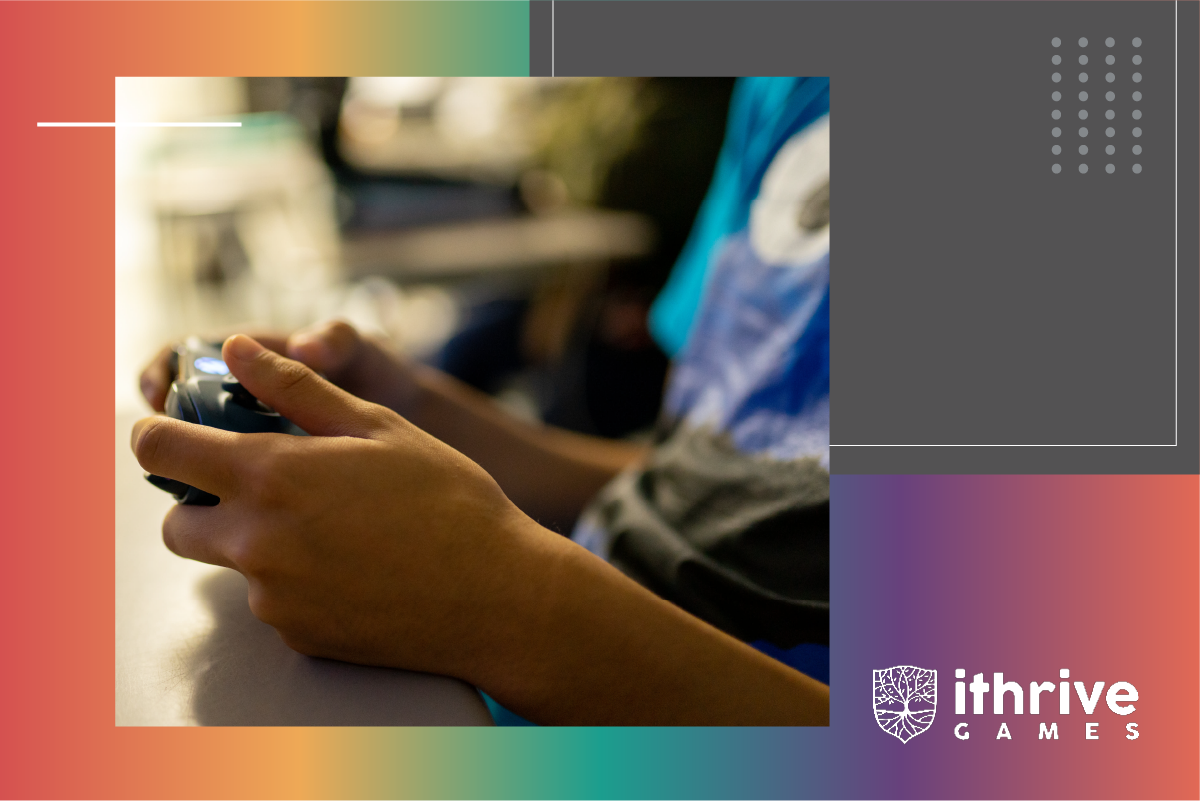
"I'm always going to enjoy a lesson where you can learn and have fun... It helps keep the students focused and even helps motivate them. I know I'm motivated to find out what happens next," shared a high school senior who, along with peers in his humanities class, was one of the first to gather around an Xbox One, play What Remains of Edith Finch, and meaningfully learn from it using our iThrive Curriculum unit, Museum of Me.
Games like What Remains of Edith Finch merge mechanics, worldbuilding, and challenges to deliver emotional and immersive experiences to all who play them. For the 85% of teens in the United States who play them (International Journal of Mental Health and Addiction), they are a solid and steady source of joy, connection, and entertainment.
At iThrive Games, we see the curiosity, embrace, and eagerness activated in teens by a never-before-seen start screen as a launchpad for social and emotional learning (SEL)—a transformative skill-building practice proven to protect and promote their mental health. Our team folds in what we know about the transcending and emotion-evoking power of games into a unique multidisciplinary, user-centered, and participatory approach that brings teens, researchers, game developers, and our adolescent development experts to the table to envision, create, and test tools that support teen thriving.
The games and game-based learning experiences we've co-designed alongside libraries, museums, schools, and youth-serving organizations we work with fully recruit the feelings conjured through play to create a wellness-supporting experience that centers teens' social and emotional needs. We use play to bring SEL to young people in a developmentally responsive way with games that invite them to uncover and nourish their strengths, craft and answer their own questions—activities that expand their understanding of themselves, others, and the world around them.
Beyond enthusiasts, we are ambassadors of play. Our team's first-hand witnessing of what games do (and can do) over the last five years has affirmed our belief in their unique capacity to support young people's thriving. We fully encourage educators, program coordinators, and all working with teens this school year to bring them into the spaces they share with them to see the power of play first-hand, too. Keep reading for resources, recommendations, and insights that support the integration of games in teen-serving settings and their use in teen-centered ways.
WHAT PLAY DOES (AND CAN DO) FOR TEENS
Play is beneficial for all of us, but for teens especially. Here are five things play does for young people, and can support, enable, and elevate when brought into the spaces where young people gather and learn:
Play activates deep learning and personal growth. Games present opportunities for teens to engage interactively and think expansively. Environmental storytelling coupled with mechanics that govern and guide the player's actions and the game's response to them give way to an experiential context where teens build knowledge while exercising personal agency—the conditions for deep, meaningful learning. "Games offer teens the ability to fully inhabit the world of a video game, to embody characters with agency along with the chance to impact the world and characters around them," shares Susan E. Rivers, PhD, iThrive's Executive Director & Chief Scientist. "They offer the agency and low-risk experimentation that teens rarely get but sorely need to discover who they want to be."
Play supports social and emotional development. Games make us feel. They delight us, challenge us, calm us, frustrate us, and excite us. They can prompt problem-solving, conflict resolution, and empathy, provoking opportunities that support teens' social and emotional learning. Social and emotional learning is defined by the Collaborative for Academic, Social, and Emotional Learning (CASEL) as "the process through which all young people and adults acquire and apply the knowledge, skills, and attitudes to develop healthy identities, manage emotions and achieve personal and collective goals, feel and show empathy for others, establish and maintain supportive relationships, and make responsible and caring decisions."
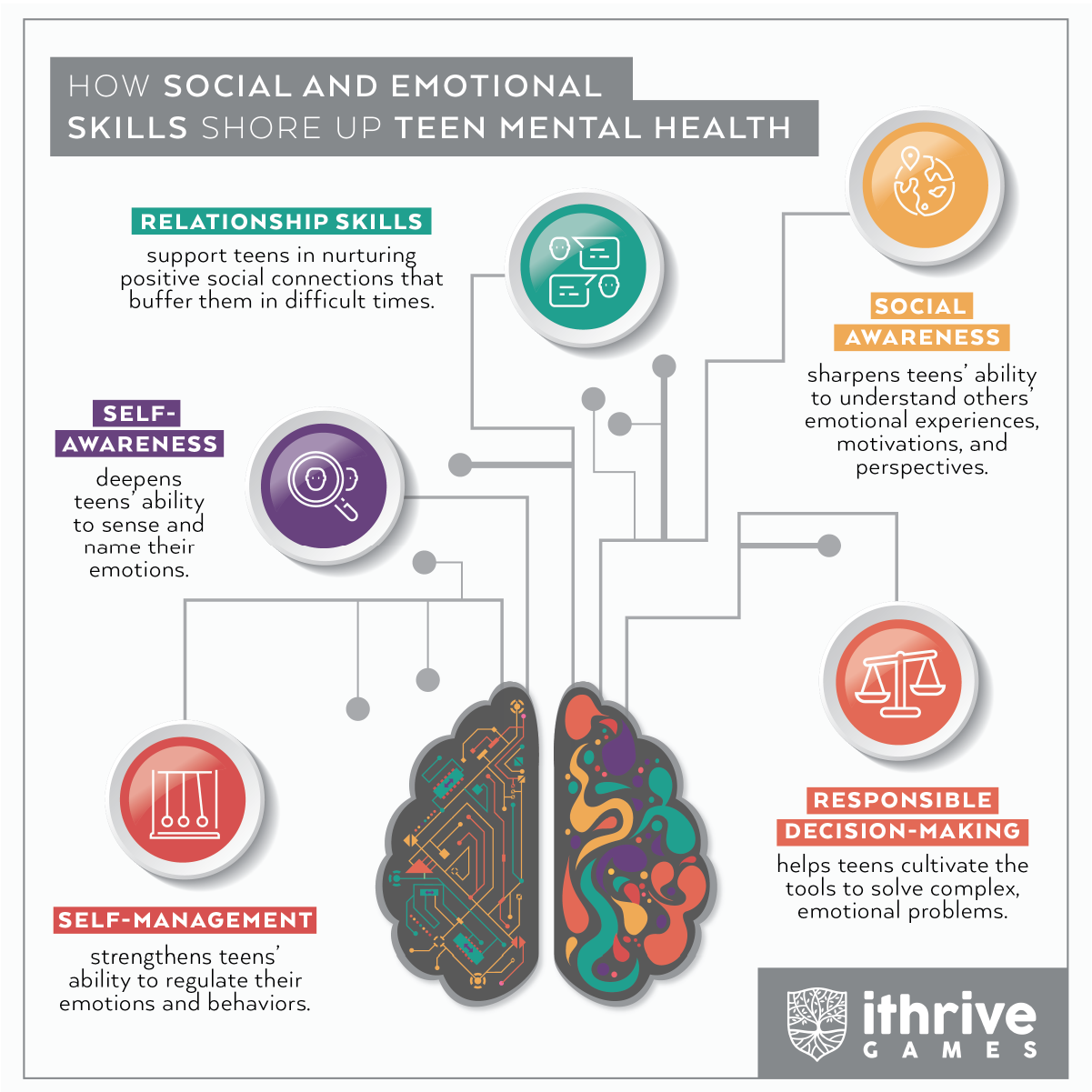
"How Social and Emotional Skills Shore Up Teen Mental Health." iThrive Games. https://tinyurl.com/what-sel-does-for-teens
Games provide a social space ripe with opportunities for young people to lean into these tasks, as well as developmental ones like identity exploration, establishing and exercising independence, and finding their place in community.
Play soothes. Games transport and immerse teens in new worlds, and with the space to interact as a new character and confront conquerable challenges comes the opportunity for stress reduction, self-gratification, and flow states. In countless co-design sessions with teens, we've heard that games are an outlet for relaxing and unwinding, providing a constructive space for coping, breaking for a bit, and pressing pause in challenging moments.
Play fosters connection. When teens play with peers, be it competition or collaboration, they socialize and connect, tasks paramount to their mental health. In the connective spaces games offer, teens can share their triumph and joy with others. They can work together toward a shared in-game goal and, sometimes, tackle the fallout of a shared loss in powerful bond-building experiences.
INTEGRATING PLAY WHEREVER TEENS LEARN AND GATHER
The work of adolescence has always been social and emotional, and young people need tools and strategies to help them navigate it. What games do for teens make them a useful means of support, and when enlisted by adults in their world as a medium of engagement, they are further solidified as valuable parts of young peoples' toolkits.
For all looking to leverage the power of play this school year while in community with teens, here are three ways to do so:
1. Pull in a game-based learning curriculum, or create your own.
Game-based learning supports educators in using the power of games to define and support their students' learning outcomes. When lesson plans leverage video games—an entry point familiar to most teens—they pave the way for a culturally responsive learning experience supportive of innovative thinking, deep learning, and in the case of our standards-aligned iThrive Curriculum units, A Moment in Time, Museum of Me, and Sam's Journey) that center themes relevant to teens like navigating identity exploration, relationships, and social media, their social and emotional development too. For educators who value accessibility also, game-based learning aligns with Universal Design for Learning principles. As a stark differentiation from traditional learning approaches, games help educators reach and engage teens with a practice that acknowledges that teens are vast and wonderful, engaging with concepts from different access points. Here's how to choose a video game for a high school humanities or English class and a case example of how iThrive Games does so.
2. Employ role-playing simulations to support a 'learn by doing' approach.
Role-playing simulations engage teens in a high-energy experience with hands-on learning as they are challenged to strategize and act. Multiplayer ones, particularly, invite them to interact and investigate with each other and pursue shared goals. The embodied learning accompanying the role-playing propels their curiosity and motivation to explore possibilities transferable to real-life contexts.
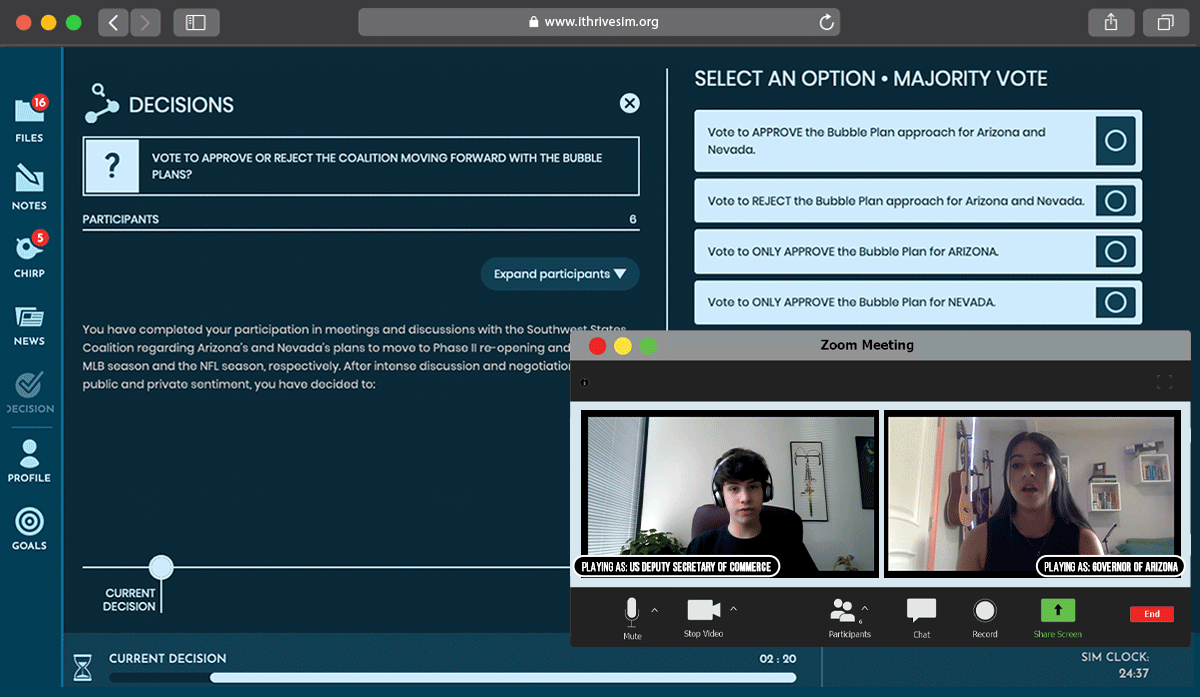
High school students playing iThrive Sim: Lives in Balance. See the gameplay in action here.
The simulations offered via iThrive Sim, our award-winning simulation platform that hosts dynamic role-playing games that scaffold educational content with social and emotional skill-building activities, encourage teens to learn by doing. Each one in our core civics library (Lives in Balance, Leading Through Crisis, and Follow the Facts) invites teens to play alongside their peers, prompts them to draw on their own experiences and their social and emotional skills while making decisions, demonstrate critical thinking, acquire and interpret information, and navigate challenges collaboratively. Dive into the social and emotional skill-building and civic learning that happens in each iThrive Sim game experience here.
3. Unleash teen creativity by inviting them to be game designers.
Why? As teens progress through adolescence and develop their capacity to reason thoughtfully and think critically, this three-letter question becomes all the more important and prominent in their lives. The cognitive growth teens undergo propels them to investigate the 'whys' that shape how they live and see their world. They move from thinking concretely and heavily relying on physical observations to thinking abstractly about possibilities. In this last major phase of development, where teens are primed to learn and adapt, curiosity becomes a growth point, and game design uniquely nurtures it in them. Our Game Design Studio Toolkit, developed in collaboration with EdTogether, sandbox games like Minecraft, and game-making tools like Roblox, provide teens with a springboard for unpacking complex challenges, investigating questions, and stepping fully into their creativity.
Games are unsurpassed in their ability to engage teens in physical and virtual worlds deeply. They offer teens a safe space to wander and wonder, exercise their innate curiosity, and build new understandings of themselves and each other. When used as a medium for engaging with young people in the spaces where they gather, they become more than entertainment—they become levers for social and emotional support.
How are you using play this school year? Let us know on Twitter by tweeting us @iThriveGames using the hashtag #GamesforThriving, and stay updated with our game-based resources and game design work, done with and for teens, by subscribing to our monthly newsletter.
We Asked Gamers About Their Hard Days at Play NYC. Here’s What We Learned.
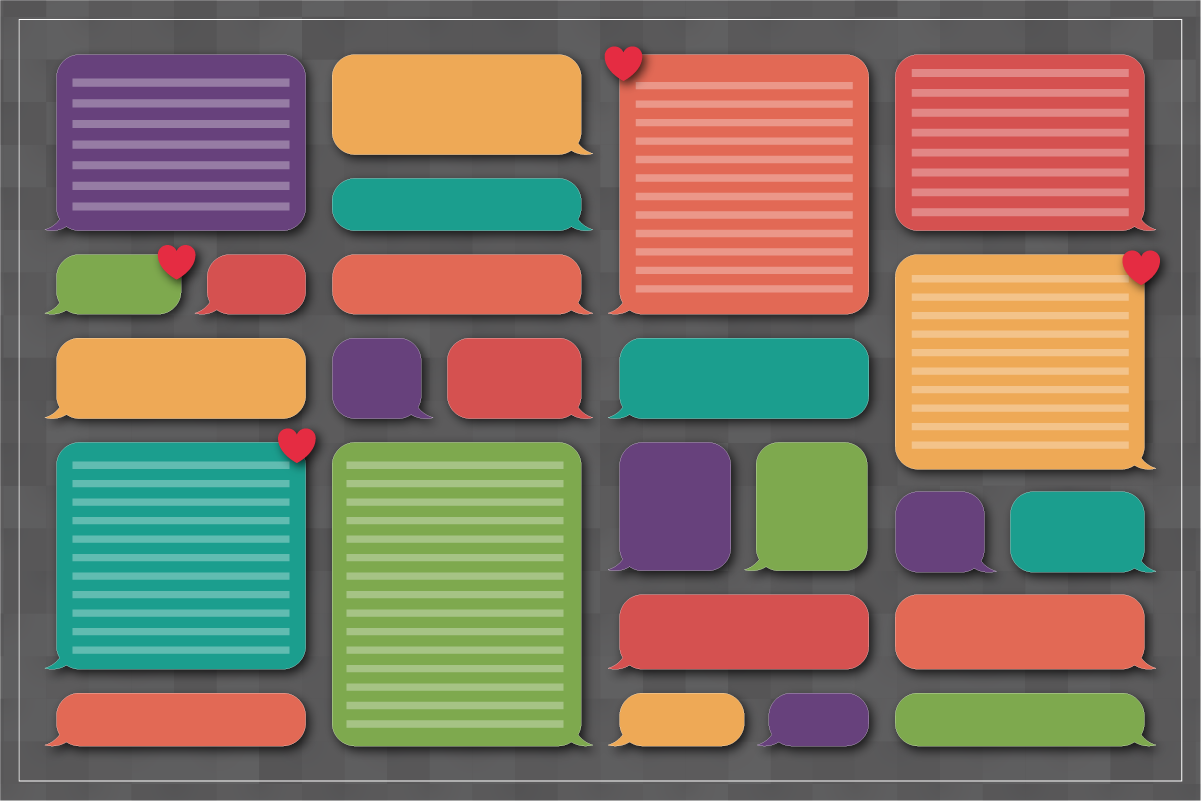
Our ability to feel is what makes us human. It is fundamental to who we are, underlying how we connect and the realities we co-create.
It supports our sense of self, helping us unpack our thoughts and reactions, build awareness of what's happening around us, and deepen our knowledge of ourselves in relation to the world we live in.
Games make us feel. They delight us, challenge us, calm us, frustrate us, connect us, and excite us. They're also uniquely captivating, not just in what they portray aesthetically and demand mechanically, but because of the state of embrace they insist on those who play them. Encountering a never seen start screen or the unopened box of a new tabletop game, we are ready, willing, and receptive to knowledge. Play's ability to get us to put our guard down, be curious, and engage with new possibilities helps create the conditions for transformation and meaningful learning.
Earlier this month, the iThrive team showcased at Playcrafting's Play NYC—an event that magnified the power of play and brought hundreds of game industry professionals, indie game developers, and game designers together to exhibit their games to players and peers. There, we shared Cadence, a single-player, text-based strategy game we created with the One Love Foundation and Playmatics, LLC. Cadence invites players to explore three of their friends' stories and converse with them via real-time dialogue choices that affect their friendships and outcomes. Building on One Love's mission to empower young people with the life-saving prevention education, tools, and resources they need to see the signs of healthy and unhealthy relationships, Cadence supports young people in learning to love better, in being with partners who practice healthy love, and communicating with loved ones who are in unhealthy relationships. While New Yorkers of all ages played a demo of the game and shared feedback, teens, many of whom went on to become members of our Teen Hub, were particularly moved by the game's storyline, mechanics, and captivating 2D art.
Beyond the valuable feedback we received on Cadence, slated for release later this year, the experience provided another opportunity for our team to create a forum for listening to and learning from young people. At PLAY NYC, we marked a large glass bowl with the question, "What makes you feel better on your hard days?", and teens and young adults anonymously shared the following:
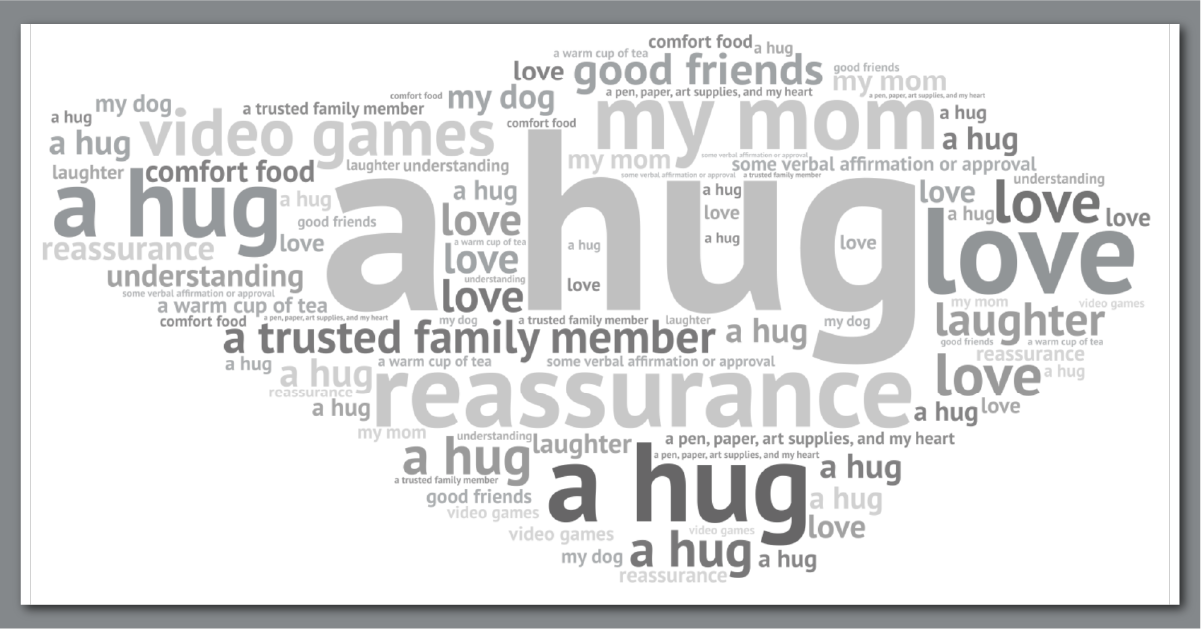
ARE WE LISTENING?
Tucked in each of these answers is a guidepost for innovation—caring, joy, connection, self-expression. Creating safe spaces where teens are heard and listened to with the intent to understand them has guided our game development and experience design work over the last five years, and empathic listening and design is what has made the impactful play experiences we've designed with and for teens possible. The needs echoed and desires illuminated in the responses we elicit from young people in the safe spaces our social and emotional learning experts create (in this case, a glass bowl, and lime green Post-it notes) are folded into the game concepts we envision with clients and collaborators
Empathic listening has long been a driver of breakthrough thinking. Being in community with teens and young adults has helped us think expansively and collaboratively. We've found that empathy, when practiced consistently, is essential to transformative change and central to the knowledge-building and knowledge-sharing that informs the design of meaningful solutions.
iThrive's co-design approach, which gives teens the tools to step into their genius and explore their needs, is care in action. Our approach creatively empowers young people with new ways to tap into their genius, share their experiences and wisdom with others, advocate for the support they deserve, and create with us the experiences they want to see.
With the Centers for Disease Control and Prevention (CDC) reporting that nearly half of U.S.-based high school students are experiencing persistent feelings of sadness and hopelessness, it is on all of us in the game design ecosystem to create the spaces, in person and digital, to listen and effectively gauge the thriving of end users. With over 90 percent of teens and young adults self-identifying as gamers, every game designer, developer, and writer has the tools to meet them where they are and equip them with valuable knowledge, tools, and support. It is on all of us always to ask, "Are we listening?"
ARE WE SUPPORTING?
The learning that comes from listening allows all designers and developers to respond constructively, and offer support in meaningful ways. Games are already socially and emotionally valuable, and when tailored to teens and young adults' strengths, developmental needs, and insights, they become vessels for further social and emotional support.
Our adolescent development experts work with and for young people, and in partnership with libraries, museums, government agencies, and organizations that care about them, fully recruit the feelings that play evokes to support teens' social and emotional health. The science of adolescence and evidence-based practices that support positive teen growth are folded into the games, game-based tools, and interactive learning experiences we create. Questions like "How does this enliven teens to practice healthy skills like exploring their identity, engaging with their community, and taking purposeful action in the world?"; "How does this invite teens to regularly notice emotions, helping them notice the thoughts, sensations, and behaviors that accompany their feelings?"; or "How does this normalize help-seeking?" steer the game development process we lead, ending in a play experience that nourishes young people in ways supportive of their wellness, learning, and thriving.
At Play NYC, we shared questions like these on a printout version of our 10 Things to Know When Designing for Teens resource, given to other game designers and developers eager to go beyond listening and to start responding and supporting young people's social and emotional needs. We're happy to now make that resource accessible to everyone and downloadable via the Resource Hub on our website.
Asking and listening helps us understand people and ideas. That insight and evidence-based practices nudge us toward wellness-supporting games and more impactful play experiences for young people. For the design team or studio looking to elevate the impact of the games they create for young audiences, connect with us today for a consulting report benchmarking your game in development against the science and sharing recommendations on ways to fold in social and emotional skill-building—a practice proven to protect and promote teen mental health.
Together, we can and should advance wellness wherever young people are. Join in.
Co-Designing Wellness-Supporting Games with and for Teens
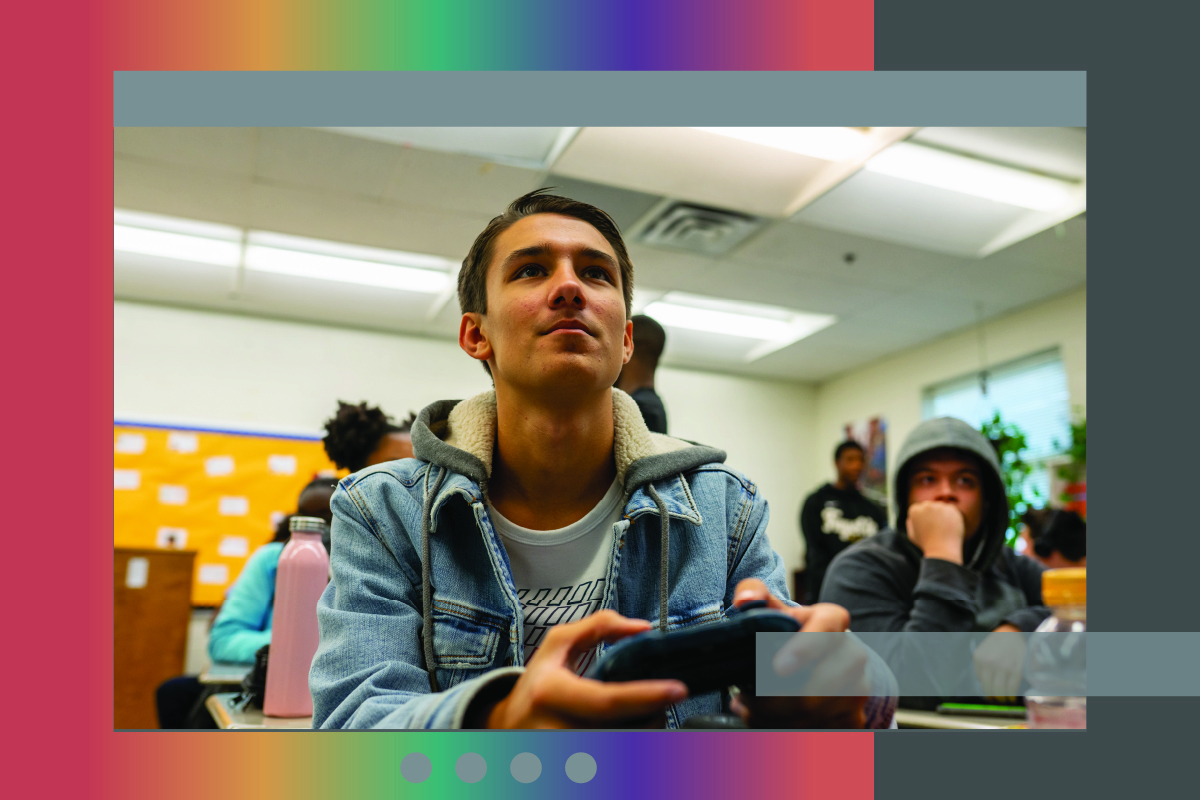
The work of adolescence is a social and emotional lift. Too often, adults in teens' worlds forget that, choosing to define young people by their vulnerabilities in an increasingly tumultuous world rather than by the magnificence they embody every single day to navigate it.
Doing teenhood in today's world is unparalleled to previous experiences. Mental health outcomes in young people have worsened with the prevalence of social media and the life-altering changes brought forth by the pandemic. In March 2022, the Centers for Disease Control and Prevention officially declared a youth mental health crisis.
There is a role that each of us in the game design world can play to help create and positively contribute to the ecosystem of support that teens need to live healthily and thrive.
Our 10 Things to Know When Designing for Teens resource, available exclusively to our Designing for Teen Thriving newsletter subscribers, shares insights and guiding questions crafted by iThrive's adolescent developmental experts that help designers center teens' strengths and vulnerabilities in the experiences they create for them.
What follows are two case examples that capture how iThrive's collaborative game design work has applied the resource's insights to create impactful play experiences. The science of adolescence paired with our unique co-design model have made each of the games highlighted here a springboard for social and emotional skill-building, connection, and exploration.
ITHRIVE GAMES' CO-DESIGN MODEL
Teens demand our care and commitment. At iThrive Games, our co-design model with teens is care in action. The model, devised by teen mental health and learning experts, equips teens with cognitive and creative tools that help them step into their genius. By centering teen magnificence with its strengths-based approach, iThrive's co-design model sets the scene for teens to feel safe to share their thoughts and experiences, heard about the issues they care about, and challenged to think through solutions with their peers and subject matter experts. It revolutionizes standard focus group setups and UX research strategies with immersive, hands-on activities, creating a supportive, teen-centered context for discovery. As a core part of the collaborative design approach we bring to our clients and partners, iThrive's co-design model is a throughline in these case examples.
CASE EXAMPLE #1: DISASTER MIND
![]()
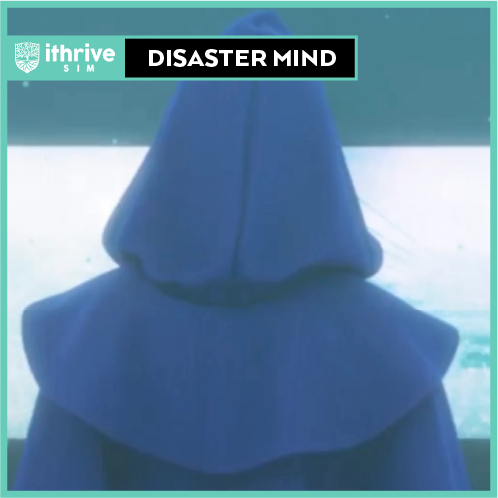 |
 |
Severe weather events over the last few years prompted the Federal Emergency Management Agency (FEMA) to explore new ways to prepare communities in times of crisis. In late 2021, FEMA reached out to iThrive Games, fully understanding that young people would be integral to their efforts. As positive influencers, teens are uniquely capable of bringing the message of disaster preparedness to friends, families, and communities. Disaster Mind, a single-player web-based game launching later this year, equips teens with vital emergency management skills and knowledge, training and activating them to be prepared for natural disasters.
Last year, the United States experienced 18 natural disasters, including winter storms, cold waves, heat waves, floods, droughts, tornado outbreaks, and three tropical cyclones. The intensity and frequency of these incidents firmly establish it as a stressor in the lives of teens, especially the ones living in areas more vulnerable to natural disasters. Disaster Mind offers teens an immersive, readiness and resilience-building experience that will help them develop and practice skills to respond to the need for ways to cope with and navigate natural disasters.
To create a Disaster Mind we drew on our evidence-based 10 Things to Know When Designing for Teens design principles. One insight is that teens are still learning to control impulses and emotions. With connections still developing in their prefrontal cortexes, it is relatively more challenging for most teens to gauge the consequences of their actions than it is for most adults. Another is that teens are also facing a lot of stress during their adolescent years and need flexible ways to cope and navigate the stressors they contend with in their daily lives.
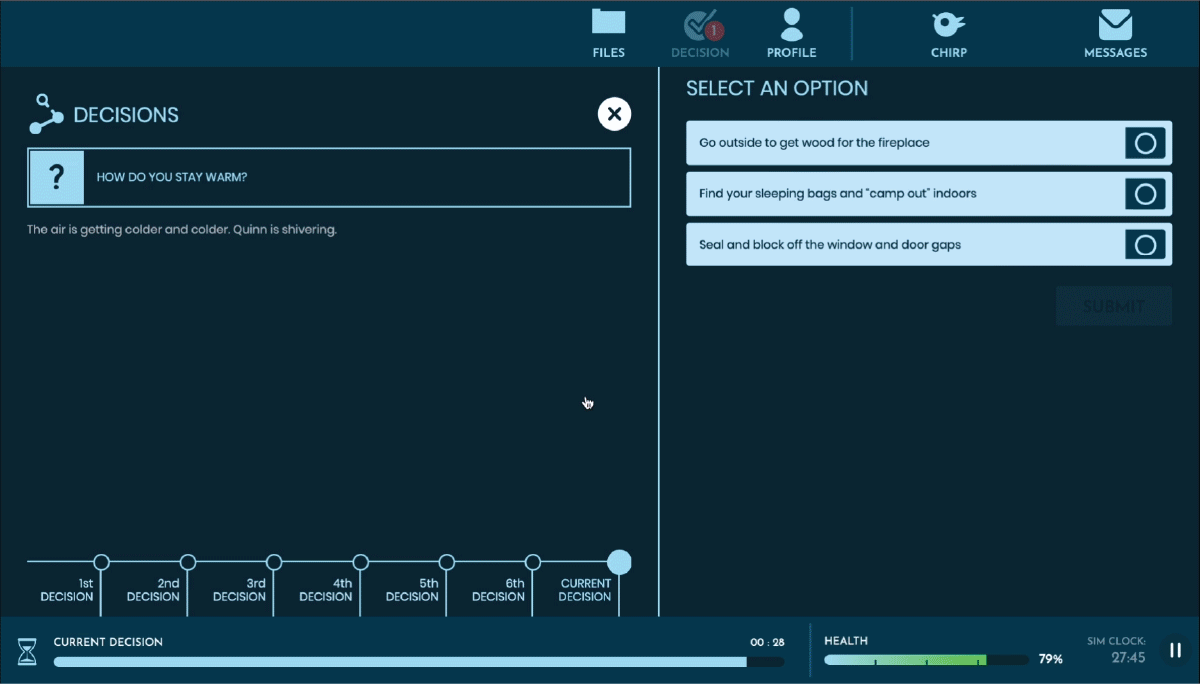
Hosted on iThrive Sim, a platform that authors and hosts playful, social, and emotional learning experiences, the game's storyline and mechanics work together to help players notice the connections between their emotions, thoughts, sensations, and behaviors as they make decisions while immersed in a crisis. With each decision impacting how the game unfolds, teens also practice responsible-decision making and self-management.
True to our co-design model, Disaster Mind was created with emergency management experts at FEMA Region VIII, which serves 29 Tribal Nations, Colorado, Montana, North Dakota, South Dakota, Utah, and Wyoming, and teens from those states who each helped inform the game's learning outcomes and story elements. Their wisdom and contributions highlighted a deep concern for their pets, a wishful desire for coordinated plans, and a need for strategies that combat feelings of loneliness and helplessness. These insights and wisdom were folded into Disaster Mind to ensure it reflects how teens frame challenges. By doing so and tactfully responding to teens' developmental needs, Disaster Mind delivers a resonant, teen-centered play experience that helps all who play it understand that stress management skills, the right mindset, preparation, and essential conversations with family and community members can prevent an emergency from becoming a full-blown catastrophe. "An engaging simulation is a fantastic tool for laying down the mental pathways we need to activate in times of crisis," shares Daniel Nyquist and Stephanie Poore from FEMA Region VIII. "That's why we are thrilled to be designing a disaster preparedness simulation with the iThrive team. iThrive's unique co-design approach is illuminating how to mobilize young people's creativity and distinct strengths in service of building mindsets and skills needed for resiliency across disaster preparedness, response, and recovery."
CASE EXAMPLE #2: CADENCE
![]()
 |
 |
One in every three young people will have an unhealthy relationship before they become adults. Interpersonal violence remains the third leading cause of adolescent death, contributing to one in every five teen suicides. Founded to honor the life of Yeardley Love, a daughter, friend, and student-athlete whose life was tragically cut short by an ex-boyfriend weeks shy of graduating from college, the One Love Foundation has worked to bring life-saving prevention education to young people over the last thirteen years. In 2022, they approached iThrive Games, seeking to amplify their educational programming with a new medium—a game. From the clear need for more accessible, awareness-building, and preventive interventions to support teens in living full, safe, and healthy lives comes Cadence, a text-based strategy video game launching later this year. The goal of Cadence is to equip all teens who play it with the know-how and skills to have and advocate for healthy relationships.
Our evidence-based 10 Things to Know When Designing for Teens resource guided our creative design choices for Cadence. Teens are working hard to figure out who they are in their adolescent years. To do this self-work productively, they need social spaces to interact, experiment, negotiate, and resolve conflicts safely. Teens also need access to experiences, environments, and relationships that help them grow positively. Cadence, produced by iThrive Games and developed with Playmatics, LLC, responds to these needs by providing a playful, low-risk, and low-stake space where teens can engage in self-work and practice relationship skills.
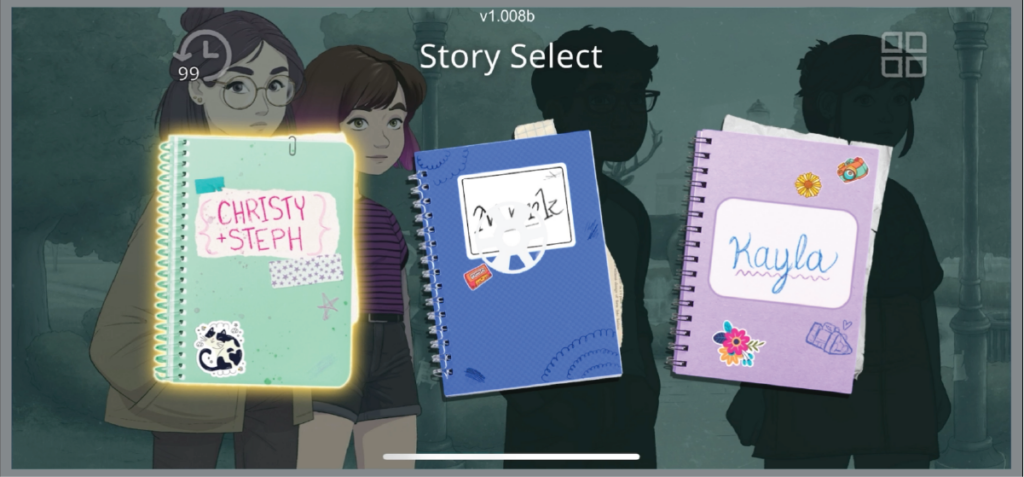
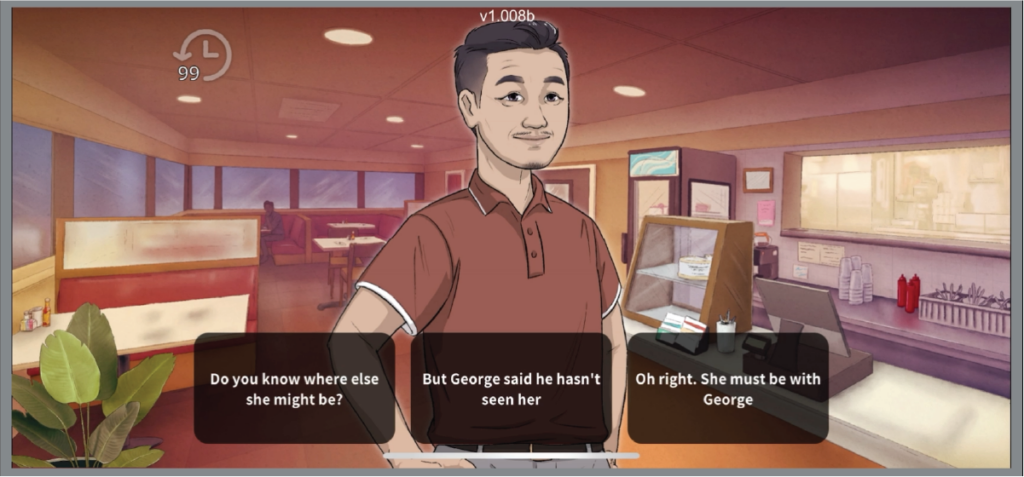
Screenshots from Cadence (beta), currently being play tested by iThrive's teen advisory members and teens in One Love's network.
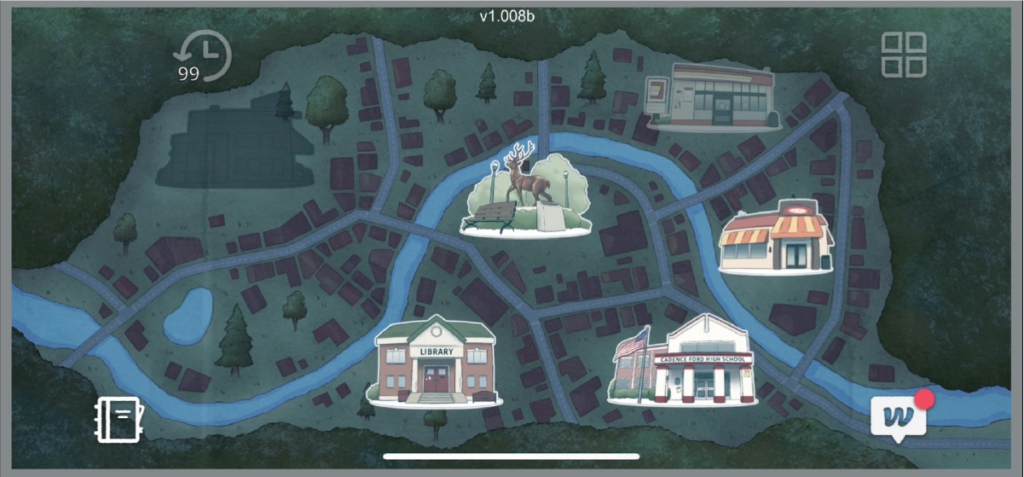
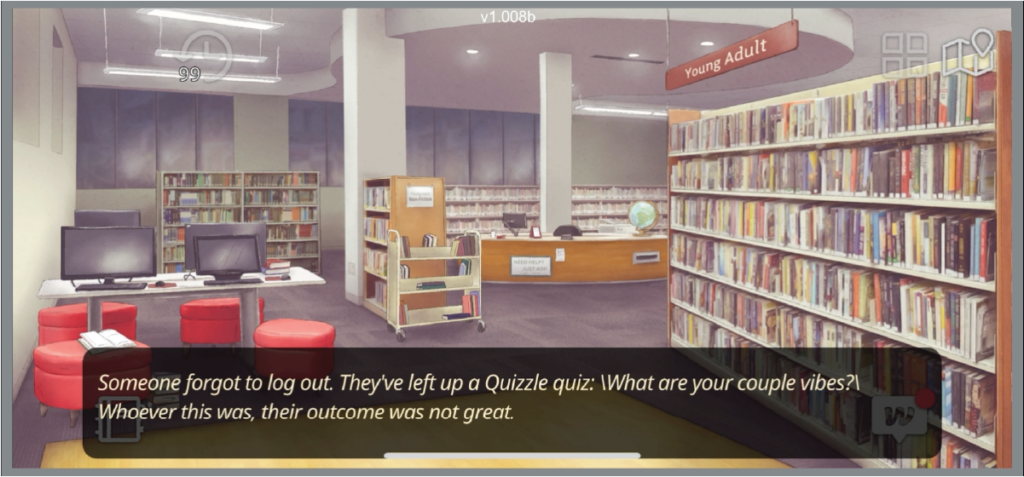
The single-player game invites teens to go back in time and explore critical events in three of their friends' lives. While interacting with each story, players must notice details of their friends' lives and figure out how to talk with them about uncomfortable issues. Meaningful gameplay fosters meaningful learning as teens practice having difficult conversations and familiarize themselves with unhealthy behaviors that may surface in relationships.
As a direct-to-teen experience, the development of Cadence began with iThrive's co-design model, allowing our design team to fold teen wisdom into the playful experience. The co-design process began with group discussions where teens in One Love's network and ours shared their perceptions on the importance of healthy relationships, defined what healthy and unhealthy signs of a relationship look like in their worlds and minds, and explored how they navigate discomfort in the body and in their peer relationships. Ultimately, their insights and ideas along with the science of adolescence,makes Cadence a wellness-supporting experience for players. "Cadence provides a low-stakes space for players to practice supporting a friend navigating an unhealthy relationship while providing the player with life-saving prevention education for themselves as well," shares Megan Shackleton, Chief Program Officer at One Love. "iThrive's co-design model was vital to making this game truly teen-centered - everything from ensuring the interpersonal challenges in the game were reflective of their worlds to the game dynamics being engaging and fun. From iThrive's careful partnership with youth comes a relatable and impactful play experience we're excited to share with the world."
A CALL TO ACTION FOR ALL GAME AND EXPERIENCE DESIGNERS
With 90% of teens self-identifying as gamers, games are an unparalleled lever for accessing and
supporting young people at a critical time in their development. With this access comes the opportunity to empower them with real-world applicable knowledge and opportunities to strengthen and practice social and emotional skills vital to protecting and promoting their mental health.
At iThrive, we're committed to taking part in the knowledge-building and knowledge-sharing that add to the ecosystem of affirmation, love, and support all young people deserve. As we work alongside teens with our clients and partners, we continue to build, share, and co-design our way toward a world where every teen is valued, proactively challenged, and cared for. We're reminded that in synergy, there is impact, and in this shared commitment to teen thriving, there is progress and a horizon full of teen wellness-supporting possibilities to explore.
Our team is eager to support your experience design needs. Share more about your project with us today.
When Museums Design Experiences for How Teens Learn and Develop

The COVID-19 pandemic affected all spaces where gathering happens—museums included.
In the face of unprecedented shifts and challenges, museums innovated and devised new ways to engage with young people safely. iThrive Sim: Lives in Balance, for example, is a tech-powered simulation game we created with the masterminds behind the Situation Room Experience at the Ronald Reagan Presidential Library and Museum to bring forth new digital spaces for teen collaborative learning and play at their museum. The in-person and virtual classroom-optimized experience won a gold American Alliance of Museums (AAM) MUSE Award and a bronze MuseWeb GLAMi Award in 2021.
As museums work to recover pre-pandemic visitation numbers, the opportunity to lean into innovation presents itself once again. Building appeal to teens, who are already deepening their social awareness in informal spaces and are actively engaged in civic discourse, offers a promising pathway for increasing visitation and cultivating a pipeline of lifelong museum supporters and allies in the missions of museums too. Data from the National Awareness, Attitudes, and Usage Study shows that over 60% of adult museum visitors first attended them as adolescents, building the case and design directive for more experiences meaningfully showcasing history to young people. The science of adolescence lends valuable insight that can support the design of exhibits and experiences that are engaging, relevant, and accessible to teens—ones that prepare them for the world they are already asking questions about and are eager to inherit. Centering how teens learn supports museum design teams in building on these entry points meaningfully and fostering transformative learning in each of their youth visitors.
WHY YOUTH VISITATION AT MUSEUMS MATTERS
Curiosity has always been the emotional engine behind discovery. When young people visit museums, they exercise curiosity as they engage with history, art, cultures, science and more. The social awareness they build is vital in a world where empathy inspires and steers co-creation. "Museums offer critical spaces, beyond the walls of the classroom, where effective learning can, or rather needs to take place," says Dr. Fernande Raine, founder of History Co:Lab. "Museums are a chance for young people to see what is possible, what dreams have been held, what fights have been fought, what pitfalls must be avoided, and which horizons we might steer towards. When museums really invite young people in, they have the chance to activate them as changemakers."
HOW MUSEUMS SUPPORT SOCIAL AWARENESS IN YOUNG PEOPLE
Museums hold cultural knowledge and are a celebration of our collective heritage. Highlighting the genius and experiences that have existed throughout human history, museums support youth visitors in exploring stories different from their own, deepening their understanding of other cultures and perspectives, naming our connective threads, and developing an appreciation of them. The Music HerStory: Women and Music of Social Change exhibit at the National Museum of American History: Kenneth E. Behring Center, for example, expertly weaves and displays media collections from the Smithsonian Libraries and Archive and the Center for Folklife and Cultural Heritage to highlight the central role women changemakers, groundbreakers, and tradition-bearers have played in shaping America's musical landscape and steward social progress. Experiences like this deepen social awareness in young people of our connectedness and catalyze wonder and curiosity into how the past connects with our present.
Museums also cultivate togetherness by creating a communal space where all attendees, young and old, seek and engage with novelty at the same time. This shared activity brings forth a sense of coherence that museum educators have used as a springboard to enhance community and enrich young people's understanding of the world and their place in it. For instance, the National Museum of African American History and Culture (NMAAHC) in Washington, DC hosts artifacts like Harriet Tubman's hymnal and Nat Turner's Bible and highlights the richness of the African-American experience and the profound influence of African-Americans. Striving to ignite critical thinking and stimulate thinking that supports community-building, NMAAHC provides educational resources that foster discussions and reflections on race and identity that helps youth attendees arrive at the understanding reflected in James Baldwin's words displayed on its atrium wall: "...history is literally present in all that we do."
Reflected in each of these museums is a desire to empower visitors to take the learning they acquire to the world. Creating compelling experiences and exhibits at museums that engage young people in their genius ensures this happens at scale, as teens, now and always, have always been the disruptors of norms and devisers of change. "We need our museums to choose to intentionally design their spaces for young people so that the social awareness they build while there effectively prepares them to lead social change," shares Dr. Raine. "When we connect young people to experiences that prompt their curiosity and sharpen their capacity to fully engage in it, we're prepping them for the world they'll inherit."
DESIGNING MUSEUM EXPERIENCES FOR YOUNG PEOPLE
When exhibits and experiences are designed to evoke curiosity in young people, museums enable them to deepen their grasp of the past, present, and future, and engage in empathy and perspective-taking while doing so. This work falls in the realm of social and emotional learning—a process defined by the Collaborative for Academic, Social, and Emotional Learning (CASEL) as one where young people "acquire and apply the knowledge, skills, and attitudes to develop healthy identities, manage emotions and achieve personal and collective goals, feel and show empathy for others, establish and maintain supportive relationships, and make responsible and caring decisions."
Over the last five years at iThrive Games, we have partnered with museums, libraries, nonprofits, and youth-serving programs to co-create games, tools, and experiences for and with teens that center what they want, need, and how they uniquely learn. Folding the brain science of adolescence into each of these has allowed us to turn them each into social and emotional skill-building experiences that are developmentally nourishing and memorable for young people.
TIPS FOR DESIGNING MUSEUM EXPERIENCES FOR TEENS
With social awareness already in play, museums have a one-up in adding transformative, social and emotional learning-rich experiences and exhibits to their museums that are appealing to teens, invite them to meaningfully exercise their curiosity, and add to a resonant showcasing of history. Here are five expert-informed tips and recommendations for museums looking to build their appeal to young visitors and create resonant experiences for youth groups:
AIM TO CREATE AND FACILITATE MEANING-MAKING LEARNING EXPERIENCES, NOT DIRECTIVE ONES.
In adolescence, teens reach a cognitive peak and get wiser about the world. They easily see through attempts to manipulate or preach to them and don't respond well to hypocrisy, unfairness, or imposition. The most supportive and engaging form of learning for young people at this stage of development are experiences that invite meaning-making.
Meaning-making experiences effectively account for what teens already know and the questions they are asking themselves while empowering them to be active in their learning. "The best museum exhibitions and interpretive programs ask visitors to make meaning for themselves," shares Sarah Jencks, History Co: Lab's Deputy Director of Museum Learning. "They establish dialogic frameworks, asking visitors to connect their personal experiences and the current world to their collections and places and the stories and people that bring them to life. The work of museum educators is to cultivate curiosity and empathy in visitors, setting up conditions that allow the visitors to make their own meaning and then, in the right circumstances, to share them with one another."
When meaning-making experiences happen at museums, they become settings for young people to construct valuable knowledge and learn lifelong understandings.
ENLIST THE BODY IN TEENS' LEARNING AND DISCOVERY.
As white matter increases in the brain's command center during adolescence, teens' brains form new connections, optimizing how they communicate information and how quickly they process it. Uniquely wired to learn, teens have an expanded ability to troubleshoot, problem-solve, multitask, and turn what they think, feel, see, hear, taste, and experience into wisdom. Embodied activities that enlist the body in teens' discovery and construction of new knowledge can be offered at museums to fully engage and build on this magnificence. At iThrive Games, we advocate for play and often enlist it in the tools and experiences we co-create with our partners as a lever for meaningful learning. "Play, both solo and interactive, invites new ways to be creative," shares Dr. Susan Rivers, iThrive Games' Executive Director and Chief Scientist. "It forces a novelty on all involved, often evoking emotions and compelling full-body engagement—two parts that make games uniquely nourishing spaces for young people to learn."
SUPPORT TEENS IN CRAFTING THE WORLD THEY'RE YEARNING FOR.
A 2022 survey developed by CIRCLE at Tufts University reported that 32 percent of youth have signed a petition or joined a boycott, and 1 in 7 have participated in a march or demonstration. The Tufts survey also revealed that 76% of respondents believe they have the power to change the country. Creating experiences at museums that sharpen teens' social and emotional skills, especially relational ones, help teens take on the 'wicked' challenges of the world they are already curious about. iThrive Sim games, for example, invited digital youth visitors of the Reagan Museum to strengthen their capacity to make responsible decisions, disagree constructively, analyze problems, and solve complex issues through collaborative play. Experiences that prepare young people for the problems of today and tomorrow empowers them with the wisdom and cognitive tools to co-create the world they are yearning for.
DESIGN FOR ACCESSIBILITY TO DESIGN FOR IMPACT.
When museums account for the diverse ways young learners gain access to, interact with, or benefit from the information in the experiences and exhibits they offer, they become all the more impactful. The best accessibility practices, like the ones outlined in Universal Design for Learning (UDL) principles, affirm that multiple means of engagement, representation, and action/expression optimize relevance, value, and authenticity for learners and promote deeper understandings. When these practices are paired with robust testing across different groups of young people, the end results are transformative museum experiences and exhibits that make an impact on how teens view themselves, each other, and the world.
"There is an opportunity," shares Dr. Gabrielle Rappolt-Schlichtmann, Executive Director and Chief Scientist at Ed Together and long-time iThrive collaborator, "for museums to affirm young people's identities, respond to their diverse learning styles, and also present more productive and generative ways of gathering to the world." Dr. Rappolt-Schlichtmann says, "How we invite young people into the work of learning is how museums facilitate transformative impact."
By designing experiences and exhibits that account for how young people learn and what they want to learn, museums can create compelling and accessible invitations for teens to work in their genius and be curious about the past and present while developing the skills and wisdom essential to building the future they're eager for. iThrive and its network of collaborators are excited to take on this design challenge with museums and steer this innovation together.
LOOKING FOR MORE INSIGHTS ON HOW TO CREATE MUSEUM EXPERIENCES FOR YOUNG PEOPLE?
Join our Designing for Teen Thriving mailing list for free resources and tips on how to design meaningful youth programs, products, and experiences informed by the science of adolescence.
Questions to Ask When Creating Meaning-Making Experiences for Teens

Knowledge is personal. Learning happens in context.
As mirrors, makers, and conduits of life, our brains are influenced by our surroundings. What we know reflects the sum of our past experiences in the settings we've navigated. What we learn rests on how we integrate new discoveries with what we already know. We construct novel understandings as we work to make sense of what we learn — to make meaning of it.
This psychological process, termed meaning-making, is an active one that uniquely meets the needs and strengths of the magnificence of the teen brain. Research shows that when encouraged in educational settings, meaning-making nourishes the developing brain, maximizing learning for teens.. For everyone working in teen-serving spaces and settings, then, the design challenge is to create more experiences that enable discovery, ones that prompt the construction of knowledge rather than the passive acceptance of it. [1]
WHAT MEANING-MAKING EXPERIENCES DO FOR THE TEEN BRAIN
For teens, meaning-making experiences are psychologically nurturing. They are also formative experiences for teens because of how they uniquely respond to the activity and changing connectivity of their growing brains. As myelin (or white matter) increases in the frontal lobe (the brain's command center) throughout adolescence, the neurons in teens' brains form new connections, optimizing how information is communicated and how quickly it gets processed. This strengthened neurocircuitry supports an enhanced ability to troubleshoot, problem-solve, multitask, and turn what young people think, feel, see, hear, taste, and experience into wisdom. [2] The brain's emotional centers in the limbic system also develop during this period of neurological change, prompting a hypersensitivity to risk and reward, and a tendency to react quickly in response to surroundings. [3]
Teachers and students share reflections on the meaning-making experience in iThrive Curriculum: Museum of Me, a game-based learning curricular unit designed for 11th and 12th-grade classrooms.
Meaning-making experiences meet teens where they are developmentally by creating the settings for teens to safely engage in identity exploration, novelty seeking, and other behaviors that accompany this time of rapid brain maturation.
DESIGNING MEANING-MAKING EXPERIENCES AND ENVIRONMENTS
At iThrive Games, we know teens' personal interpretations, including their emotions, are pedagogically significant. We value their interpretations, and our co-design experiences leverage and expand them. From our iThrive Sim role-playing games developed with museums and government institutions to the downloadable game-based curricular units we've co-authored with educators, the meaning-making experiences we create with our clients and partners are intentionally designed to build social and emotional skills vital to teen thriving.
We ask ourselves four fundamental questions when engineering meaning-making experiences for teens. We encourage others who are designing meaning-making experiences to ask these as well.
WHAT WILL LEARNER ACCOUNTABILITY LOOK LIKE?
Creating optimal pathways for learner-generated understandings means there will need to be multiple methods to demonstrate learning. True to Universal Design for Learning (UDL) principles, we design meaning-making experiences that place as much importance on the process of learning as the demonstration of learning. We invite teens to exercise their need for agency as they make choices in how they express and reflect on their learning.
WHAT OPPORTUNITIES ARE THERE FOR INTERACTIVE AND/OR INQUIRY-BASED LEARNING?
Hands-on activities that present wicked challenges, create dissonance, and support experimentation in teen learners help create meaning-making experiences for them that enable real-world applications.
HOW ARE KNOWLEDGE AND AUTHORITY SHARED?
Meaning-making experiences often shift the power dynamics traditionally seen in educational settings where teens learn "from" rather than alongside teachers. Deliberate norm-setting discussions, like the ones included as Pre-Sim activities in our iThrive Sim curricular surrounds, support turning the teacher's role from a directive one to an interactive and facilitative one where learners' questions and interests are elevated, and learners direct their learning.
HOW DOES EMOTION SURFACE IN THE LEARNING PROCESS, AND HOW DOES IT ENRICH IT?
Because emotions substantially influence cognitive tasks like perception, regulation, recollection, reasoning, and problem-solving, they also guide meaning-making. Embodied activities, like playful ones that enlist the body and mind in the learning process, use emotion to maximize meaning-making experiences, enriching them with opportunities to sharpen teens' social and emotional skills.
The wondrous changes that occur in the teen brain uniquely wire young people for learning, and meaning-making experiences help add to this magnificence. Our duty as adults who care about positive teen development is to connect young people to meaning-making experiences along with other preventive and protective tools that serve their wellness and thriving.
Get actionable insights, resource-rich tips, and updates on our work partnering across sectors to design experiences for teen learning and wellness by signing up for our monthly newsletter and following us on LinkedIn!
References
[1] Elliott, S.N., Kratochwill, T.R., Littlefield Cook, J. & Travers, J. (2000). Educational psychology: Effective teaching, effective learning (3rd ed.). Boston, MA: McGraw-Hill College.
[2] Arain, M., Haque, M., Johal, L., Mathur, P., Nel, W., Rais, A., Sandhu, R., & Sharma, S. (2013). Maturation of the Adolescent Brain. Saint James School of Medicine, Kralendijk, Bonaire, The Netherlands: Dove Medical Press Ltd. Neuropsychiatric disease and treatment, 9, 449-461. https://www.ncbi.nlm.nih.gov/pmc/articles/PMC3621648/
[3] Giedd, J.N., Blumenthal, J., Jeffries, N.O., Castellanos, F.X., Liu, H., Zijdenbos, A., Paus, T., Evans, A.C., & Rapoport, J.L. (1999). Brain development during childhood and adolescence: a longitudinal MRI study. Nature neuroscience, 2(10), 861-863. https://pubmed.ncbi.nlm.nih.gov/10491603/
The Social and Emotional Learning Opportunities in Video Games

The Last of Us. Elden Ring. Oregon Trail. Pokemon.
Though these popular video games vary in genre and generation, they share a throughline of social and emotional skills.
Video games, often microcosms of the real world, mirror daily stressors, challenges, and relationship dynamics. They also reference the emotional tools we lean on to navigate them. The ideas and questions that surface while playing video games, reflected in their characters, plots, elements, and mechanics, provide us with springboards to try on and construct new understandings of self, others, and the world around us. As one teen author shared in our Power of Play series, "Gaming is not just a simple time waster...It has the power to connect and teach people like no other media can."
Immersive and interactive by nature, video games are unparalleled in their potential to help all who play them reflect on, practice, and familiarize themselves with the skills, attitudes, behaviors, and values that support wellness and thriving. Their social and emotional value makes them powerful levers for social and emotional learning.
What Social and Emotional Skill-Building Play Does for Teen Wellness
Play is a bolster to wellness for all of us, but for teens especially.
The work of adolescence has always been social and emotional. Young people need tools and strategies to help them navigate it. Gameplay offers a way to meet them where they are and offers transformative and fun experiences.
At iThrive Games, we fold what we know about the transcending and emotion-evoking power of games into a unique multidisciplinary, user-centered, and participatory approach that brings teens, scientists, game developers, and adolescent development experts to the table to envision, create, and test tools that support teen thriving. With over 90% of teens playing video games, we put forth play as a lever for deep learning to the libraries, museums, schools, and youth-serving organizations we work with.
Games are unsurpassed in their ability to deeply engage teens in physical and virtual worlds to support their social and emotional development. They offer teens a safe space to wander and wonder, exercise their innate curiosity, and build new understandings of themselves and each other. The game-based tools and experiences we've created with partners and clients invite teens to practice how to disagree constructively, how to critically evaluate media messages, and how to manage stress. Performing these activities, tasks, and challenges, teens explore and experiment, sharpening the essential social and emotional skills that protect their mental health and support their wellness.
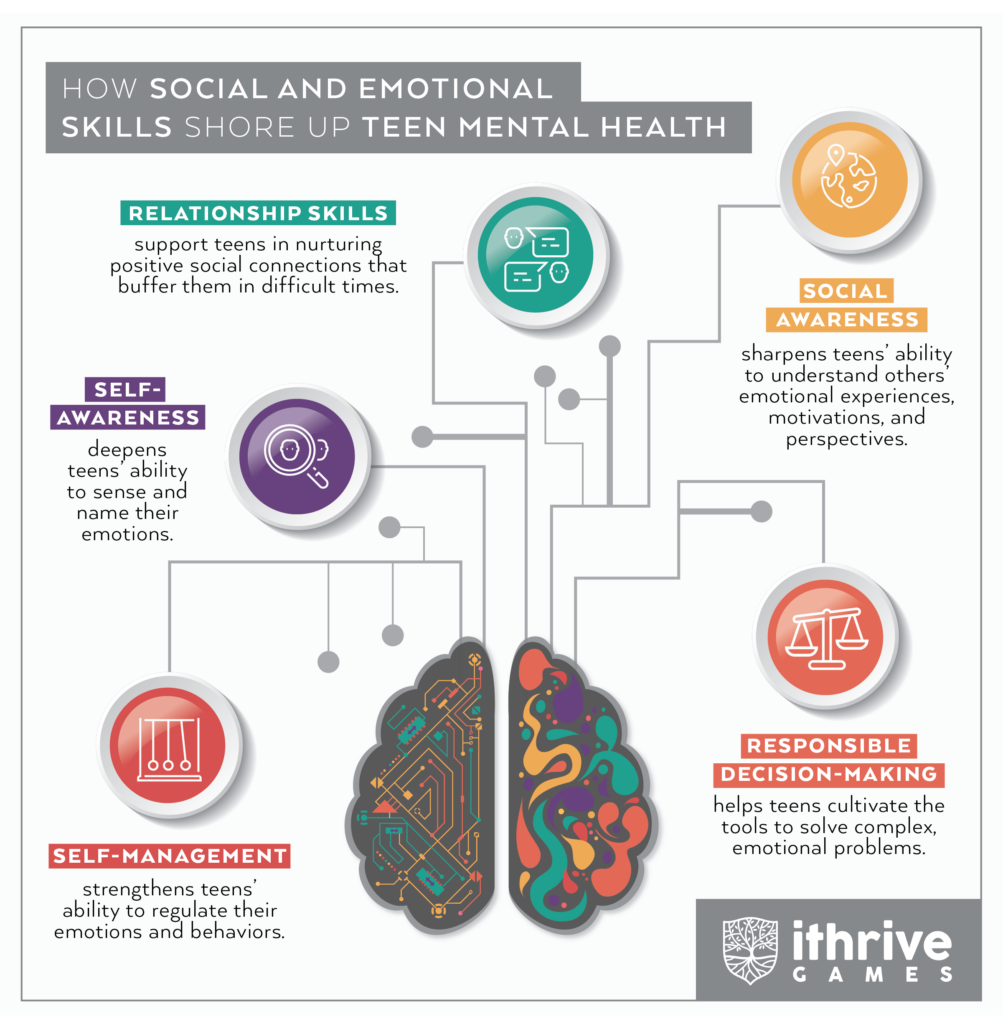
Download iThrive Games' How Social and Emotional Skills Shore Up Teen Mental Health infographic here.
A Look at the SEL Springboards in Your Favorite Video Games
Countless video games support players' social and emotional learning, presenting them with tasks, storylines, and challenges that reference or enlist the use of core social and emotional skills. Here's a look at a few:
- Self-Awareness in games can look like players self-selecting based on characters' strengths and weaknesses (Super Smash Bros. Ultimate), adopting a growth mindset (Minecraft), or them developing resilience to feedback (Super Meat Boy).
- Social Awareness in games can look like players empathizing with characters (That Dragon, Cancer), engaging from multiple perspectives (NieR:Automata, Octopath Traveler), or reflecting on how decisions impact other players or characters (This War of Mine).
- Relationship Skills are practiced in cooperative play experiences (Fortnite, Destiny 2) and can entail negotiating, problem-solving, and collaborating with others.
- Responsible Decision-Making in games can look like players weighing and watching the consequences of their choices to inform future ones (The Wolf Among Us) or trying different approaches and assessing results (Mass Effect).
- Self-Management presents itself in all games that invite players to persist through difficulty, prompting the feeling and managing of emotions like pride, frustration, gratitude, betrayal, guilt, forgiveness, complicity, and triumph.
Designing for teen thriving has led us to develop social and emotional skill-building games that deeply engage and connect young people in civics, media literacy, and current events. Our game guides offer tips for mental health practitioners who want to leverage games to connect with their teen clients. Our game-based curriculum units help teachers to transform learning in their high school English classrooms. These offerings are inspired by the wondrous magic of play and the potential games have in accelerating progress where all of us, young people especially, have the tools to thrive socially, emotionally, and cognitively.
Join our mailing list here to learn more about our work designing for teen thriving.
Teens Know What They Need to Be Healthy and Thrive. It’s Time We Listen.

What does it mean for teens to thrive?
At iThrive, we use games and game design to support teen thriving. In our 2017 white paper, we defined teen thriving as teens' "accumulating intrapersonal and interpersonal assets while progressing forward through adolescence." This is true, but it's not sufficient.
We see and hear firsthand that teens are uniquely positioned to see injustices and hold society to a clear and higher standard. Over the past 5 years, we have asked hundreds of teens what thriving means to them, and what they most want and need to thrive. We have listened deeply as we've worked side-by-side with them to envision and design elements of a more just, supportive world.
Our revised definition reflects the heart, admiration, and dedication we see and feel when we do this youth-centered work. They come away from it saying things like, "I realize now the change I can have on the world" and "This process ... has given me the empowerment not only to make decisions in my daily life but also to learn about how the systems that have already been created work and how to disrupt them through games. I feel very happy to be part of this and help promote social change."
Our revised definition also incorporates the latest scientific advancements in the teen brain and evidence about what works in positive youth development, social and emotional learning, and mental health.
The world and our perceptions of it have undergone seismic shifts in the years since iThrive was formed, and the ways we define and aim to support teen thriving have adapted in kind. The work of adolescence has always been social and emotional, but it is uniquely demanding for teens today who are navigating unprecedented social issues, all of which require action and accountability. At the forefront of movements demanding both are young people who are imagining what a just, supportive world could be and who are diligently and inventively pushing for new possibilities in the world they'll inherit. But their vital engagement in the world is being threatened by a youth mental health crisis that has been deemed a national emergency, so there is great urgency for adults and society at large to do more to support teens' mental health and well-being.
A NEW DEFINITION
Teens thrive when they, and the settings that serve them, take full advantage of the unique magnificence of the teen brain to optimize personal growth and well-being, establish healthy interdependence in supportive and affirming communities, and propel progress toward a more just world and a healthier planet.
"THE UNIQUE MAGNIFICENCE OF THE TEEN BRAIN."
What's uniquely magnificent about the teen brain? Research in the last two decades has revealed that the teen brain changes at an astonishing rate and is more "plastic" than it will ever be again. When teens have supportive relationships, experiences, and settings, the brain changes they're undergoing result in young people who, compared to adults, are generally more zestful and vibrant, more willing to take healthy risks, better positioned to think creatively about innovative solutions to problems, and more driven to engage and connect socially. In a world in which teens are thriving, both teens and the settings that serve them are aware of and supporting the development and healthy channeling of these amazing superpowers.
Of course, a magnificent teen brain exists within an individual self, nested within a community of people and resources, further nested within the world at large. Teen thriving needs to consider and encompass what is happening in each of these domains.
SELF: "OPTIMIZE PERSONAL GROWTH AND WELL-BEING."
Teens who are thriving in the domain of "SELF" feel physically and emotionally healthy and "alive" and are engaged in regulating their behavior and pursuing and accomplishing things that matter to them. OR, they have the internal awareness and tools they need to notice when something feels "off" and to skillfully manage difficult emotions or advocate for extra help. Settings that support teens to thrive in the domain of "SELF" meet their physical and emotional needs (including the need to build social and emotional skills) and provide meaningful opportunities to learn, achieve, and grow on each teen's unique path.
In teens' words: Thriving is "passion," "feeling confident in themselves," "being happy with where you are mentally, physically, and socially," "having goals and working towards those goals," and "being organized" and "able to deal with pressure."
COMMUNITY: "ESTABLISH HEALTHY INTERDEPENDENCE IN SUPPORTIVE AND AFFIRMING COMMUNITIES."
Teens who are thriving in the domain of "COMMUNITY" can make meaningful contributions to social settings where they experience caring and connection with people who affirm their evolving identities by offering them freedom and time to be themselves. They are also learning and using the skills of interdependence, balancing trust and reliance with satisfying levels of autonomy. OR, they are noticing a mismatch between their needs and available resources and are learning the skills to identify and advocate for how their communities could better support them. Settings that are supporting teens' thriving in communities see and affirm all teens for who they are, connect them with services and resources they need, and set high expectations for teens accompanied by the guidance and opportunities to meet those expectations.
In teens' words: "Teens thriving means that they are in an environment where they can be completely themselves," and "where their needs, both mental and physical, are heard, understood, and met." Thriving means having "a space of love" and "sharing your ideas with each other and helping people in need," like through "volunteering, cleaning up places, or advocating for small-scale reform." It also means "having a healthy balance between home and school life," "time for activities one enjoys as well as opportunities to recharge," and "time to process and explore our identities."

At the PLAY (Policy, Leadership, and Advocacy by Youth) Program last month, high school students from across the Piedmont region of Virginia gathered with staff from iThrive Games and UVA Batten for a week-long program. There, they used game design activities from our Game Design Studio Toolkit to explore policy issues that impact them and today's teens along with potential solutions. In response to one of our world-building activities, teens shared and illustrated their visions of thriving (pictured above).
WORLD: "PROPEL PROGRESS TOWARD A MORE JUST WORLD AND HEALTHIER PLANET."
Finally, teens who are thriving in the domain of "WORLD" show a curiosity and striving towards understanding the "bigger picture" and having an impact beyond their immediate lives and surroundings. OR, they can notice a desire for greater meaning and purpose and seek guidance on healthy ways to establish that meaning. Settings can support teens' thriving in the "WORLD" domain when the adults within them model ethical and effective leadership and informed and prosocial cross-cultural engagement, and when they remain open to the innovative and out-of-the-box solutions to global problems that teens are uniquely positioned to try.
In teens' words: Teens who are thriving are "going out of their comfort zone to give their input and effort to a situation or problem that needs help" and "advocating for change where we can and when we can." Some teens said, "My friends and family and getting to learn and experience new things gives my life purpose or meaning" and "I derive meaning out of my everyday life, I have goals that I would like to achieve..., I have friends and family I care for, and I have things I enjoy doing....I'm just alive so I might as well find purpose in the things that come my way every day."
The question of 'how do we support teens?' cannot be answered unless we are in community with teens and commit to actively listening to them. Their perceptiveness and ingenuity inspire us and guide the programming, resources, and partnerships we put into the world in support of their thriving.
Stay tuned to learn more about how our work is supporting this vision of teen thriving and sign up for our newsletter to receive updates on ways to get involved.
The Teen Mental Health Crisis is Real. Game Designers & Developers Can Help.
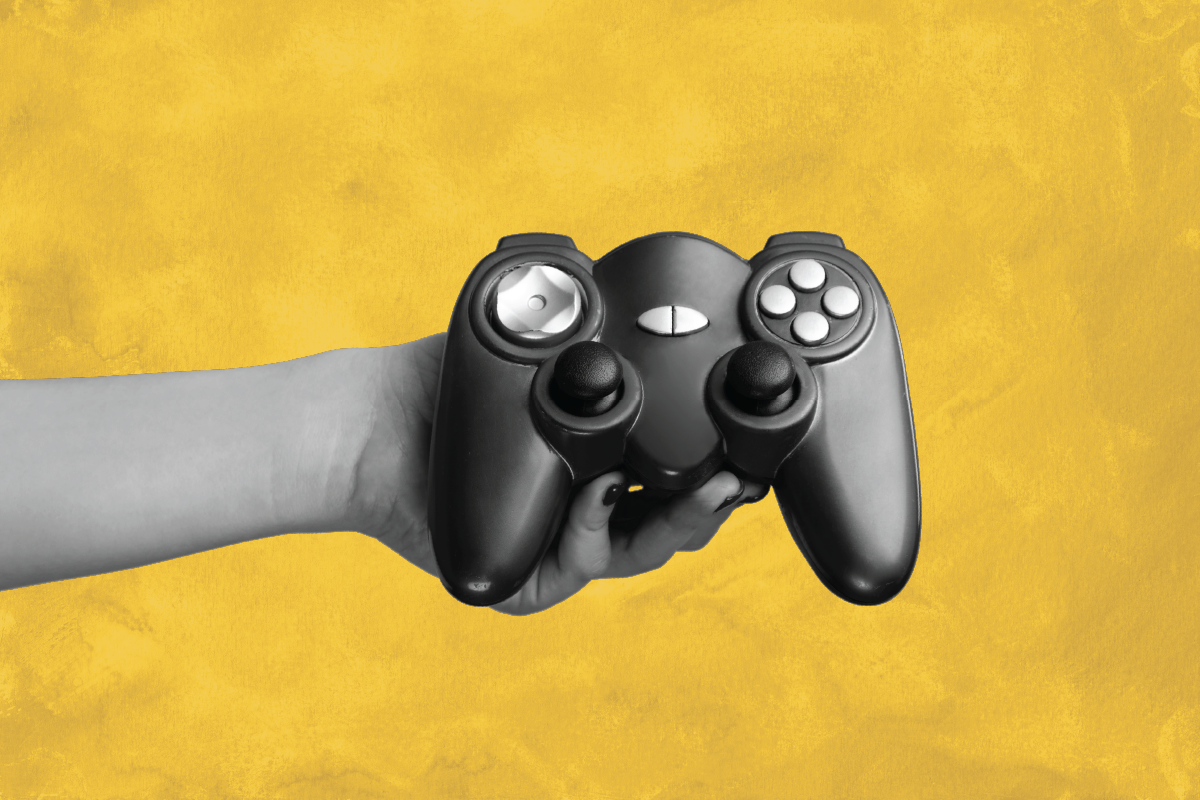
This post is the last in our five-part series, Supporting Teen Mental Health, which shares tools and insights that support educators, parents, and youth-serving adults in showing up for teens in this moment of need. Read earlier posts in the series about mindfully managing difficult emotions, using social media actively and intentionally, nurturing the teen brain with school-based social and emotional learning opportunities, and applying culturally responsive approaches in therapeutic interactions with teens.
Veteran game designer, Jason VandenBerghe, wrote for iThrive Games in 2018 that "If we want to make a large, positive change in our world, I believe the best route is to focus on providing teens with better models for the world." If teens needed better models for the world four years ago, how much more do they—and all of us—need them in 2022?
This month alone, two 18-year-olds separately made the ruinous decision to commit mass murder—one in a racially charged event in Buffalo, NY, and the other in Uvalde, TX. U.S. teenagers wake up every day to more evidence of gun violence, societal strife, greed and corruption in places of power, shrinking opportunities for financial security, and the threat of climate catastrophe. It's no small wonder that rates of mental health struggles among teens are higher than ever.
Video games and social media are too often the easy scapegoats for teens' mental health challenges. In reality, the impact of digital technologies on youth mental health and well-being is complicated, and conclusions in the research are mixed. We know that's largely because "digital technologies" vary as widely as the teens who use them and the circumstances in which they're used. Of course, playing video games under some conditions can be disruptive to the healthy functioning of some, and can facilitate the healthy functioning of others. So, what's the responsibility of a game designer or developer?
At iThrive, we value and know that it is both possible and imperative to empathize deeply with and design ethically for teens. One of the best ways we've found to do this: Co-design with teens the digital tools they use. A youth-centered approach to digital technology design is among the recommendations put forth by the U.S. Surgeon General in his Advisory on Protecting Youth Mental Health. When we design with teens, for teens, the digital experiences they engage with are both likelier to do no harm at this vulnerable developmental moment, and likelier to amplify teens' immense capacity to thrive emotionally, socially, cognitively, and physically.
There's so much that's fascinating and motivating about the teen brain and how it's changing. For designers, we've boiled it down to a list of 10 things to know when designing for this unique window of both opportunity and vulnerability to best support teens' mental health.
TEENS ARE:
-
BUILDING HABITS FOR LIFE: Teens' brains are undergoing the last major restructuring of development, making the teen years the perfect time to build skills and habits that help them throughout life. But negative habits "stick" more at this time, too.
-
CATCHING ONTO YOU, FAST: Teens are getting wiser about the world. They're reaching a cognitive peak and learn very quickly. They easily see through attempts to manipulate or preach to them and don't respond well to hypocrisy or unfairness.
-
IN NEED OF POSITIVE CONNECTIONS: Above all, teens need access to strengthening experiences, environments, and relationships that help them grow in positive ways. They want to be close to adults, even as they figure out how to be more independent.
-
MORE TOLERANT THAN TEENS USED TO BE: Teens today value diversity and acceptance even more than previous generations. They care about authentic inclusion and diversity.
-
NOT JUST "WEIRD:" Obvious, but worth remembering, teens aren't just Western, Educated, and from Industrialized, Rich, Democratic countries. They need their uniqueness and diversity to be reflected in the spaces where they spend time.
-
SENSITIVE TO REWARDS, ESPECIALLY SOCIAL ONES: Teens have more dopamine circulating in their brains than adults. They are very sensitive to "feel-good" rewards like those in video games. Teens do riskier things when other teens are around, partly to earn status and respect.
-
STILL LEARNING TO CONTROL IMPULSES & EMOTIONS: Teens are still developing connections in the prefrontal cortex. They have a more challenging time controlling impulses and emotions and predicting the consequences of their actions than they will in the future.
-
IN NEED OF MORE SLEEP: Teens need more sleep than adults to thrive, and they might need support to make the best choices and set boundaries for their health.
-
FACING A LOT OF STRESS: Teens are under a ton of pressure. Also, if they are going to appear, most mental illnesses show up between early adolescence and young adulthood. Teens need ways to cope and to be able to seek help without stigma.
-
TRYING TO FIGURE OUT WHO THEY ARE: Teens want to try on different roles and expressions and figure out where they belong. They need social spaces to interact, experiment, negotiate, and resolve conflicts. But toxicity and bullying should be proactively prevented in these spaces.
So, if you're a designer or developer of experiences teens use, how much do you think about their needs at this developmental moment? What models of the world are you making for them? And are teens a part of your design process?
Creating spaces that foster teens' mental health and well-being is a team effort. iThrive is here to support you. We offer Game Design Kits, evidence-based guides to designing for mental health, and specific components of teen thriving like growth mindset and zest. We also specialize in custom design services that draw on teens' genius and creative problem-solving energy. Reach out to find out how you can use our co-design approach at your studio or organization.
SEED Designers Bring Games & Experiences to The Heller School at Brandeis

This summer, youth designers at the SEED Institute are bringing their expertise (and games) about the harmful systems they've navigated to graduate students at The Heller School for Social Policy and Management at Brandeis University.
Those who are most impacted by systemic harm know what's needed to disrupt it.
This belief is a foundational one at the SEED Institute, a collaborative effort between Transition HOPE, iThrive Games, and the Black Ministerial Alliance-Ten Point Coalition. At the Institute, young people are SEEDs—System Educated Expert Disruptors. Synthesizing their lived experiences navigating systems of oppression into structured games, SEED Designers use play to advocate for meaningful change in youth-serving institutions. They then bring the games to sessions with community stakeholders throughout Boston, where the designers facilitate play-based conversations to share knowledge, identify and unpack inequities, and imagine possibilities for systems that truly nurture youth. The work of the Institute so far has been powered by SEED Designers' inventiveness and their commitment to building relationships and facilitating conversations that ignite and inspire action.
For a few designers at the SEED Institute, advocacy began with Transition HOPE's Summer of HOPE 2018, an initiative that paired them with graduate students and faculty at The Heller School for Social Policy and Management at Brandeis University. Working as research assistants over seven weeks, the SEED Designers had the opportunity to learn more about how structural violence impacts day-to-day life. Meanwhile, the graduate students and faculty learned more about how to best support young people.
This year, the SEED Institute will continue this vital work with The Heller School's newly launched Racial Justice and Tech Policy Initiative (RJxTP). Through this initiative, SEED Designers will engage in research and develop a game as part of the Hidden Bias Research Prize. RJxTP aims to create more opportunities for knowledge-building and knowledge-sharing between and among youth designers, graduate students, researchers, and policymakers. SEED Designers will use their stories, wisdom, understandings, and ideas to contribute to the dismantling of systems of injustice. Check out the video below for a glimpse of the collaborative work ahead:
Stay in the loop! To quote one of the designers at the SEED Institute, "awareness is like a fire—and that's what we're here for; to spread that fire and spark change in somebody's mind." Keep up with the SEED Institute's design team as they develop and launch new games, and press forward with their advocacy and awareness-building through play, by signing up for our mailing list today.
One Thing Mental Health Practitioners Who Work With Teens Must Know

This post is the next in our series, Supporting Teen Mental Health, which shares tools and insights that support educators, parents, and youth-serving adults in showing up for teens in this moment of need. Read earlier posts in the series about mindfully managing difficult emotions, using social media actively and intentionally, and nurturing the teen brain with school-based social and emotional learning opportunities.
Teens' mental health difficulties and needs have peaked since the start of the pandemic, culminating in what leading U.S. child and adolescent health organizations have deemed a national emergency. As mental health practitioners strive to meet diverse teens where they are at this time of crisis—in part one spurred on and exacerbated by racial inequities—they need tools and approaches that offer authentic entry points for building rapport and trust.
The U.S. Surgeon General's 2021 Advisory, Protecting Youth Mental Health, stresses the need to "recognize that a variety of cultural and other factors shape whether children and families are able or willing to seek mental health services. Accordingly, services should be culturally appropriate, offered in multiple languages (including ASL), and delivered by a diverse mental health workforce." Using culturally appropriate tools and approaches invites teens and their families to engage as equal partners in improving and maintaining young people's mental health. Critically, this approach also amplifies and celebrates existing strengths and connections that are unique to each young person's cultural background and social network.
At iThrive, we've witnessed how games can be a powerful part of culturally responsive approaches to supporting teens' social and emotional skills, which are critical for mental health across the lifespan, both in schools and in therapeutic settings. That's because games of all kinds have the power to tell compelling stories, not just about the characters within them but about the players who play them, revealing truths about who they are and the world they inhabit. As one high school senior said of iThrive Curriculum: Museum of Me, our unit based around the game What Remains of Edith Finch: "You learn some things about yourself and others. It's nice to know that your [sic] not alone in seeing yourself a certain way. It's kind of relieving to know other people feel the same ways about themselves."
In an effort to help youth-serving practitioners better support teens with culturally responsive tools and approaches, iThrive's Senior Director of Learning Michelle Bertoli interviewed Lora Henderson, a licensed clinical psychologist, former educator, and assistant professor at James Madison University who specializes in supporting the mental health of young people in underserved populations. In the interview transcribed below, she shares best practices and tools — including game-based approaches — for engaging authentically with diverse teens in support of their health and healing. The interview has been edited for length and clarity.
Michelle: In your own work, how do you identify and define culturally responsive tools and practices?
Lora: I work at the intersection of education, mental health, and social and emotional learning. I define culturally responsive practices, or CRPs, as actions practitioners can take to build on students' strengths and cultural frames of reference. In the classroom, this might mean drawing connections between the curriculum and students' home lives and cultural experiences. In a clinical setting, it might include showcasing materials, games, books, and posters that reflect students' cultural backgrounds and experiences.
Michelle: And how do you get a sense of what's going to be culturally relevant and useful to students? It takes time to get to know them and you don't want to make assumptions.
Lora: Yes, that can be difficult because you don't want to fall into stereotypes about groups. We often go into our interactions with children and families with our own biases and assumptions about their cultural groups. Sometimes those things map onto their experiences and other times they don't. So, I do a lot of building relationships with kids, asking them what they did over the weekend, how their family celebrates holidays. Those small things aren't therapy, per se, but are really important to getting to know kids and their families and what culture means to them and looks like in their own contexts.
Michelle: At iThrive, we design our games and game-based tools with equity, representation, and accessibility as core pillars. From a practitioner's perspective, how do these design principles make a difference for supporting teen mental health and well-being?
Lora: We can expect youth to have improved outcomes when they can connect to the materials, games, or information being shared with them. When we design with youth, put them at the center, and make them experts, like everyone at iThrive really does, it can maximize positive youth engagement with the tools you're creating. At iThrive, it's a bidirectional process: the youth designers get to build social and emotional skills and increase their well-being, and peers who play the games also get to learn from the youth designers' expertise and experiences. That process can have large positive effects for the designers and their peers alike.
Michelle: What tools, including games or game-based approaches, do you use to strengthen young people's awareness and embracing of their cultural identities?
Lora: From my time as an elementary school teacher to my current role as an assistant professor and licensed clinical psychologist, my first job is to build rapport and authentic relationships with youth. All of the other positive outcomes are couched in that initial positive relationship that creates a safe space for youth and families to feel accepted. That's how I demonstrate my respect, openness, and acceptance of their cultural identities. In my classroom and therapy office, I ensured that the books, pictures, and posters reflected the diversity of my clients so that youth could see themselves in my office and know that it was a safe space to be themselves.
In therapy, I play lots of tabletop, board, and card games with youth. As one example, I've played a lot of Spades with Black families who play it at home, to bring an aspect of their culture into the room. I have emotions/feelings playing cards, so as we're playing Spades, and they get a "9" with an angry face on it, we talk about times when they were angry or observed someone else being angry, and how they managed those feelings. I really like to incorporate games that youth are already playing and then infuse mental health and social and emotional components into them. In in-patient settings, youth have taught me card games that they learned while in the hospital or juvenile detention. I let them lead the play. It's one way I demonstrate that I accept and value their lived experiences.
Michelle: How has embracing your own cultural identity as a practitioner helped you hone your professional skills? How have games played a role in this?
Lora: As a Black woman, I have had to examine my own biases and experiences to help me acknowledge the systemic racism that I experience in this country AND the privileges that I have as an employed, cisgender professional with a doctoral degree. While games have to be facilitated thoughtfully and in a sensitive way, gameful activities like "Step in the Circle," "Cross the Line," "Four Corners," and the "Privilege Walk" have helped me with my own personal exploration. I have moved away from the "Privilege Walk" activity because it visually moves privileged individuals ahead and those with less privilege behind and can perpetuate bias, but it was a meaningful activity for me when I did it about 10 years ago. It was the first time that I was really able to reflect on my privileges and challenges as a Black woman. The other activities that I mentioned still have the visual component of stepping into the circle, crossing the line, or going to the corner that aligns with youth experiences, but they remove the cumulative visual effect of moving further ahead or further behind.
Michelle: How would you recommend other clinicians who are not as practiced in culturally responsive approaches with young people begin to build those muscles?
Lora: The best way to become more culturally responsive is to engage with youth and listen to them. Reading the literature and learning about cultural responsiveness, humility, and competence is important, and still there's nothing like just talking to youth. Inevitably, they'll tell you that it doesn't work exactly how it's explained in textbooks or scholarly articles.
But before talking to youth, anyone who wants to be culturally responsive needs to engage in self-reflection about their own biases and assumptions about people from other cultural groups. It can help to have a group that you talk to about these things for accountability and outside perspectives. I can't stress how important doing that personal work is before stepping into work with youth. We don't want them to be our test subjects or to cause unintentional harm by doing things we think are culturally responsive but might be missing the mark and actually doing harm.
Talk to youth about what they like to do, what they enjoy, how they celebrate holidays. Get to know them in an authentic way.
Michelle: How can practitioners manage the fear or uncertainty they may have about making mistakes or unintentionally doing harm when striving to be more culturally responsive?
Lora: I think mindfulness-based techniques are really helpful. If you feel yourself getting nervous or unsure, stop and take a few breaths. Center yourself and remind yourself why you're doing this work. So many of us go from meeting to meeting to facilitating a workshop, etc. Sometimes just taking that breath can help settle your nerves and get you ready for those intersections.
Also, I think it can be fine and even acceptable to acknowledge differences between youth. You can highlight both obvious differences and similarities to help youth notice commonalities they share. Let youth know that you're trying, that you're maybe from a different cultural background and you might stumble, and you want to know about it if you do so you can do better next time. You need a safe space, too, in order to learn when you've made a mistake. It all comes back to authentic relationships because if you don't have that and you miss the mark, youth won't tell you. They might keep trucking along with the program or activity but the outcomes may not be as positive as they could have been.
Michelle: What are some resources you would recommend to practitioners who want to learn more about culturally responsive practices?
Lora: I lean heavily on the Double-Check framework. It's from education but applies in therapy as well. A shorthand tool it uses is the acronym CARES: Connections with curriculum, Authentic relationships, Reflective thinking, Effective communication, and Sensitivity to students' cultures.
For people who want to go even deeper, I also recommend this review of CRPs from an education perspective.
Michelle: Thank you so much for your time and insights, Lora!
[End of Interview]
Mental health practitioners seeking to find new ways to meaningfully engage and support teens from a diversity of backgrounds can also find inspiration in iThrive's Game Guides, which highlight unique ways to check in with teens and touch on their emotional experiences through the lens of some of their favorite games including Minecraft, Fortnite, and Super Smash Bros. Ultimate.
iThrive's Game Design Studio Toolkit is another rich resource for using games as systems to engage teens in complex, aspirational thinking that has its roots in awareness of their unique personal experiences. Individuals who aspire to something even more innovative can also make use of iThrive's design services to envision and realize completely fresh game-based approaches.
What are some ways you use games or game-based approaches in therapeutic interactions with young people? Let us know at contact@ithrivegames.org!
How Social and Emotional Learning Nurtures the Teen Brain
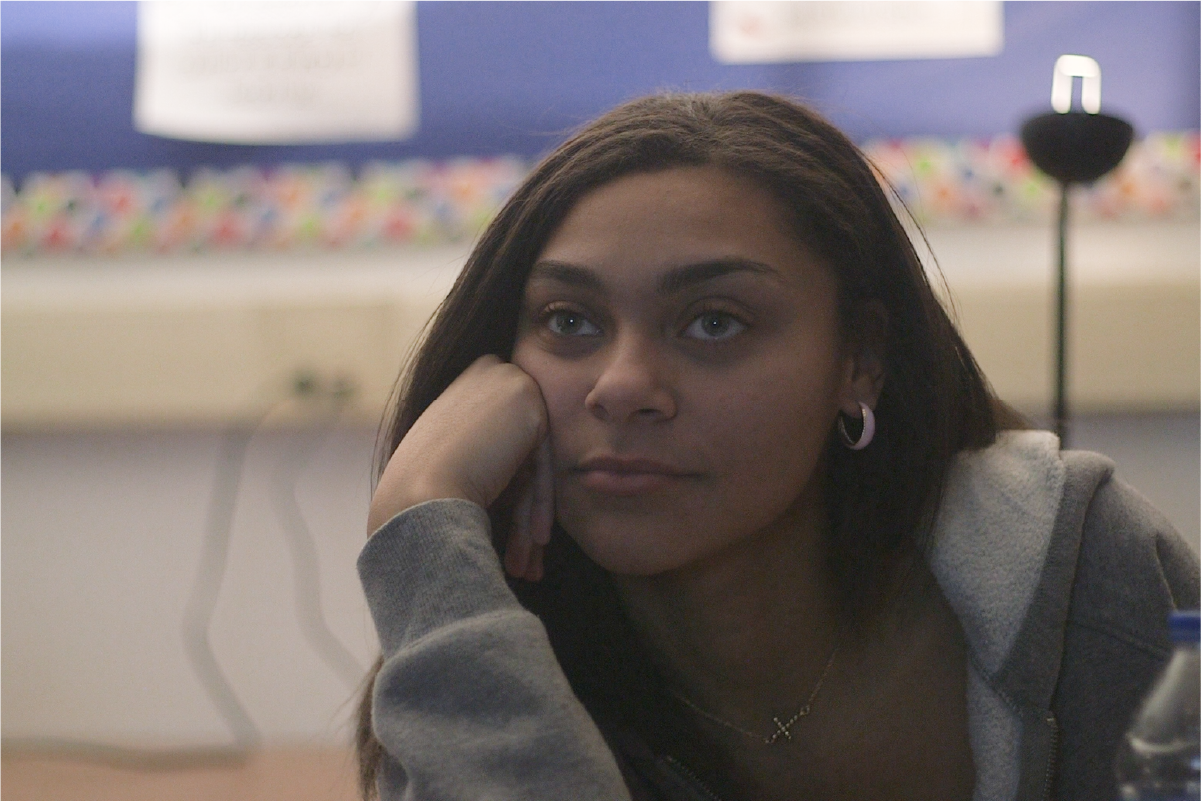
This post is the next in our series, Supporting Teen Mental Health, which shares tools and insights that support educators, parents, and youth-serving adults in showing up for teens in this moment of need. Read earlier posts in the series about mindfully managing difficult emotions and using social media actively and intentionally.
"My understanding of myself changed a great deal."
"I learned how to be a better friend."
"I was able to deal with aspects of myself that I never really had before."
"It's nice to know that you're not alone in seeing yourself a certain way."
Each of these quotes shared by teens is a testament to what happens when schools provide them with meaningful opportunities to actively explore who they are and who they want to be in the world and to build the social and emotional skills that support their mental health and development.
Adolescence is the last major window of neuroplasticity, a time when the teen brain is open to incredible learning potential, on one hand, and heightened vulnerability, on the other. Half of all serious mental health disorders in adults begin by age 14, making early prevention and intervention critical. High quality social and emotional learning interventions have been linked to reduced symptoms of anxiety and depression and lower levels of emotional distress among young people. But even teens who are not experiencing mental health struggles have specific developmental needs when it comes to maintaining and improving mental health. These include having opportunities to figure out who they are, to experience autonomy and independence, and to refine their relationship skills as interactions with both peers and adults in their lives become deeper and more complex. Each of these skills, and many more, are the aim and outcome of quality school-based social and emotional learning efforts.
The U.S. Surgeon General's Advisory on Protecting Youth Mental Health notes the role school communities can play in helping young people find "a sense of purpose, fulfillment, and belonging," supporting them in "managing their mental health challenges." Accordingly, they recommend that educators, school staff, and school districts continue to "expand social and emotional learning programs and other evidence-based approaches that promote healthy development." Mental health supports fall on a continuum of care, and high quality social and emotional learning programs are a "Tier 1" intervention, meaning they provide fundamental coping skills all students in a school community need, even as some students will require more intensive and targeted types of mental health support.
The Advisory mentions that creating the foundation for "a healthier, more resilient, and more fulfilled nation" where young people can thrive begins with creating "accessible space in our homes, schools, workplaces, and communities." To us, "access" means meeting teens where they are developmentally with tools they are familiar with and inviting them to the table when those tools are being developed to share how and what they want to learn. At iThrive, we specialize in creating social and emotional learning experiences that enlist the power of play and respond to teens' unique developmental needs. By design, we prioritize teen voice, personal relevance, and student choice in what we create with and for young people. The genius, creativity, and insight of the teens we work with continues to steer our game and curriculum development work, resulting in memorable and meaningful learning experiences that engage them deeply.
For educators and administrators looking to prioritize their students' mental health, social and emotional learning opportunities and the core skill-building they foster can be a powerful and transformative lever.
HERE ARE THREE WAYS TO ENHANCE YOUR SCHOOL OR DISTRICT COMMUNITY'S COMMITMENT TO SOCIAL AND EMOTIONAL SKILL DEVELOPMENT IN TEENS:
1. CALL SOCIAL AND EMOTIONAL SKILLS WHAT THEY ARE: ESSENTIAL SKILLS.
We've written about it before, and it bears repeating. How we talk about something impacts how it is received and regarded. In a world where polarization and hatred threaten our unity, we can't afford to downgrade competencies like self-awareness, self-regulation, showing empathy and care, effectively advocating for ourselves and others, and making responsible decisions for the greater good to "soft skills." Raising the profile of these core skills to an educational and humanistic priority sets the scene for innovative programming and instruction that responds to and addresses students' needs. To quote a member of our Educator Advisory Council, "Education is not an academic pursuit, it's a relational one. They listen to me because of the relationship, not because I'm the teacher." Meeting social and emotional needs is, simply put, the foundation for effective learning.
2. FIND TOOLS THAT EMBED SOCIAL AND EMOTIONAL LEARNING INTO CORE ACADEMIC CONTENT.
Social and emotional learning efforts are powerful when evidence-based tools are embedded into the content students are already learning, and there's often a natural alignment. Our iThrive Sim role-playing simulation games designed for high school social studies classes, for example, build on the natural synergy between civics education and social and emotional competencies. As students collaborate to make decisions that drive each iThrive Sim scenario forward, they expand their civic knowledge while practicing core social and emotional skills like managing stress, regulating emotions, and making responsible decisions. Likewise, iThrive Curriculum's learning units pair with immersive games to support high school English and humanities educators in discussing self- and social awareness, self-management, and relationship skills with their students. As students work through these curricular units together, the narrative at the center of the game becomes an organic springboard for meaningful reflection and conversations about identity, relationships, and communication.
3. ADOPT AN EQUITY LENS.
Emotions and social connections drive learning. In that sense, social and emotional learning is ultimately about ensuring students' preparedness and ability to learn; all students deserve that fair chance. Implementing high-quality and evidence-based social and emotional learning experiences is a key step toward equity in your school or district community. Taking it a step further, social and emotional learning experiences themselves should be designed with equity and access in mind. iThrive's tools are designed to be representative of and accessible to diverse learners in line with our commitment to equity and universal design for learning principles. Gabbrielle Rappolt-Schlichtmann, an internationally recognized expert in learning science and accessible learning, calls our offerings, "the most innovative, integrated social and emotional learning work I've seen in the high school space."
Social and emotional learning opportunities tend to teens' whole selves. They help young people look inward and deepen their ability to know themselves, name their needs, regulate their feelings and behaviors, and embrace others with empathy and curiosity. Committing to these three practices to support social and emotional learning efforts will meaningfully move school communities toward helping students develop core skills and competencies that support their mental health and emotional resilience, setting them up for thriving far beyond school walls.
Refugee Students Use Game Design to Support Schools Welcoming Refugees
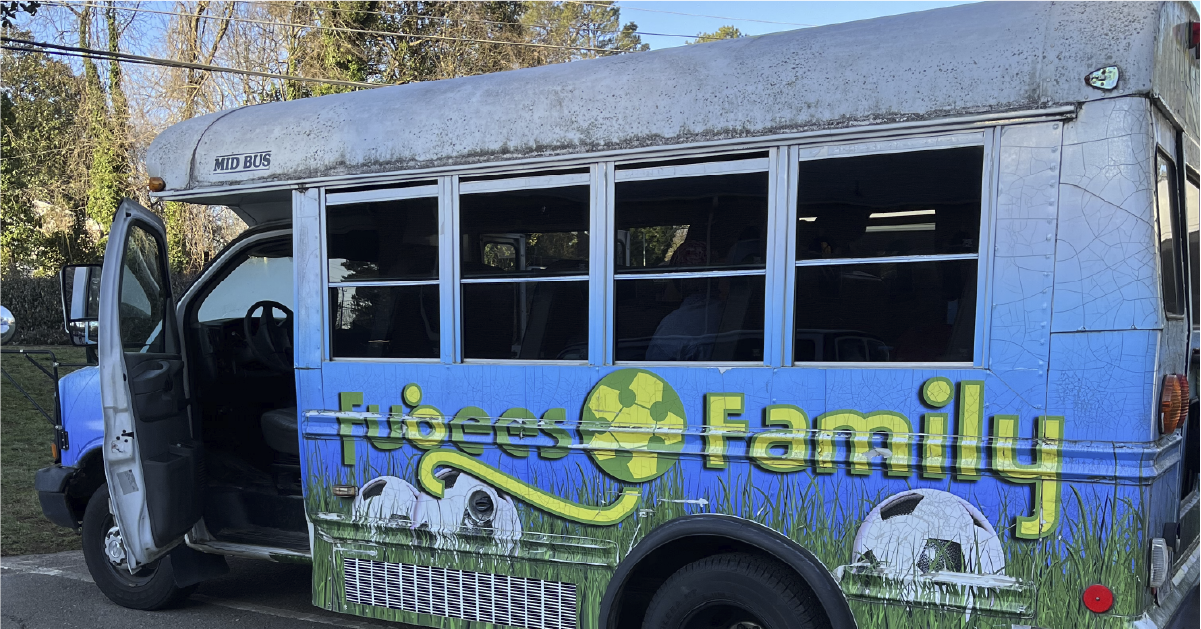
"What do you want teachers and other students to know, feel, say, and do when they connect with refugee students?"
On the morning of Wednesday, February 10th, members of the iThrive team posed this question to a group of experts—22 high school students from Fugees Family, a community-based school designed to meet the unique academic, social, and emotional needs of refugee students acclimating to life in the United States. What followed was two and a half days of deliberation expressed in story-sharing, collaborative thinking, imaginative drawing, and play, the insights from which will inform the creation of tabletop games that communicate an answer.
In December, Luma Mufleh, founder of the Fugees Family, approached iThrive and shared her desire to co-create with Fugees Family students resources that would highlight their expertise, communicate their experiences, build empathy, and ultimately, support schools across the nation who are accepting incoming communities of refugee youth. We knew then that game design, and the cognitive process it entails, was the way to go.
"Games are a safe way to learn about something," shares Luma. "We want to create empathy, so the games' content needs to come from those with lived experience. The games have to be through the lens of those who've experienced what it's like to be a refugee and enter a new country, school system, community, and lifestyle. And that's why it is super important to bring refugee students into the design."
iThrive's Game Design Studio program offers schools and youth-serving organizations a unique design thinking and social and emotional learning experience where teens play, analyze, reflect, connect, and design games that express their ideas and prompt change in those who play them. In bringing the Game Design Studio to Fugees students, our objective was to join the Fugees Family in their commitment to amplifying the voices of refugee youth. We committed to using what their students shared to develop games that center and highlight their courage, creativity, and resilience, and humanity.
Here's a snapshot of what was surfaced, shared, and dreamt up in our time together:
DAY 1: PLAY, IDEATION, AND MOOD BOARDS
The first day of the Game Design Studio began with play. Introductions were made during an icebreaker activity where each student and staff member shared their name and a dance move that everyone else in the group repeated and mirrored. The icebreaker was followed by an opening design activity that added new layers and variations to Rock-Paper-Scissors and invited students to name and explore mechanics that can be added and taken away to games to make the play experience more collaborative and comprehensive. Reflections on the 'Rockstar' and 'Giants-Wizards-Elves' versions of the classic game led to even more ideation as students played an array of board and card games, noting each game's components and reflecting on whether or not they'd like to incorporate them in the ones they were co-creating.
In the second part of the day, students explored how design can evoke emotions that enrich a game experience with depth and intention. After being assigned an emotion card that they were asked not to show to their peers, students grabbed a piece of paper and sketched out a scene reflective of the word on the card. Once done, students posted what they created on a board and did a gallery walk, making predictions about what mood each board communicated and noting how certain colors, imagery, patterns, and dialogue spurred visceral emotional reactions.
Mood boards created by students from Fugees Family.
DAY 2: CHARACTER DESIGN, WORLD-BUILDING, AND PAPER PROTOTYPES
"What does your refugee superhero look like?"
The second day of the Fugees Family Game Design Studio kicked off with this prompt and an invitation to dream up game characters. Students thought critically about the parts of every superhero's story—their origin, transformations, life shifts, weaknesses, superpowers, and strengths—conceptualizing characters reflective of the students' own personal stories and brilliance. After drawing and documenting these characters, students were asked to draw the world that surrounds their character, one that encourages them to step into and stay in their full power.
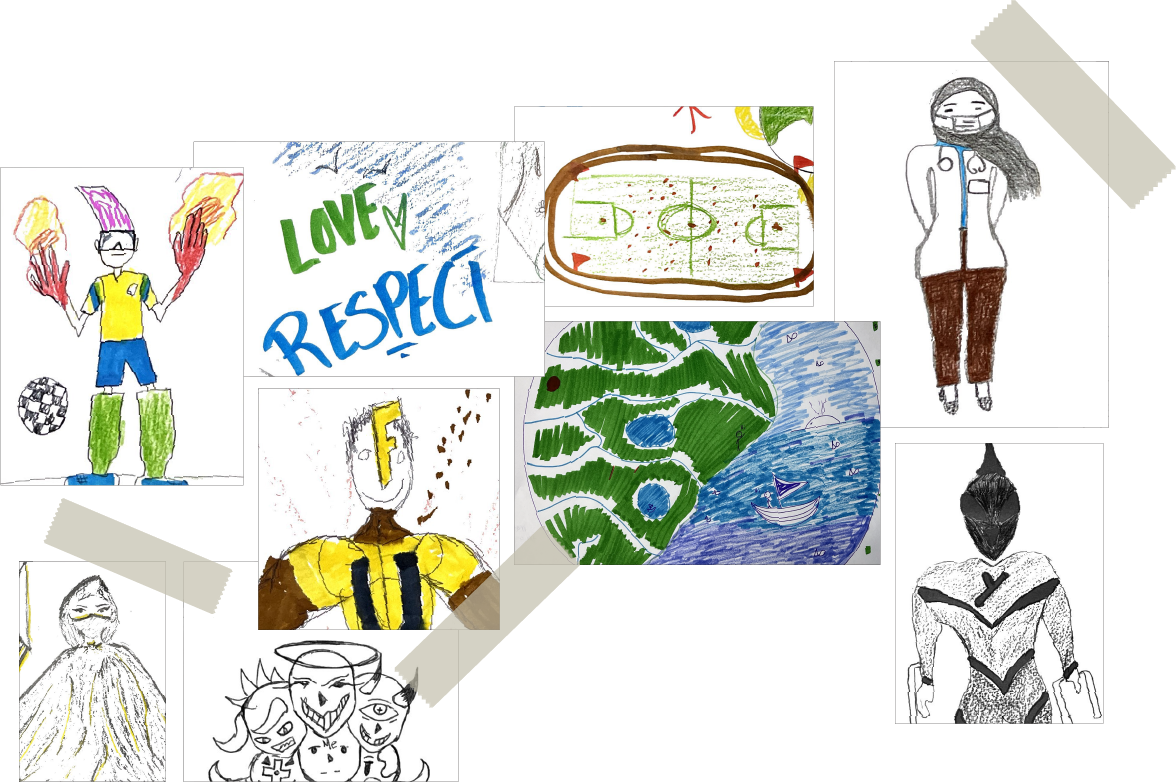
Worlds and characters designed by students from Fugees Family.
With worlds and characters in hand, students reflected on a critical question: "If your superhero was stripped of their superpowers and taken from the world that supports their thriving and special abilities, what could empower them? What could discourage them?" Pulling from both their lived experiences and imaginations, students, working in groups, began to map out the attitudes, actions, and behaviors they associate with a genuinely welcoming environment along with the ones they see as othering and isolating. By the end of the first part of the day, together, students had created 100+ cards with insights that will be incorporated into future games and learning tools to support the work of Fugees Family.
The remainder of the day was dedicated to paper prototyping and playtesting. On a game board template, students worked in groups to assemble games that centered and used the cards they made and behaviors they mapped. In brainstorming together, students laid out their game's learning objectives, mechanics, rules, and win and loss states. The iterative process of playtesting their games with others and then fine-tuning them based on observations and feedback led to the development of five paper prototypes with components that will be incorporated into the final games.
DAY 3: PLAYTESTING, STORY-SHARING, AND LIFE MAPS
A common thread in each of the five prototypes developed by the designers on Day 2 was a desire to create a gameplay experience that helped teachers and students—refugee and non-refugee students—learn more about each other. On the morning of the last day of the Game Design Studio, students built on this throughline. Working in pairs, they drafted questions and conversation starters on index cards. Once done, they swapped decks with another team of student designers and playtested their questions, ensuring they were all accessible, welcoming, and connection-centered questions. By noon, students had compiled over 200 conversation starters that will be shared in a future game.
The last few hours at Camp Twin Lakes were full of personal stories and reflections on what refugees leave behind, what they encounter on their way to refuge, and what life is like when they arrive. After Luma shared her grandparents' story of fleeing Syria during the Assad regime, students, gathered in a circle, used it as a springboard to dig deep into their own stories and note the similarities in their experiences.
For the last design activity, students spent time outdoors sketching out a life map that outlined the emotional journey of their lives so far. These maps, along with the creations and ideas generated up until then, will inspire a suite of games for teachers and non-refugee students that will support the welcoming of refugee youth who, as one student shared, "just want to be treated as human beings." As students and staff loaded onto the Fugees Family buses and left the camp, we were all reminded of what can come from co-creation and the role it plays in imagining new solutions.
"When we desire to imagine what a better future can be and needs to be, there's no one better to imagine and co-create with than teens," shared Susan E. Rivers, Executive Director and Chief Scientist at iThrive Games. "The teens from Fugees Family are the experts and the ultimate design partners in designing the tools schools and communities need to welcome families who have been forced to flee their countries. These teen designers bravely and candidly brought their lived experiences and expertise to Game Design Studio with the goal of helping schools offer safe and supportive and empowering environments for all students, including refugees. The schools they imagine are ones where all students—refugees and non-refugees—feel cared for and respected, where shared humanity is the connective tissue."
The Fugees Family model, centered in soccer, encourages every student to work as a team member to support collective thriving and well-being on and off the field. We see the tabletop games that will be generated from this Game Design Studio session with Fugees Family students as an extension of that model. The students' genius and honesty will lead the way for better support of refugee students and help schools get better at togetherness. Sign up for our mailing list today to be one of the first people notified when the games launch.
To learn more about the Fugees Family and their mission to advance educational justice for refugee and immigrant youth, visit their website at www.fugeesfamily.org.
Teen Mental Health: Five Tips for Making the Most of Your Social Media Use
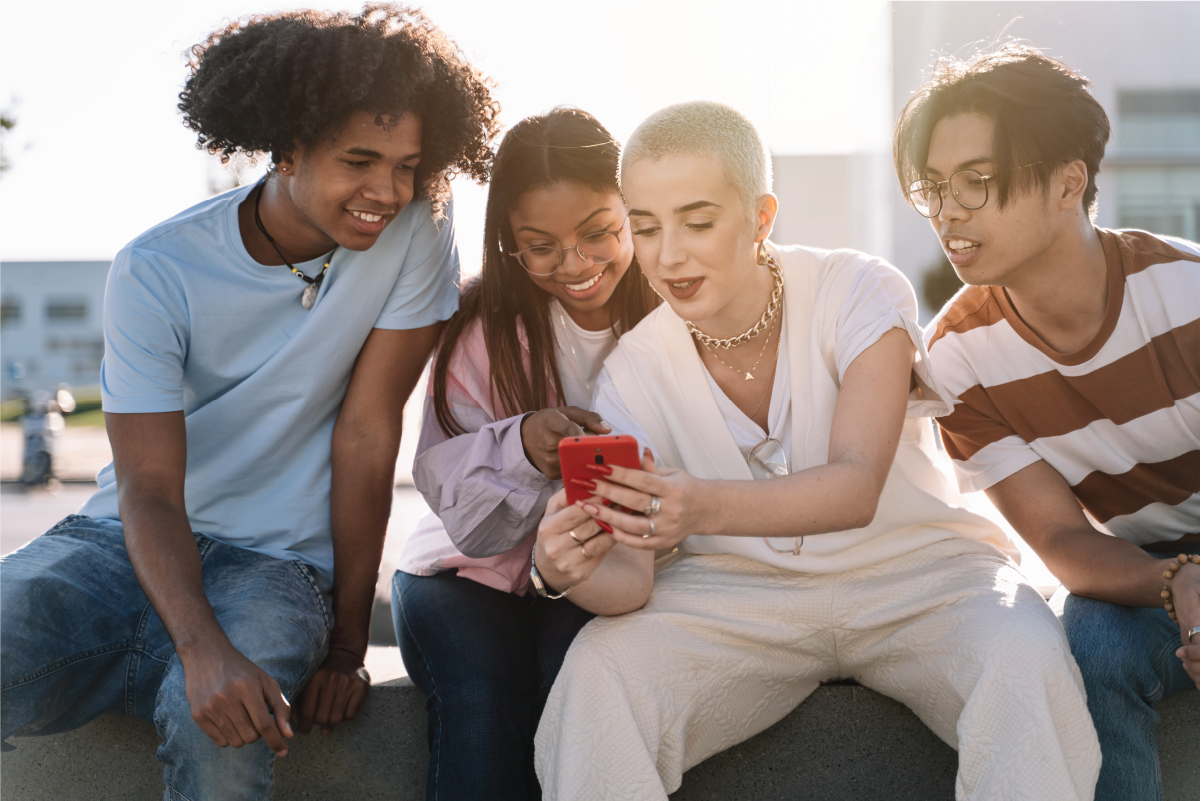
This post is the next in our series, Supporting Teen Mental Health, which shares tools and insights that support youth-serving adults in showing up for teens in this moment of need. Click here to read the first post in the series about mindfully managing difficult emotions.
Social media use gets a bad rap, and there are certainly reasons for caution. As shared in the U.S. Surgeon General Advisory's recent report on teen mental health, in 2020, 81% of 14- to 22-year-olds said they used social media either "daily" or "almost constantly" and in some circumstances social media use has been linked to poor mental health outcomes.
These findings may be alarming to adults who care about young people and want to protect them online, but as one teen shared with us, "To a high schooler, representation on social media is a huge deal...they don't want authority stepping into their fun zone." Even though guidance and support can be helpful, adults often lead with fear and hammer on the dangers of social media without identifying the opportunities. Yes, we all can strive to be intentional in our use of social media. Adults can model that intentionality. Adults also can reframe social media as one important tool young people and adults can use to support things that matter to them.
ACTIVE SOCIAL MEDIA USE VS. PASSIVE SOCIAL MEDIA USE
How well social media connects or isolates us depends partly on the behaviors we embody while using it. The Advisory reports on an important distinction between passive and active social media use, highlighting how healthier the latter is.
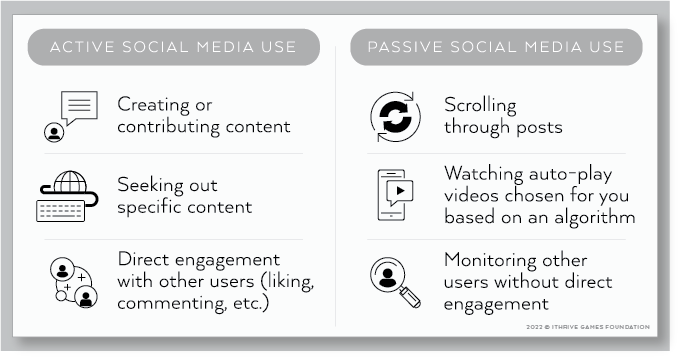
An active social media user uses its platforms to enrich and simulate real life. They use social media to connect, share and talk to the people they know, and actively engage with communities that offer new perspectives or that share their interests and hobbies. On the other hand, a passive user does not directly engage with others on social media platforms. Instead of actively interacting with others, they wait for content to come to them. Research shows that passive use of social media induces feelings of isolation, sadness, and depression often spurred by viewing the lives of others. If we're all aware of the behaviors that support more positive and healthier experiences on social media, we know which usage patterns to strive for whenever we're online.
HOW TO USE SOCIAL MEDIA ACTIVELY AND MAKE THE MOST OF IT
We spoke to a few of the teens we've worked with to co-create learning experiences for high school classrooms and asked about how they engage with and on social media. Their answers point to how social media, when reframed as a relevant tool for teens and when used actively, supports self-regulation and social connection along with the exploration of self, emotions, thoughts, and interests. Whether you're a teen or an adult, these five tips can help you make the most of social media use so you can post and peruse with purpose:

1. SET YOUR INTENTION.
Why are you going on this social media platform right now? What are you looking for or hoping to feel? If it's simply to escape and avoid anything heavy for a little while, that's valid! Since these platforms are designed to pull you in and keep you on as long as possible, just notice without judgment when your use is drifting from your initial intention and take a pause to bring yourself back to it.
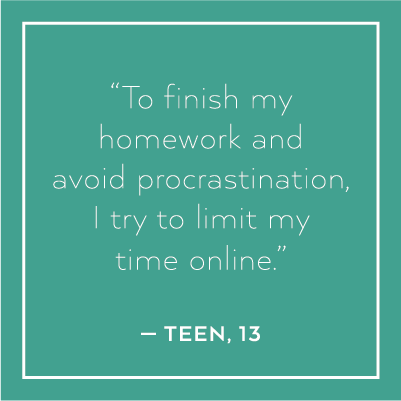
2. CONSIDER SOCIAL MEDIA USE AS ONE PART OF A HEALTHY MENTAL DIET.
Social media use can promote connection and contribute to mental and emotional health when used mindfully and in balance with other healthy behaviors like sleeping enough (7-9 hours for adults, 8-10 for teens), keeping your body moving, spending time with others in person, taking time to reflect on who you are and what you want, and more. Over a few days or weeks, notice what portion of your mental health "plate" social media takes up, and look for opportunities to continue to fine-tune your best balance.

3. CREATE AND EXPRESS.
Especially for teens, social media is a great place to make content and express the many aspects of a dynamic personal identity. Try your hand at making up a dance, sharing artwork, or narrating an experience that reflects who you are and what you care about. You can also make it a point to actively appreciate content you love that others create, like by adding your comments and reactions. This can be a good first step if you typically spend your time online consuming others' content without deeper engagement.
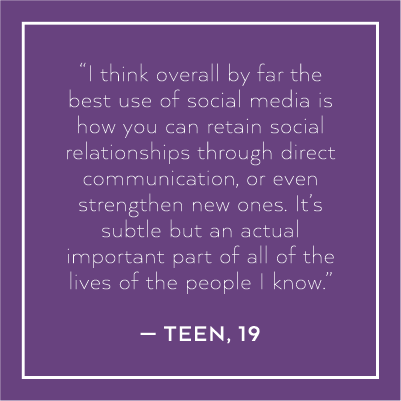
4. FIND YOUR PEOPLE.
Social media platforms connect us to the wider world. What a fantastic opportunity to both expand our perspectives and find others who help us to feel a sense of belonging. For teens, especially those struggling to find acceptance at home or in school for various reasons, reaching out for support on social media can be a lifeline. Search for (or create!) a group around a special interest. Request to join if the group is private, and then introduce yourself to get a conversation and connection started.
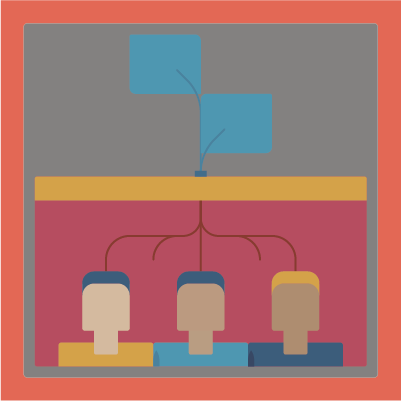
5. MAKE A DIFFERENCE.
Now more than ever, social media is a platform that can ignite support for causes that better the world. Teens are so often at the forefront of changes like these. To really level-up your social media use, start an online petition or relief fund and share it with your friends and followers, or look for opportunities others have initiated where you can lend your voice, time, and talents.
Social media offers meaningful opportunities and can be a sacred "fun zone" for teens. If you're an adult who cares about teens, reinforce those meaningful opportunities by highlighting them when you notice them. If you're a teen, consider sharing with the adults in your life about what social media allows you to do for your mental health and what intentional use looks and feels like to you.
At iThrive, we are building engaging learning experiences where teens can experiment without judgment with different ways to express themselves and connect empathically with others. To stay up-to-date on our offerings and the latest posts in the Supporting Teen Mental Health series, sign up for our mailing list today.
Join iThrive’s Teen Advisory Council and Co-Design Exciting Gaming Experiences
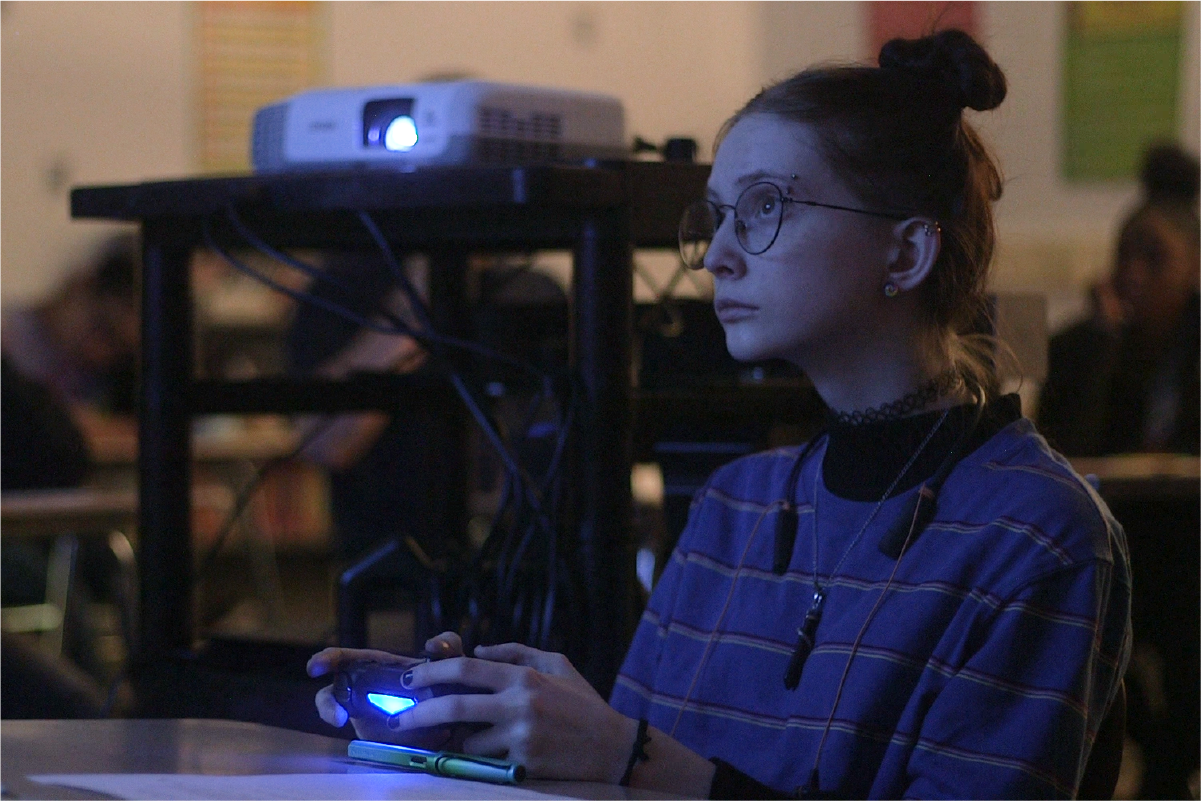
Do you love playing games? Have you dreamt of creating a few? If you said yes, then we need you on iThrive Games' Teen Advisory Council.
Teens tell us all the time how games help them connect with friends, de-stress, strategize take-overs of new worlds, feel a sense of belonging, inspire new ways to learn, and so much more. At iThrive, we love games for all these reasons too, and our mission is to use them to make the world a better place.
We have found that our game designs are better when we design them with teens. Teens challenge us, inspire us, and offer world views and perspectives that we admire and appreciate.
We are launching a Teen Advisory Council and are looking for teens who love games and believe that game design and gameplay can make the world a better place. Members of iThrive Games' Teen Advisory Council are high school students—ages 13-17— who want to:
- Brainstorm, co-design, and test new games and share feedback with game writers, game designers, and our game development team
- Brainstorm new game designs and meaningful, immersive game-based learning experiences with us
- Use their voice in writings, recordings, or designs to share their point of view and experiences about what teens need most right now on topics that may range from game reviews, new game designs, learning, wellness, and more
All members must be between the ages of 13 and 17. Members will serve for a one-year term (February 24, 2022 to February 24, 2023) with an option to renew and will receive a monthly stipend ($150/month). Each month, we will ask you to engage with us on different activities which may include:
- Co-designing and testing new games or courses
- Providing feedback on design or content ideas for our games or courses
- Completing brief surveys to share your ideas and opinions
- Attending a virtual meeting with members of the Teen Advisory Council
We expect that monthly activities will take no more than 6-8 hours.
Applications to join the iThrive Games' Teen Advisory Council have been closed. Follow us on Facebook or Twitter for future updates and opportunities to beta test and consult on games.
Teen Mental Health: Use This 2-Min. Exercise When Difficult Emotions Surface
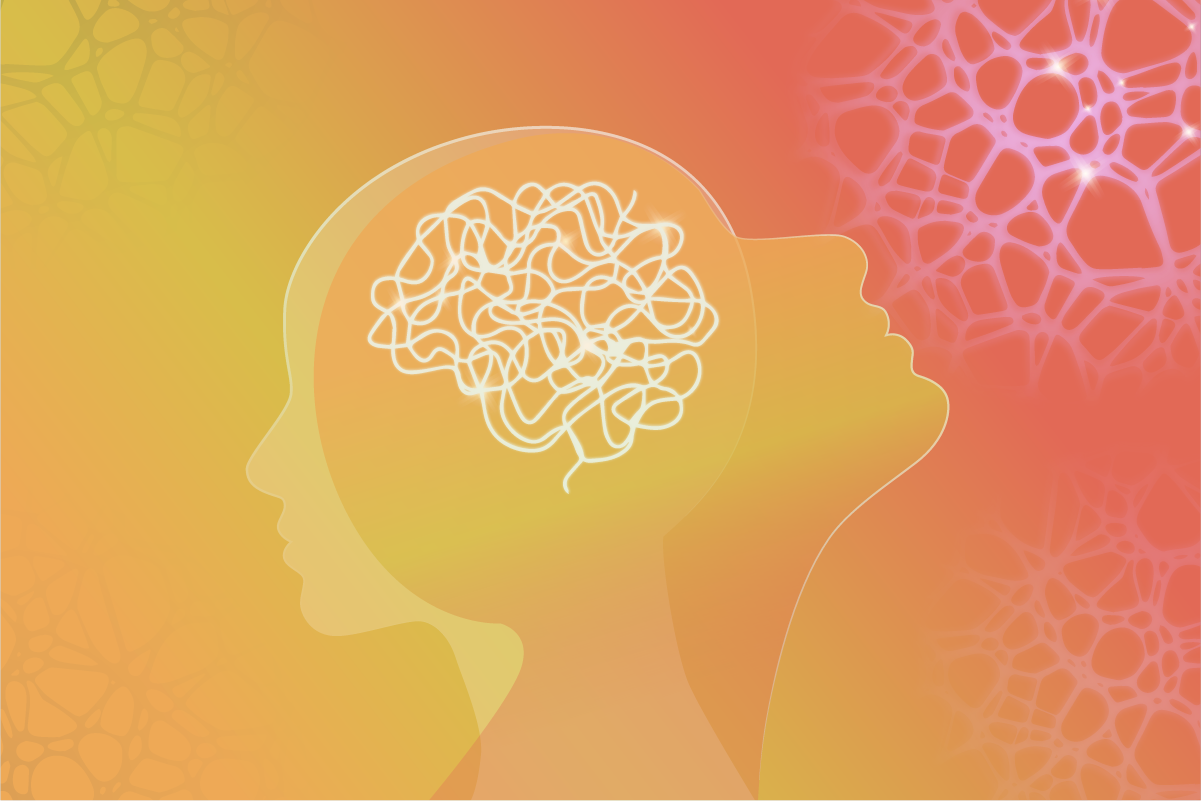
Unprecedented times come with unprecedented challenges, and the ones that today's young people face are tough to navigate. The data shared in the U.S. Surgeon General's Advisory on Protecting Youth Mental Health confirms this. National surveys show that one in three high school students experiences persistent sadness or hopelessness. The world-shifting consequences of an ongoing pandemic coupled with the big emotions that accompany adolescence make our collective need to support teen mental health and well-being both urgent and necessary.
INTRODUCING THE SUPPORTING TEEN MENTAL HEALTH SERIES
The prevalence of mental health challenges amongst youth requires an all-of-society effort to facilitate the individual and structural changes needed to support and protect teen thriving. Over the next few months, we'll be sharing vetted tools and actionable insights as part of a new five-post blog post series titled, Supporting Teen Mental Health. Mapping back to the U.S. Surgeon General's recommendations, each post will feature helpful tips and resources designed to support all youth-serving adults in showing up for teens in this moment of need.
To kick off the Supporting Teen Mental Health series, here's a quick and effective exercise that can be used and shared with teens (and adults!) to support them in getting grounded when big emotions surface.
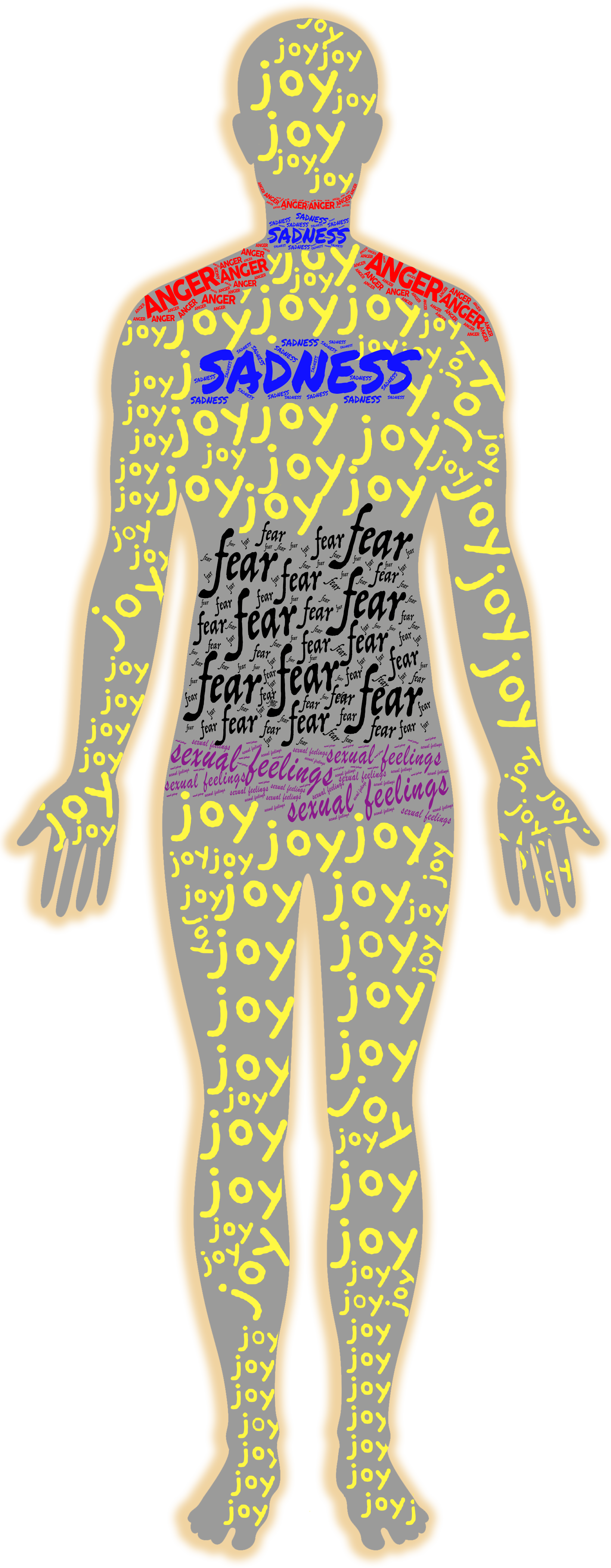 PAUSE-BREATHE-NAME: A 2-MINUTE GROUNDING EXERCISE
PAUSE-BREATHE-NAME: A 2-MINUTE GROUNDING EXERCISE
Whether you're a teen or an adult, chances are you've had moments, shifts, and shocks in life that have brought up strong emotions. In those moments, it can be difficult to regulate those feelings. Pause-Breathe-Name is a quick exercise that can help us manage:
Pause: Start by noticing that a strong feeling has shown up for you and allowing yourself to take a pause before your next word or action.
Breathe: Next, take a couple of breaths. Allow your exhale to be longer than your inhale. This will help to calm your nervous system. As you breathe, try to notice where the strong feeling is showing up in your body. We often feel sadness in our throat, fear in our belly, and anger in our upper back, neck, and jaw. Joy tends to show up all over.
Name: Finally, work on naming the feeling in your head or out loud before returning to what you were doing. The act of naming emotions, especially the more unpleasant ones, actually helps lessen the intensity of those feelings.
This exercise is part of the many social and emotional learning activities in our iThrive Sim role-playing simulation experiences. Students have shared that this exercise has helped them acknowledge moments of discomfort, frustration, and uneasiness they felt while playing as their character, and prepared them to unpack those moments with their classmates. These skills are needed when we have difficult conversations, and practicing these skills helps to strengthen them.
You can use the Pause-Breathe-Name exercise to ground yourself in times of stress and to name the feelings showing up in your body in those moments. What are some other exercises and practices you turn to to get grounded in times of stress? Share with us at contact@ithrivegames.org and stay updated on the latest in the Supporting Teen Mental Health blog series by joining our mailing list today.
Leveling Up: How Playing Video Games Helped Me Find Passion and Purpose
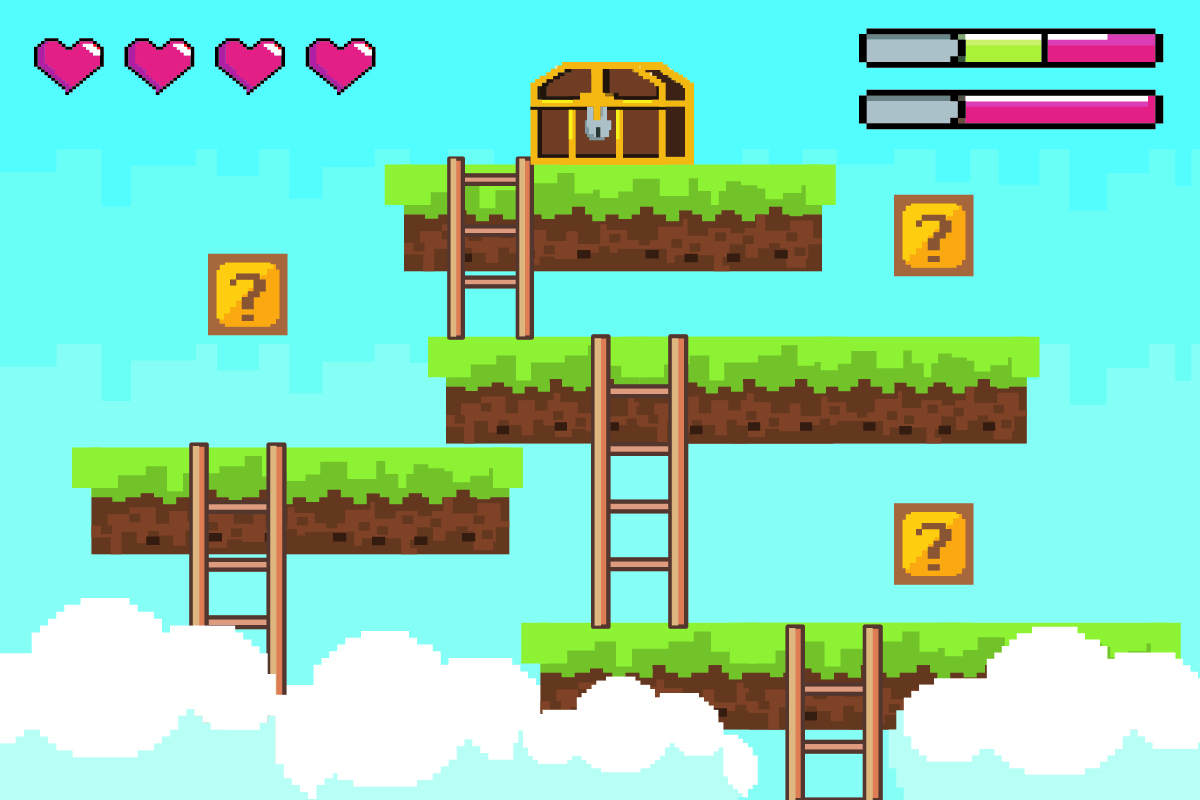
Games have the power to transport us to new worlds where we can safely explore new possibilities and perspectives. They delight us, challenge us, calm us, frustrate us, connect us, excite us, and invite us to uncover new ways of doing and being. Anyone who's played a game, be it digital or tabletop, knows this firsthand.
At iThrive Games, we see springboards for transformation in play's social and emotional value. We believe that when the emotions games evoke are recruited for learning, the learning that happens goes deeper and lasts longer. We champion play as a constructive avenue for academic, social, and emotional growth, co-designing game-based learning experiences with high school students and teachers that leverage the power of play and support teen thriving.
Last year, we launched the Power of Play, a blog series that shared posts from teens reflecting on the many ways games have helped them deal with life, discover possibility and purpose, and question the way things are in the world. We're excited to resume the series this year with the following post from avid gamer Jacob Rivers, an incoming college freshman, who shares a heartfelt story about how video games supported his self-discovery and becoming, preparing him for his next level in life.
"Jake, enough with the video games and get your work done," a phrase I have heard over and over again since elementary school. Being diagnosed with ADD at a young age, school never came easy to me. However, when I opened my Nintendo DS for Christmas, instantly, I was fascinated playing just about any game I could get my hands on, and it helped me become more focused. Once the bus had dropped me off from school, I would run up to my room and immediately play video games. As school got harder and I was about to enter middle school, video games became a sense of escapism for me.
Middle school can be difficult, especially for me who had just moved to a new town and started a new school. Coming from a large city to a small town where I only knew three people was daunting. Although joining a baseball league in sixth grade alleviated the apprehension, I continued to rely on video games. It was around this time that I began to watch Youtubers to learn more and improve my skills. Once I noticed myself getting better, I started to explore the platform of multiplayer. As I transitioned into high school, I became more competitive, and my passion for video games increased.
I was fortunate enough to sign up for an elective as a freshman called App Inventor. It was this class that sparked my interest to one day make my own video game. Knowing what kids enjoy as entertainment and creating something on my own felt like an achievement I could accomplish, and it motivated me even more. Every chance I had, I would take classes to improve my knowledge in the field I wanted to pursue. During sophomore year, one of my friends built his own computer, and this intrigued me. After I had turned sixteen, I got a job to save up the money to make this project happen. It took a lot of time and research to learn how to build a computer and have all the necessary parts. When I completed it, I felt proud, and I knew this was only the beginning of my abilities with computers. As the pandemic hit, I took a leave of absence from work; this caused me to isolate myself from society, and I became more involved with the gaming aspect. When junior year rolled around, I returned back to work. A month later, I was hit by a car, and fortunately enough, I only broke my wrist. Even with this setback, I maintained good grades, and the gaming continued to keep me in check.
As I finish my senior year, I will have the opportunity to take an online coding class where I will learn how to use Python, Java, and C++. This will add to my expertise and give me a head start for what I wish to pursue in college. Looking back at my younger self coping with ADD, I've realized how much I have grown. With gaming, my struggles of focusing in school lessened. With my wish to major in Game Design, I hope one day to make a game not just for amusement but to help kids who have fought with similar learning disabilities like me. I have finally completed this "level" in my life. Now, it's time to start the next one.
We are always looking to amplify teen voice and share their stories that attest to how games help us understand ourselves, each other, and the world around us. Have something to share? Send us your thoughts, stories, ideas, and reflections at contact@ithrivegames.org with a brief blurb about yourself to see it on our blog this year!
2021 Was a Year of Co-Creation, Collaborative Learning, and Play
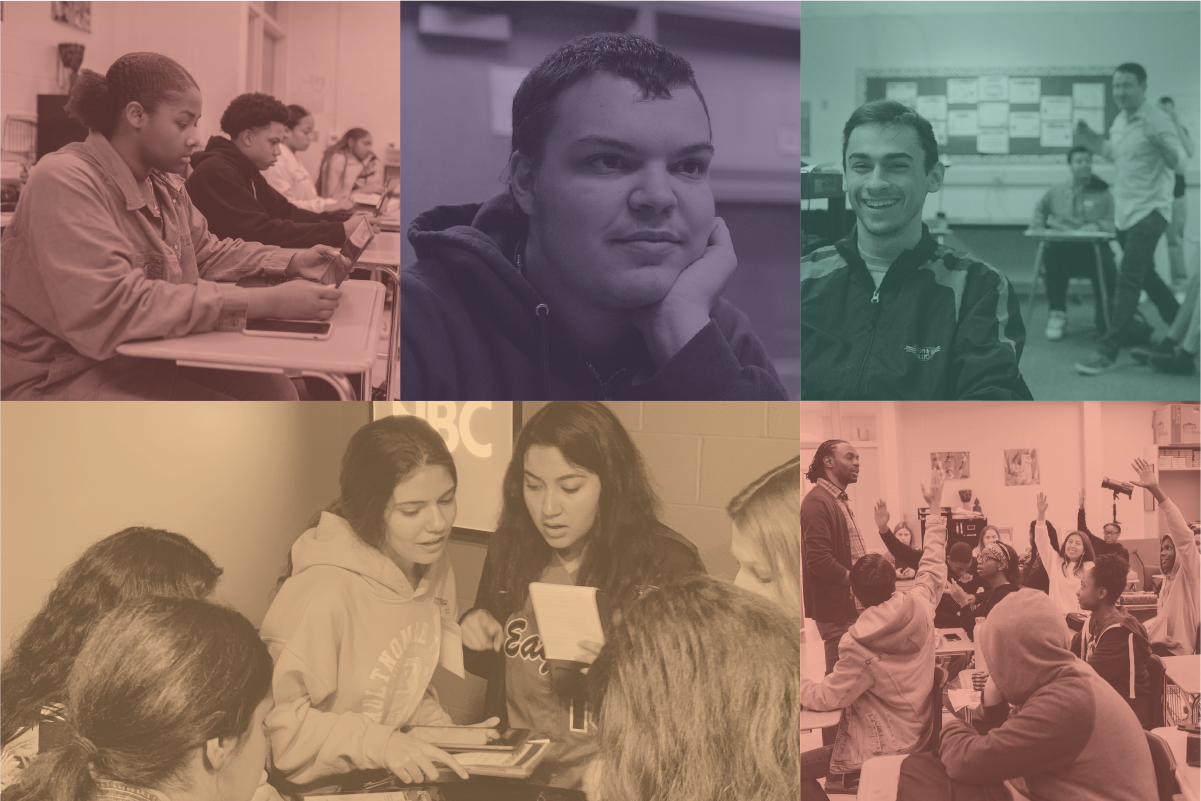
Whenever we are in connection, we learn about ourselves and each other. We entered 2021 with this belief in mind, seeking community with teens and educators to fully understand their challenges, desires, and needs in the classroom and beyond. From our commitment to knowledge-building came co-creation, and the development of new meaningful and collaborative learning experiences that resonate with young people, support their social and emotional development, and meet them where they are through play.
We were happy to release iThrive Curriculum: A Moment in Time, grow iThrive Sim's library with two new scenarios, Follow the Facts and Leading Through Crisis, and launch the Game Design Studio Toolkit after five years of collaboration. After equity reviews of Sam's Journey and Museum of Me, we updated both game-based learning units to include more means of engagement, representation, and action/expression and ensure all learners feel valued, seen, and supported in their genius. At the SEED Institute, we pressed forward in our partnership with Transition HOPE and engaged youth with lived experiences in the cradle-to-prison pipeline via game design, which led to the launch of The RunAround, a board game that highlights the hardships that lie in the journey from 'Maximum Security' to 'Home,' and opportunities to disrupt and dismantle them.
This year, we worked to provide teens with transformative opportunities to see possibilities they never before imagined, open up their thinking about themselves, each other, and the world, and build essential social and emotional skills that support them in stepping fully into their genius. Whether you downloaded an iThrive Curriculum unit, brought an iThrive Sim role-playing simulation scenario to your classroom, or read an article we shared, we appreciate you for the many ways you engaged with us this year. Below is a snapshot of the top five blog posts our readers viewed the most this year:
1. Teens Have Big Emotions. How Can We Help HS Students Navigate Them?: A rapidly developing brain in an increasingly complex world makes for big emotions. How can we help teens cope with them? HS educator and co-author of our game-based learning unit iThrive Curriculum: A Moment in Time Lauren Geschel shares: "recognize them as individuals," "validate their feelings," and "help them be self-aware and deliberate."
2. High School Teachers, Share Your Feedback on the New, Improved iThrive Sim: Read about iThrive Sim's teacher-friendly interface, a feature recently added to the award-winning tool to support high school educators in customizing, facilitating, and steering iThrive Sim's role-playing simulation scenarios in a way that best meets their students' social, and emotional needs.
3. Game-Based Learning Reads: Three Books That Will Make You a GBL Believer: With game-based learning, teachers use play to engage their students in their own learning, embracing student agency over student compliance. Read what seasoned educators and game-based learning experts Matthew Farber, Kat Schrier, and David Seelow say about it in this aggregate book review of their latest reads.
4. Burgeoning Journalists Try on Their Roles in New Media Literacy Game: In this digital age, more data is produced in a second than can be consumed in a lifetime. Our new role-playing simulation game iThrive Sim: Follow the Facts centers media literacy and nurtures players' ability to analyze, evaluate, and report on that data. Read what playing it did for two dozen high school students and burgeoning journalists at the Arizona State University's Summer Journalism Institute.
5. Use this SEL Activity to Help Your Students Process Pandemic Grief and Loss: For teens, grief and loss have been palpable both personally and collectively over the last two years. This social-emotional learning activity invites your students to unpack and process their experiences of these emotions during the pandemic.
As the year winds down, we hope you continue prioritizing connection and wellness throughout the holiday season. Stay connected with us next year by signing up for our monthly newsletter, stocked with updates on our game-based learning products along with exclusive opportunities to try them with your students. Here's to more community, co-creation, and play in 2022.
New Game Design Toolkit Supports Teens in Leading Systems Change
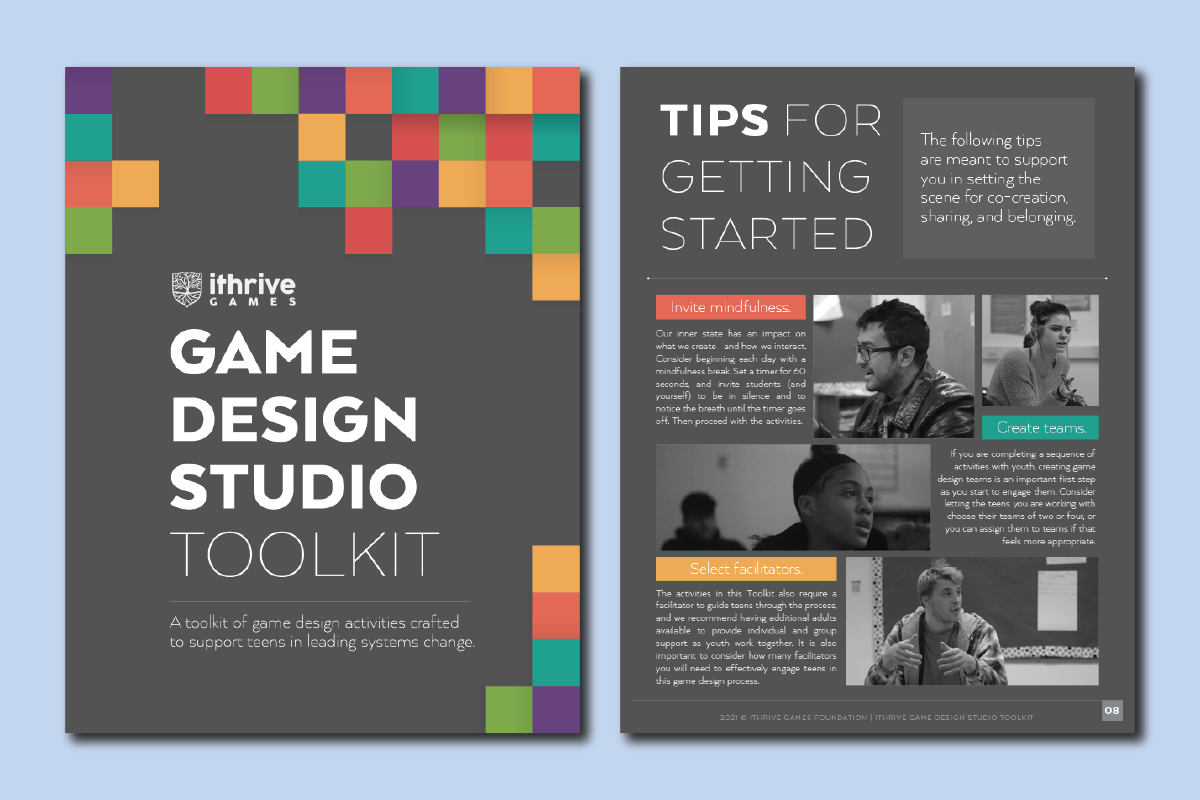
Games are microcosms of the real world, making play and game design springboards for possibility.
At iThrive, we use games to support teens in discovering new ways of doing and being. Our approach centers on their developmental needs, wielding the power of play and emotions to deepen their civic and social and emotional learning. At the core of each tool or experience we've created for and with young people is an unwavering belief in their genius and creative potential to build and imagine a better world. The Game Design Studio Toolkit, created in collaboration with EdTogether and made possible by the generous support from the DN Batten Foundation and the William T. Grant Foundation, assists them in uncovering this within themselves, using game design to reflect, connect, ideate, and lead systems change.
The Game Design Studio Toolkit features 50+ activity guides and accompanying worksheets that merge design thinking, social justice, and social and emotional learning to support teens in exploring societal issues that they experience while thinking collaboratively and creatively about how to respond to them. As teens work through these activities together and create their own games, they engage in individual and collective reflection and action as they challenge their assumptions, redefine problems, and imagine new solutions.
"These field tested activities invite teens to consider their own expertise from their lived experience as they work to understand the systems that surround them," shares Susan E. Rivers, Executive Director and Chief Scientist of iThrive Games. "The activities tap into and build skills like self-reflection and self-expression, empathy and compassion, collaboration and critical thinking as a means to unpack the rules and structures that shape relationships with parents, teachers, and other adults in the many systems teens encounter. Game design offers an amazing, engaging way to merge systems thinking, design thinking, and social and emotional learning."
An identity-safe environment is essential to help teens feel valued, accepted, seen, and welcomed. Tips and design principles found throughout the Toolkit help adult facilitators create this and set the scene for sharing and belonging—two parts integral to co-creation.
"We know that emotion is the driver in learning and in life. It is the thing on which we base our relationships and orientation to the world," says Gabrielle Schlichtmann, Executive Director and Chief Scientist of EdTogether. "With this in mind, we designed the activities in the Game Design Studio Toolkit to fully engage teens in playing games, analyzing games, and making games. The activities tap into and foster their social and emotional skills."
The social and emotional learning opportunities nested in each activity featured in the Game Design Studio Toolkit support the fostering of knowledge and attitudes across each of CASEL's five areas of social and emotional competence: self-awareness, social awareness, self-management, responsible decision-making, and relationship skills. Each activity prompts teens to nurture and exercise these essential skills in areas necessary for individual and collective well-being.
"As youth work together to design games and grapple with important issues, they are developing the necessary SEL skills to make change in their schools, communities, and beyond," shares Lora Henderson, a clinical psychologist, Assistant Professor at the James Madison University, and contributor to the Game Design Studio Toolkit. "We have grown accustomed to manualized social and emotional learning (SEL) programs that teachers implement in the classroom but game design offers a flexible and innovative approach that allows youth to use and further develop SEL skills while also engaging in activities that require both critical and systems thinking."
The Game Design Studio Toolkit invites young people to unpack complex social challenges and understand the human needs involved so they can imagine, create, and test games that prompt new solutions. Built across 5-years of inspiring collaboration with teens and adults across the US, we hope the Toolkit encourages and supports teens in creating the world they want to live in.
Download the complete Toolkit to bring it to the teens in your school, out-of-school program, museum, library, and summer camp today. And let us know how you are using it!
Use This SEL Activity to Help Your Students Explore Their COVID-19 Emotions
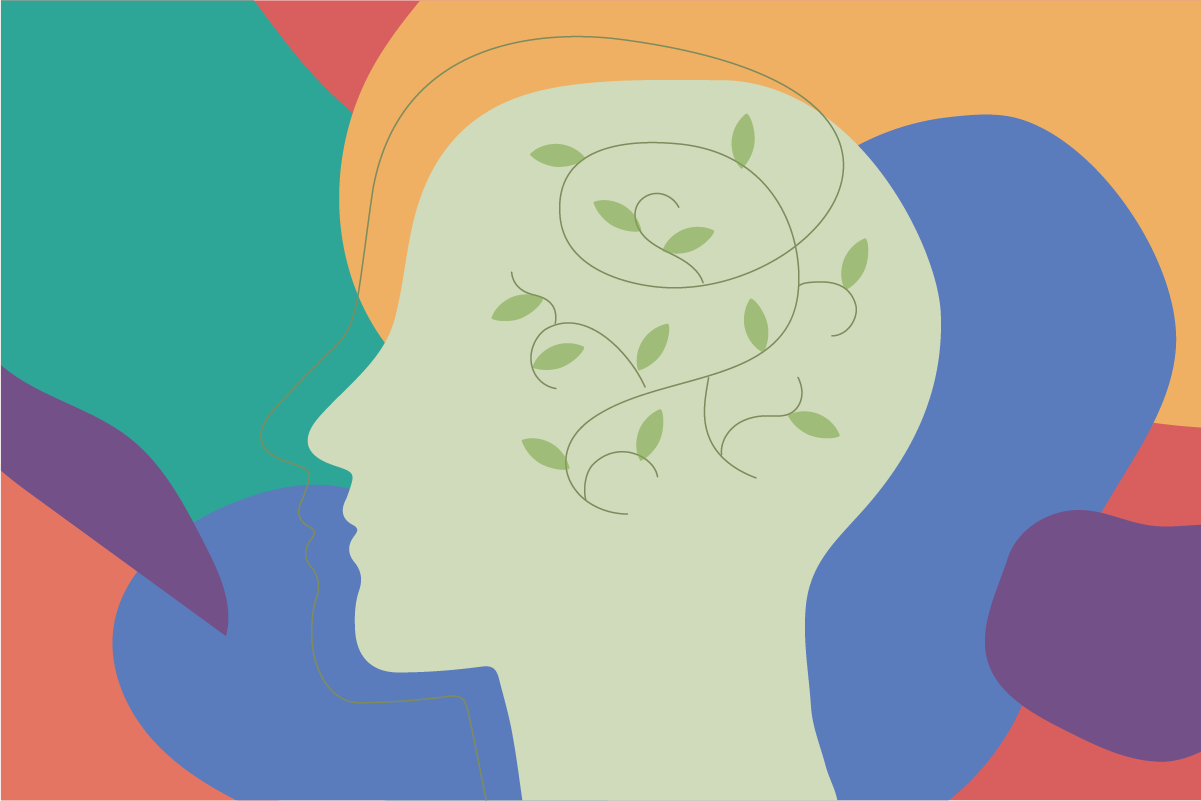
"A mixed bag."
When asked about the emotions they have seen expressed/felt in their classroom since returning to in-person instruction at a recent iThrive Educator Advisory Council meeting, Lauren Geschel, a HS teacher and co-creator of iThrive Curriculum: A Moment in Time, shared this response. For many educators and students, the back-to-school experience can be described in a similar way: a mixed bag of emotions—some that point to pain from what's been lost over the course of this pandemic, but also many that point to possibility in what's to come.
Tending to the emotions that come with this moment in education requires both understanding and empathy. At iThrive Games, we use play as a tool to foster better understanding of self, others, and the world in high school classrooms, crafting game-based, social and emotional learning experiences that support educators in creating connection and presence, while honoring the wholeness of the teens they teach. So, when Lauren later shared the journal writing exercise that got her HS seniors present, engaged, and reflecting on the 'mixed bag' of emotions they've experienced over the last year and a half, we knew we had to share it.
Activity: Pandemic Shifts
Providing in-class opportunities for students to explore their emotions helps create community in the classroom. Try dedicating some time during your next class session to Pandemic Shifts, a social-emotional learning activity that supports teens in being self-aware and reflecting on the shifts they've experienced and witnessed over the last 20 months:
- In preparation for this activity, legibly write the following five-question prompts on five large sheets of paper (one per paper), then post them throughout your classroom:
- What was the most shocking part of the pandemic period for you?
- What was one positive that came out of the pandemic for you personally?
- What have you realized about yourself during this time?
- What do you think has changed about the world that will never go back to the way it was before the pandemic?
- What scares you the most about the future?
- Have students take out five sheets of paper. Read each of the questions above aloud, allowing two to three minutes after each for students to respond to it. Let them know that their responses can be anonymous.
- When students are done, ask them to tape their responses under the respective question prompts posted throughout the class. Allow 10-12 minutes for students to walk the room and read their peers' responses.
- Once students have had a chance to read through their classmates' responses, allow 10-12 minutes for reflecting together about the activity. Remind students to be respectful of their peers. Here are some sample debriefing questions:
- How did that experience feel?
- What are some common threads and throughlines you noticed in your classmates' responses?
- What are some norms we can create this school year that consider these responses?
For educators who bring this activity to their classrooms, we would love to hear how it went with your students. Please share your experience with us at contact@ithrivegames.org, and be sure to stay updated with our growing library of social-emotional learning offerings by signing up for our newsletter today.
Game-Based Learning Reads: Three Books That Will Make You a GBL Believer
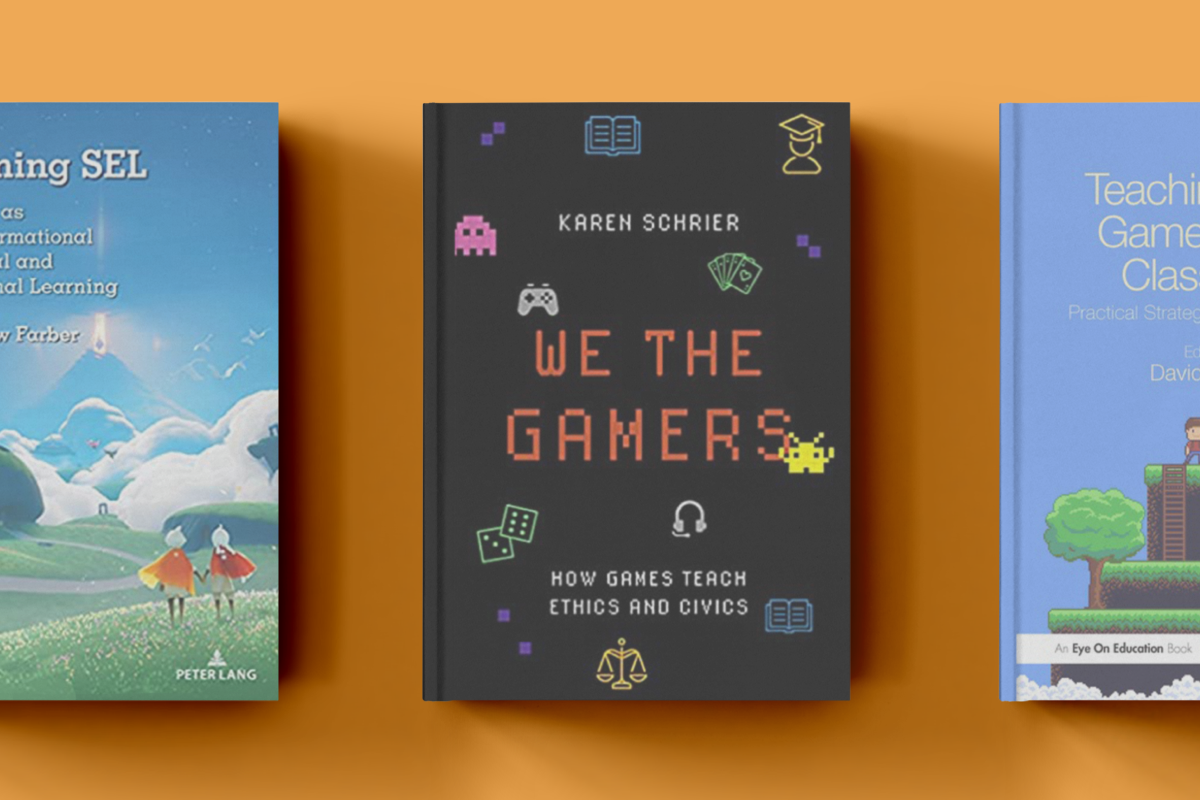
Game-based learning is part of iThrive's DNA as we support educators in bringing the power of play into the classroom. From impactful play and deep learning to personal transformation and social and emotional skill-building, the reasons to thoughtfully include games in educating young people continue to grow. Recently we have enjoyed the contributions of authors Matthew Farber, Karen Schrier, and David Seelow, who have written books adding to the body of knowledge related to game-based learning.
Karen Schrier, We The Gamers: How Games Teach Ethics and Civics
In this useful tome, Karen (Kat) Schrier explores the use of games in multiple contexts, from teaching ethics and civics, to creating connection and community, as well as for knowledge and action, and for critical thinking and inquiry.
Written during the pandemic, the book begins by exploring the many ways games were of great support to humanity during the stay-at-home orders and beyond. The author then takes a balanced approach by questioning when and how best to use games alongside learning, while acknowledging the limitations of games.
For educators who want to explore the power of games in the classroom, this one is a must-read.
Matthew Farber, Gaming SEL: Games as Transformational to Social and Emotional Learning
One thing that comes through in Matthew Farber's book on games and social and emotional learning is his deep love of and expertise in both. And we know that not only from the pages of this book but also because Matthew is a long-time collaborator with the team here at iThrive, having co-created Museum of Me.
Also written during the pandemic, the book is a very readable cornucopia of topics that span first-person accounts of gameplay and thought-provoking explorations of the neuroscience of games to comparing social and emotional learning models and contending with how games do or don't teach compassion, empathy, and mindfulness.
With practical information from links, lessons, and games, to well-woven-in peer-reviewed research, this book is useful to educators and caregivers who want to use games and understand why and how they are an asset for young people.
David Seelow, Teaching in the Game-Based Classroom
In this collection of strategies for game-based learning, editor David Seelow has culled the best teachers, researchers, and games to provide hands-on guidance for adults looking to introduce games into their classroom or youth encounters.
The introduction also stresses the multiple pathways one can take to succeed with game-based learning and ultimately help transform both teacher and student learning.
With contributors such as Paul Darvasi, Lindsay Portnoy, Claudia-Santi F. Fernandes, and more, the strategies offered within span empathy-building and support for wellness to project-based learning and useful feedback loops. A useful book for educators who want to use games to transform learning.
Interested in integrating game-based learning in your classroom this fall? Check out our iThrive Curriculum units and newest iThrive Sim role-playing simulation games, Follow the Facts and Leading Through Crisis, to get started!
Call for Abstracts: Volume 3 of Journal of Games, Self, & Society

Journal of Games, Self, & Society (JGSS), a peer-reviewed journal created and edited by iThrive Games and published by ETC Press, publishes original research and scholarship examining the benefits to humans and to society when games include humanity as a core design element. We encourage interdisciplinary research, community, and conversation focused on how games, game design, and gameplay contribute to a deeper understanding of learning, health, and humanity. We enthusiastically seek original works that push the boundaries of what we know—or what we think we know—about the qualities of games that can benefit our lives emotionally and socially.
The theme of our next issue is games as fuel for connection and transformation for teens.
As society navigates the COVID-19 pandemic and charts a path forward, games continue to be integral to learning and connection at home, in our communities, and in educational spaces (be they virtual or physical). This is especially true for adolescents. We seek papers that highlight real-world applications of the science of gameplay's benefits for relationships, learning, and well-being during this critical developmental period.
We are pleased to announce that Claudia-Santi F. Fernandes and Grace Collins will join us as guest editors for this issue.
We invite educators, researchers, scholars, and game designers from across academic disciplines and industries to submit extended abstracts for consideration in the next issue of Journal of Games, Self, and Society.
Successful abstracts will meet the following criteria: (1) examine the use of games in settings with teens with a focus on relationships, learning, or well-being; (2) demonstrate applications of or commentary on theory and/or an evidence base, (3) are found to be of good fit, adequate rigor, and theoretical or practical soundness, and (4) make a new contribution to the field. We encourage submitted manuscripts to consider and include implications for theory, policy, and/or practice in the discussion section.
Manuscripts published in the journal typically include empirical research using qualitative or quantitative methods (including case study approaches); literature reviews, and detailed descriptions of the game(s) or game design that is the focus of the piece. Submissions may focus on the design approach and analysis of a specific game, use of one or more games in learning settings, applications of policy, or other innovative approaches examining the journal's area of impact.
Please explore previous issues of the journal for examples of works previously published. The journal audience is interdisciplinary and includes designers, researchers, educators, and other practitioners.
Extended abstracts are due by November 20, 2020. Invitations for full articles will be made in November. Full papers are due by May 1, 2021, and will undergo blind peer review. Notifications of acceptance will follow in May 2021 and revisions will be due by July 1, 2021. Accepted works will be published in Volume 3 of the journal in the fall of 2021.
How to Submit
Extended abstracts should be anonymized and follow APA formatting. Abstract should not exceed 1,000 words, excluding references. Please include in your abstract a brief introduction to your research topic, an overview of the theoretical or empirical underpinnings and relevant literature, methodology (if relevant), findings of interest, and implications for theory, policy, and/or practice. Abstracts should also include a brief statement about how the full paper will address the topic of this issue—games as fuel for connection and transformation for teens—and how it advances the mission of the Journal of Games, Self, and Society to foster a deeper understanding of learning, health, and humanity through games.
Abstracts should be sent to jgss@ithrivegames.org no later than 11:59 PM ET on November 20, 2020. More information about the journal can be found here.
About Our Guest Editors
Claudia-Santi F. Fernandes, Ed.D. LPC, MCHES, NCC, is associate director of the play2PREVENT Lab at the Yale Center for Health & Learning Games and an associate research scientist at the Yale School of Medicine. Claudia is an adolescent (mental) health expert with experience in public schools, clinical settings, and research institutions.
Grace Collins is founder and CEO of Liminal Esports. Grace previously taught high school computer science and led games and education policy at the U.S. Department of Education.
Introduction to iThrive’s Clinicians Guides
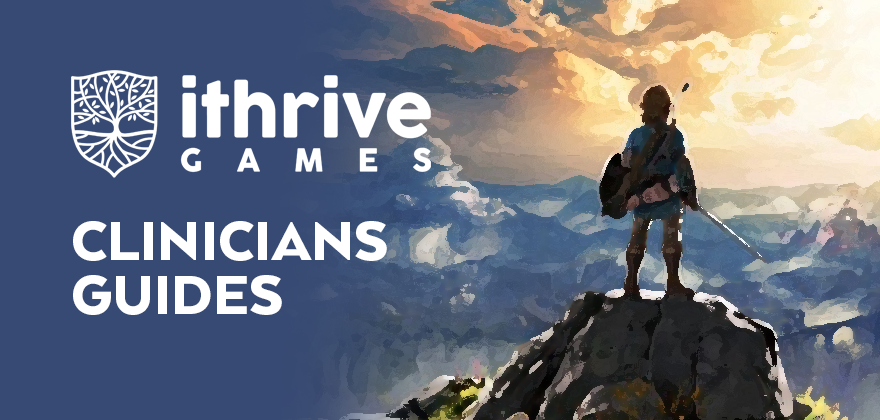
Games are a 21st-century cultural competency. Over half the U.S. population and up to 97% of U.S. teens play video games on a regular basis. Games play an important role in how teens socialize. Games foster connections between friends, offering a space for hanging out together, having fun, devising a strategy, and bonding over shared interests.
For professionals who provide mental health services, the likelihood of seeing clients for whom games matter is substantial. Because of the volume of games released each year and the speed at which players move from one game to another, awareness and understanding of contemporary and relevant games is challenging in general. This is especially true for professionals who provide therapeutic services to teens.
The iThrive Games Clinicians Guides are an educational resource for mental health professionals who understand that embracing a teen's passion for games is an opportunity to enhance the therapeutic process.
"I have found iThrive's Clinicians Guides to be useful in therapeutic practice for helping clinicians understand more about virtual worlds, the powerful and positive impact they have on us, and how to provide appropriate and culturally advantageous endeavors with their clients." - Anthony Bean, Ph.D., psychologist and author of Working with Games and Gamers in Therapy: A Clinician's Guide
Created by mental health professionals for mental health professionals, these one-page "cheat sheets" identify key components of specific video games including their themes, characters, and play styles that can be integrated into therapeutic settings. The goal of the guides is to give mental health providers basic information about a specific, popular video game and different ways to leverage a client's passion for the game in the interest of therapeutic or treatment goals.
We worked with mental health professionals to create and review each of the Clinicians Guides. They have all been field tested and refined to be helpful and practical even for those unfamiliar with the games. The games selected represent some of the most popular games available today.
"Not all games are created equal! Understanding the distinguishing features of different video games is key to understanding what role it might be playing in someone's life. iThrive's Clinicians Guides provide the keys to unlock those answers." - Rachel Kowert, Ph.D., psychologist and author of A Parent's Guide to Video Games
The guides are fundamentally grounded in Human-Centered ideology, the belief that a person grows and thrives when they feel valued, validated, connected to others, and understood. In today's media landscape, competency around games is key to providing this experience.
Each guide was designed to provide a foundation for therapeutically-minded conversations with teens about games. All guides contain a brief summary of the game, highlight events or themes in the game that align with therapeutic framing, a list of questions to spark discussion and reflect genuine interest in the person and their game of choice, and a case example of how the game or game content was used in an actual therapeutic setting. Although not every provider has the resources — time, financial, tech-savviness — to have games and game consoles in their office, there is immense clinical and therapeutic value in being able to just talk with someone about the games that are meaningful to them.
"While video games are ubiquitous, not everyone is a gamer. These guides provide succinct, useful summaries for teachers, clinicians, and caregivers to better understand the completeness of what goes on in various games. And, of course, better understanding helps with better communication with those we care about!" - Raffael Boccamazzo, PsyD, psychologist and Clinical Director of Take This
What do you think? We invite you to:
- Use our Clinicians Guides.
- Let us how they worked for you and/or if they can be improved.
- Share with us your game recommendations for our next set of guides.
Collaborate with us! Email us to find out how.
Live Action Role Playing To Support Healthy Teen Development
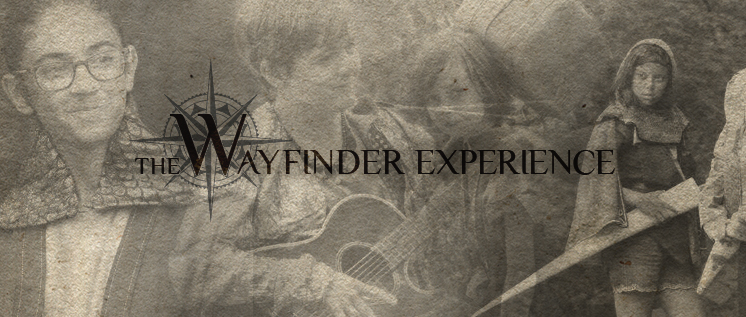
The summer I was 14, I saved the world for the first time. I also attempted to destroy it, spied on the Illuminati, and journeyed into the underworld, all in the span of two weeks. That's what happens when you go off to a summer camp for live action role playing or "larping." I went back every summer throughout my teen years, playing dozens of characters in different worlds. It wasn't long before I was writing games of my own, both for my friends at home and for the camp, the Wayfinder Experience. Over a decade later, I'm a professional larp writer and serve on Wayfinder's Story Board, helping mentor up-and-coming teen game writers as they create new worlds in which to tell stories and explore who they are.
I've run many games of my own, both at Wayfinder and elsewhere, and have learned a great deal about how to create a meaningful experience for teens before, during, and after gameplay. One of the joys of larp design for teens is that their feedback is immediate and obvious — their reactions to design choices are rarely subtle. So here are some takeaways that are relevant not just to larp design but all kinds of game creation for teens.
Design to Support Identity Exploration
One of the most powerful elements of larping is the act of embodying a character that you as a player help create. Sometimes you start from an existing character outline and sometimes you create one from scratch. Regardless, you are an active participant in the creative process, adding details and backstory and identity elements. Players of all ages use this as an opportunity to explore, but teens especially experiment with different possible versions of themselves. They might try larping as a more confident person, or a person with a different gender presentation. Often, these experiments help them test the waters, seeing what it feels like to be who they want to be — or who they could become.
This kind of experimental identity play shows up as soon as players are offered the slightest opportunity to impact a character. When I was in middle school, I loved the video game Chrono Trigger. The only choice I had as a player was to set the characters' names, but you bet I chose my own for the main character, and set the other party members' names to match those of my friends. I wanted to pretend that I could be that adventurous hero, even before larping gave me the opportunity to embody that hero physically.
When you are designing games, consider how your design allows for or encourages the character creation process. What elements of personal identity can players bring into the game? Will those choices have an impact on the game? Will their choices be reflected and respected, or ignored and contradicted by the game as designed? Giving players the freedom to experiment with their self-representation can be a profound tool for exploration.
Design to Support Storytelling
A larp isn't just one story — it's as many stories as there are players. Player each experience their own storyline, all in parallel with one another. This gives players the freedom to seek out different kinds of narratives, and teens will always gravitate on their own to the stories they find compelling and rewarding.
When I was a camper, my best friend always made sure his storylines revolved around epic romances, often ending tragically. He'd find another player or two, create a love triangle, and dig in deep, seeking out a kind of play that I had little interest in. I was more drawn to the political machinations, the schemes and betrayals. But I couldn't help wondering what my friend found in those romances, so I started trying to play with similar narratives. That exploratory process started helping me figure out my own identities.
Over the years, I've seen teen after teen find themselves drawn to particular kinds of play. The types they choose are often very revealing, whether or not the players are consciously aware of it. Allowing that kind of freedom as the designer can be hugely rewarding. If your game design gives players the freedom to seek or create narratives within the larger structure, they will naturally gravitate to the places they feel comfortable and find ways to explore and play.
Provide Scaffolding
While many larps are designed as escapist fun (a worthy end goal in its own right!), some designers build larps with education as the cornerstone. These "edu-larps" can take many forms, from short scenarios to be played in a history classroom up through full weekend-long, immersive adventures. There's a boarding school in Denmark built around edu-larping! Even larps that don't have education as their primary focus can bring in useful tools from edu-larping, though, and help teens grasp important lessons.
A key concept from educational larp design is creating structures that players can use to build their own lessons — what educators call scaffolds. These scaffolds help guide play, both in and out of character, and come in many forms. They could take the form of backstory provided before the game starts, structured decisions with clear options, or just about anything else. Some scaffolds are straightforward, such as providing a moral choice about how to treat a captive prisoner, while others might be subtler, like including characters who are struggling with complex emotional challenges that might mirror the lives of the players.
Years ago, I ran a game set in the mind of a teen girl, with the characters embodying her memories, personality aspects, hopes, and fears. The fears manifested as demons, but as part of the character design, each could be redeemed into a positive version. Isolation could become independence, stagnation could become stability, and so on. One young player confronted the fear of change, and in a tearful scene helped it become growth and moving on from pain. She sent me an email a week later thanking me for the game. She told me that her mother had died recently, and the things she'd been shouting in that scene were very real. The scaffold of the demon's redemption gave her a path she could use to transform her real grief and build an emotional outlet that she could carry forward into her life after the game.
Healthy scaffolding gives guidance that encourages productive avenues of exploration without feeling restrictive or overly didactic. A well-built scaffold can lay down a framework which teens will use to ground their own exploration. The truth is that most games are full of scaffolds, but many are unintentional. An often overlooked part of the game design process is to take a step back and consider what lessons and narratives your design is actually scaffolding. Are there particular choices your characters are making? Are there options that your design closes off or encourages? Are there ways your mechanics and themes are at odds?
You can never (and probably shouldn't try to) completely control the lessons that your players will take away from your games, but good scaffolding can encourage the ideas you want to support.
Provide Recaps and Debriefs
Whether or not game designers realize it, the gameplay experiences doesn't always end when the game itself does. Most larps have some kind of post-game wrap-up, whether it's a party or a diner run or a more formal debriefing process. Wayfinder uses what we call a de-rolling workshop to help ease our players out of the fantasy world and back into their default realities and lives. The next day, we have a story circle where everyone shares their favorite moments from the game and the writer provides an epilogue or closure.
These kinds of recaps serve a number of useful purposes. On a psychological level, they provide a sense of closure, which is helpful both for players whose stories ended cleanly and those who wish they had a more satisfying ending. The storytelling process also helps create emotional distance, separating the player and the character, which can be necessary after emotionally intense games. Game theorists often talk about the concept (coined by Johan Huizinga) of a magic circle, a space for play set aside from the real world. Recaps and formalized debriefs help players transition back out of the magic circle.
On a more practical level, recaps also help players spell out important lessons they learned from the game. This is especially useful with younger players, who may not have realized the game's relevance to their real lives during gameplay. Prompting them to consider the parallels with their real lives once the game is over can help them carry that awareness forward. It also gives them nice clear stories they can take home to their parents.
Here are the biggest lessons I've learned for designing meaningful experiences for teens:
- Allow players to participate in the character process, or at least provide space for them to apply their own concepts to the existing characters.
- Give players options to seek out narratives that they find compelling, and pay attention to what they gravitate towards.
- Provide your players with scaffolds for them to build lessons from. Give them clear choices, and consider the ways your design supports or undermines the lessons you want to be imparting.
- When the game is over, take time to recap the game with your players, both to help transition them back to reality and to help cement the ideas you want them to carry forward.
__________
About the Author

The Power of Teens
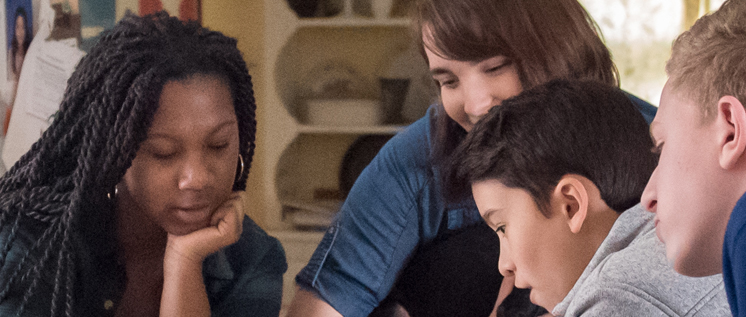
iThrive co-designs games with teens, educators, mental health experts, and professional game developers to discover how play and design can empower teens to thrive. But why do we care about teens?
First of all, we know teens face tremendous pressures. Just a few of them are:
-
- Anxiety and depression are on the rise
-
- Inequities in learning opportunities continue to grow
-
- Our education system fails to provide engaged and effective learning
-
- Teens are bored, overtested, and afraid in schools
- Society's judgment that teens are not capable of making decisions or contributing meaningfully to the world
Researchers at MIT who study teens have even said, "The bottom-line message that emerges from research on adolescent development and parenting is that teenagers are vulnerable. Their boldness and bravado mask an inexperience in solving problems and coping with stress that is often no match for the unsupervised, risk-laden environments in which they live." - The MIT Raising Teens Project
But this deficit perspective-focusing only on the risks and vulnerabilities of adolescence-is incomplete; it overlooks the incredible potential of the teen years.
Teens' brains are undergoing the last major restructuring of development, one nearly on par with the brain growth of early childhood. That means that the environments and interactions teens experience-good and bad alike-leave a deeper mark on the brain than they will in later years. That also means that the teen years provide the perfect opportunity to build habits to support a healthy, productive, and engaged life.
Teens are at a developmental moment defined by strength, not only vulnerability. After all, evolution has chosen this path of reorganization and susceptibility to environmental influences for the teen brain because it works!
At iThrive, we see teens' very unique developmental characteristics as a clear call to action. It is our mission to offer teens opportunities to build skills and flesh out their understanding of the world within supportive environments. What's more, we have to make sure those opportunities are compelling and playful. Learning happens best during play, even in the teen years.
That's why iThrive's approach to teen thriving is two-pronged: Offer skill-building opportunities directly to teens AND enhance the environments where teens are spending their time, all with their input at the center.
[Related article: We Can't Design Games for Teens Without This]
We use games and game design to connect with teens in meaningful ways that take their realities and interests to heart and invite them to gain confidence in themselves and their abilities.
[Related video: Game Design Studio]
But why games?
1. Games are where teens are.
Teens live, learn, and connect with others in virtual spaces as much as in physical ones. It's rare to find a teen without a smartphone nearby. That's why we work with teens to determine what they want their games to offer, and then draw on those insights-and the science of healthy adolescent development-to influence the games developers are creating.
[Related resources and events: iThrive Design Kits, iThrive Game Jams, and strengths-based game prototypes]
Since games are here to stay, let's unleash their power to engage and immerse teens while keeping teens' needs as whole people at the forefront of design.
2. Games reflect-and let us reflect on-truths about real life.
Games and game design are tools for building strengths and creating and sharing new models of how the world could be. That's because, at their core (and no matter how fantastical), games are systems that reflect and expand on truths about the lives we lead: they have rules, win/lose states, rewards, consequences, and many roles for players and other characters to fill. As friend of iThrive and expert game dev, Jason Vandenberghe, says:
"As we know, teens are in a part of their lives where they are absorbing information about how the world works at an extraordinary rate. If we want to make a large, positive change in our world, I believe the best route is to focus on providing teens with better models for the world."
At iThrive we are pushing on the limits of game design because we believe the games that teens play can and should reflect their truths and offer positive, compelling, meaningful, and strength-building content.
3. Games can help level the playing field.
Not all teens have equal access to high-quality learning environments, supportive and caring adults, opportunities deliberately designed to acknowledge and build on their unique strengths, or communities passionately committed to their well being and success in life.
iThrive is dedicated to identifying how carefully designed games can dismantle some of the inequities teens experience by cutting across settings to reach teens with strength-building, engaging experiences everywhere they are.

Teens face many vulnerabilities, it's true. But let's focus on addressing that not by trying to change, control, or overly shelter teens, but by meeting their needs and unleashing their incredible strengths through empowering, playful experiences.
Follow and join iThrive as we strive to raise up the voices of teens and meet them where they are to support their growth and well-being with compelling games and game design. Join us as we play to teens' strengths.
__________
About the Author

A Canadian Game Jam On Mental Health and Teens? Mais Oui!
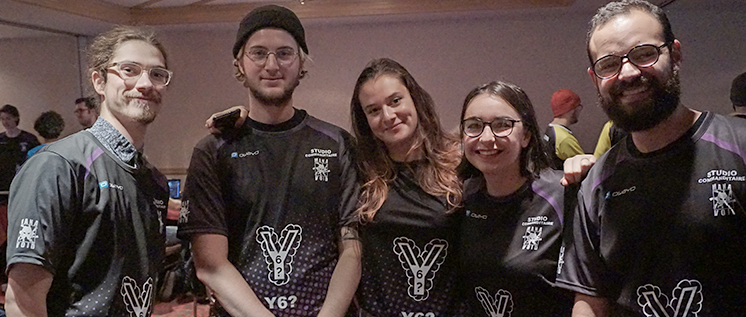
The first weekend of October, iThrive staff made their way to Montréal, Canada to co-host the JamNATION game jam. The jam was the perfect opportunity to test two shiny new Design Kits we developed with expert devs and scholars at this fall's iThrive Design Hive: "Designing for Teens" and "Games and Mental Health." We were eager to debut our design guidelines related to teens and mental health at this unique jam, and our jammers responded with equal enthusiasm!
iThrive Design Kits are best-practices guides that support developers of all experience levels in designing games that promote positive habits to help players-and especially teens-thrive. The ultimate goal of the Kits is to spur the production of compelling and meaningful games: those that perfectly combine fun and innovation with opportunities for players to build critical social and emotional skills. Game jams are where we rigorously field test these Kits to determine if they "work": are they useful and engaging? Are they accessible to devs of many backgrounds and experience levels? Do they produce relevant, innovative prototypes?
JamNATION is a game jam league, kind of like a corporate softball league. Different teams pay membership dues to compete, and teams are often sponsored by large studios such as Ubisoft. They have custom numbered jerseys and everything! There are 6-8 jams during a regular season, and the teams compete for the right to earn a spot at the Season Finale, which is a large, more luxurious jam in the spring with high-end catered food, lots of swag and prizes, comfy sofas, and a masseuse. The jam we co-hosted was the first of JamNATION's regular competitive season, and 85 jammers participated to produce 14 games!

A group of jam participants
Devs designed for themes of mental health and teens, and to make it more challenging, we introduced an additional design constraint: make games with no text or language in them. The jammers were a multilingual audience so we wanted to inspire games that would be accessible to all participants, regardless of their language abilities, and it's also in line with our focus on supporting games that are accessible to the widest range of players possible. We work to build this "Universal Design" into everything we do.
We found much more in Canada to compliment than the poutine. Our thoughtful and dedicated jammers included a couple of teens, which is not typical for a JamNATION jam and certainly enriched our conversations about designing for teens! The winning game was "Breathe," which is fully playable in 3-5 minutes. In it, you play as a teen who needs to balance an ever-increasing number of tasks — pushing buttons and pulling levers and filling meters — and who may eventually be overwhelmed and need to be reminded to "just breathe." This was a great representation of the developmental changes going on for teens, who suddenly have much more adult-like responsibilities and roles to fulfill even as their brains are still learning to cope with stress and other potentially overwhelming emotions.

A developer works on background art for a game.
Other games included a dancing gecko who would change colors to fit in with other groups of geckos (a nod to teens' competing desires to both fit in and stand out, and to their search for a cohesive identity); a glowing squid who descends to the depths of a dark hole to save a friend (friends become much more important to teens than they were in childhood, and teens often turn to each other before family members when they're struggling with something like depression); a character who has to dodge trolls and "earn spectators" while also doing self-care (a nod to social media stress!); and a co-op game where only one player knows where the enemies are hiding and has to describe their location to the other player (practicing taking another's perspective is something teens are still learning how to do, and games like this might strengthen those skills). We were prepared for the possibility that this jam might unearth a lot of heavy themes with its dual focus on mental health and teens, but jammers surprised us by making games full of color and joy, all the while addressing these important topics!
Our new Canadian friends not only introduced us to a variety of potato chips not available in the United States, they also brought their "A" game with some cool mechanics we'd never seen at iThrive Game Jams before: procedural generation and mobile play. We also had more games at a single jam with original music in them than we'd ever seen before. C'est bon!
The Monday that we flew back home happened to be Thanksgiving Day in Canada, and we were and are certainly thankful for the good folks at JamNATION and all the participants who spent their weekend jamming with us. Watch for more about those games and footage from the jam in the new year!
iThrive’s Resources for Educators: Using Games to Engage the Whole Teen
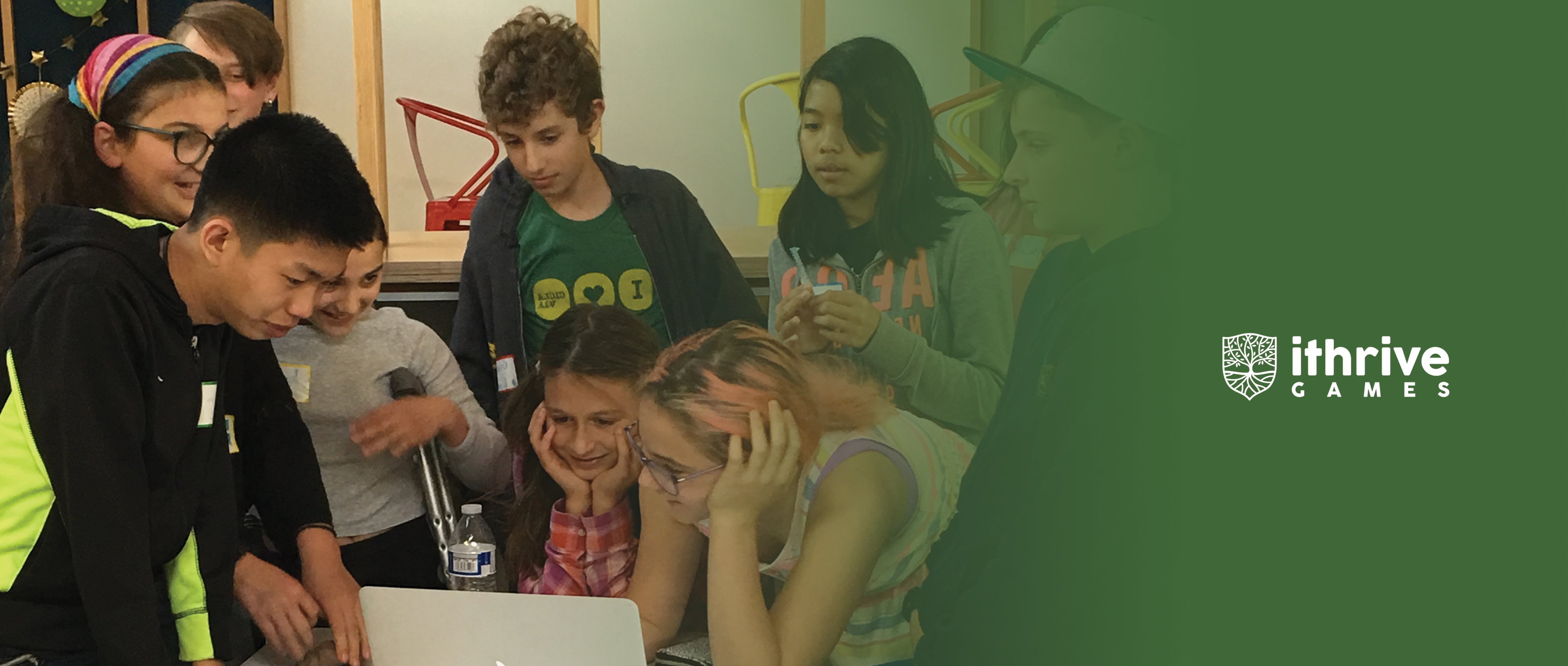
iThrive Games, founded in 2014, is a nonprofit committed to providing meaningful growth experiences for teens, both in and outside of the classroom. Through our education initiatives, launched in 2017, we strive to empower educators to integrate game-based learning in the classroom to support the development of the "whole teen," meaning attending to teens' cognitive, social, and emotional selves.
As iThrive collaborator and veteran social and emotional learning expert, Rachel Poliner, likes to say: "The whole teen is never NOT in front of you." Hoping to isolate the "cognitive self" of a teen — to get them to just pay attention and learn — is impossible and, in fact, counterproductive. Positive emotions and relationships facilitate learning. Only when teens feel safe, connected, and respected is full academic engagement possible. Teens' social and emotional selves are essential to learning.
Video games, both educational and commercial, have been used successfully in education for years, but have been used much less often with teens of middle and high school age than with younger children. They also have been used far too rarely to support social and emotional growth through practices like collaboration, self-reflection, good digital citizenship, and media literacy. Games are often excluded from secondary education in favor of more traditionally "acceptable" media like books and films. This is a huge missed opportunity. We believe that integrating video games into the secondary school classroom can facilitate teaching the whole teen, and we are partnering with innovative educators who are doing just this.
In line with our focus on developing the whole teen, iThrive provides resources and professional development opportunities to teachers to support integrating meaningful video gameplay into education. We invite you to explore our website for materials and updates on our offerings for educators, including our:
Curated Games Catalog
Our Curated Games Catalog is a library of meaningful video games from many genres, along with their age ratings, descriptions, and links to developers' websites. The catalog, curated by iThrive's team of psychologists and game designers with input from our network of experts, can assist you in choosing games that may support skills and habits that teens need to thrive, including Empathy, Curiosity, Growth Mindset, and Kindness. More games and practices are continually being added. Let us know if there's a game you don't see here that you think should be featured!
Article Series
In our games and education article series, we invite teachers and experts in game-based learning — as well as teens who have learned something valuable from their gameplay! — to share tips and resources for integrating video games successfully in the classroom to support rich learning experiences. Read insights from experts like Paul Darvasi, Barbara Chamberlin, and Jesse Schell, and look out for more engaging content that we're adding all the time:
- Game-Based Learning in the Classroom: 3 Essential Questions, by Barbara Chamberlin and Jesse Schell
- An Interview with Kinful: Bringing Cross-Cultural Empathy to Schools with VR, by Michelle Bertoli
- Meaningfully and Realistically Using Games in the Classroom, by Barbara Chamberlin
- Wallop! You Died (Again): Growth Mindset and Cuphead, by (teen contributor) Ian McDonald
- Putting It in Context: Using Commercial Video Games in Education, by Paul Darvasi
- We Can't Design Games for Teens Without This, by Susan Rivers and Gabrielle Rappolt-Schlichtmann
- How Bad Data Have Given Video Games a Bad Rap (and How to Read Beyond the Headlines), by Kelli Dunlap
- Zest in Video Games: Teens Need Some Excitement, by Michelle Bertoli and Heidi McDonald
- Purpose in Games: Empowering Teens to Explore Who They Are, by Michelle Bertoli and Heidi McDonald
- Video Games: A Safe Place to Wonder, by Michelle Bertoli and Heidi McDonald
- I Haven't Leveled Up...Yet: Growth Mindset in Video Games (Part 1), by Michelle Bertoli
- Video Games Can Boost Empathy, by Michelle Bertoli and Heidi McDonald
- Why Do Teens Play Video Games?, by Isaac Handley-Miner
Curricular Resources
iThrive has partnered with a large network of experienced secondary educators to develop rich curricular units around meaningful video games. Our initial efforts are focusing on the visually rich, deeply emotional What Remains of Edith Finch (rated 13+ years) and the heartbreaking social simulation and survival game, This War of Mine (rated 14+ years). These and other in-development units are designed to teach core subject matter in the humanities as well as key social and emotional skills for resilience, including social competence, autonomy, a sense of purpose and future, and problem-solving skills. Over the coming year, iThrive will develop, test, and share these curricular resources for teachers to use and adapt to the specific needs and interests of their teen students.
In the meantime, our Educator's Guides provide a quick overview of games like these that have been used successfully by our educator partners to teach meaningful social and emotional skills in the middle or high school classroom. Check out the guides here and consider how this type of gameplay might enrich your classroom:


We look forward to connecting with an ever-wider network of teachers who believe that meeting teens where they are, in both their virtual and physical worlds, to facilitate meaningful learning is key to their social and emotional growth and resilience. Contact us to get involved!
Co-op Therapy: Using Video Games to Connect with Teen Clients

In my therapy practice, I've found that the best way to reach a client is by speaking his or her "language." When it comes to talking to teens, I don't just mean speaking English or Spanish. I mean speaking fluently about the latest trends, songs, and games.
I once worked with a client who did not want to participate in therapy at all. He just sat there. This is not uncommon, especially for teens brought to therapy against their wishes, but I had some ideas on how to help him open up. I was an in-home therapist at the time, so I was able to observe this client's home environment and easily find things in it to ask him about. In this case, what I chose was the client's GameCube. I asked him about his favorite games and whether he'd be up for playing one of them together. He ran and grabbed two controllers.

Nintendo GameCube, 2001. Image source
We played Dragon Ball Z: Budokai, a fighting game. I was excited to play because we both loved "Dragon Ball," an anime (Japanese cartoon) about martial artists saving the world. The first time we played, I won and he reacted with some playful trash-talk — "Oh, I'll get you next time!" — and we both laughed about it. He seemed to be having fun until I won again.
I noticed he seemed to be getting angrier every time I won, so after a few games I let him win. He became obnoxiously excited, taunting and teasing me for losing. I realized he could benefit from working on social skills and emotion regulation, things that were not on his treatment plan. Stepping into his world by playing a game he loved revealed to me several issues that needed to be worked on to help him thrive, things that previous observation had not brought to light. Finding these things out was a net positive, but continuing to play a game in a way that triggered angry or obnoxious responses was not going to help. So I decided that we would play together, not against each other.
My client didn't have any cooperative games — ones where we could play on the same team together — so I stopped by a Gamestop and picked up some used games for him to choose from. The one he wanted to play was Star Wars Rogue Squadron III: Rebel Strike, which also happened to be one of my favorite games.

Players work together to take down a Star Destroyer. Image source
Rebel Strike is a space-combat simulator set in the Star Wars universe that includes a cooperative 一 or "co-op" 一 mode that would let us play together rather than against one another. This was a great game for us to play because it has no versus mode (a gameplay mode where players compete with each other), only a "story mode" where the roles are equal and the play cooperative. Everything we did would help each other progress toward the goals of each mission. When we started playing, my client didn't seem to understand what was going on or what we were supposed to do. This was a great opportunity for me to fly ahead of him and ask him to follow me. It allowed me to teach him how to play, what the buttons did, and what the objectives were. I was able to be supportive and provide guidance in a way that he was open to.
Once he got the hang of things, we played the game as intended: Take out enemy TIE fighter ships and turrets and explode the Death Star. The important thing is that we did it together. We weren't competing anymore. It didn't matter who shot down more TIE fighters or destroyed the most turrets because ultimately we both won. This was very different from playing against each other in a fighting game.
These experiences helped build our therapeutic relationship; my client understood I was on his team and he began to open up to me while playing.
A few years later in my private practice, I had another client who did not want to open up at first. I asked him about his favorite things to do and playing video games, especially Minecraft, was at the top of his list.
Minecraft is available on many devices, so I was able to explore different ways to integrate it into our sessions. We started with the mobile version. My client had Minecraft on his phone and he asked if he could play during a session. It wasn't ideal because he was playing on his own and it seemed like his way of getting out of being there. So we tried a few different things. We agreed that he could earn game time at the end of the session if he participated. This often works with younger children but it turned out it wasn't a good fit for this teenager. He figured out quickly that he could sit silently for the entire session, or at least until it was time to play.
I tried the opposite approach and let him play at the beginning of the session for a set amount of time, during which we could talk about what he was building. Having something in common to talk about and something else for him to focus on while we talked helped establish a relationship, to lower some of his defenses, and to move toward more open sharing. A tentative peace treaty had been reached.

"Playing together - and not against each other - built trust, and I was able to show my teen clients that I was there to support them using their language."
It wasn't until we started playing together that we began to really make progress in building rapport and working toward our goals. I had an Xbox 360 in my office, so we were able to jump into a Minecraft world together. This is something my client was used to doing at home with friends and family and I immediately noticed that he was more relaxed and he seemed more comfortable with this setup. It was great to see that he was in his element. Exploring a world together, walking through the same space, we were finally able to communicate clearly. Maybe it was the setting, the fact that he trusted me now, or both, but we were finally able to get to work on our treatment goals.
In both of these examples, games were the client's preferred "language." Playing together — and not against each other — built trust, and I was able to show my teen clients that I was there to support them using their language. Using play and games in therapy to facilitate skill building and rapport is well documented, and video games are one digital extension of that approach.
For any mental health providers interested in using games, here are three quick tips for using games in therapy with teen clients:
- Use games as an icebreaker and relationship builder: Asking about games teen clients like can be a great way to kickstart a therapeutic relationship with them. Demonstrating a genuine interest in something a teen is passionate about is always a good way to build rapport, whether it's games, books, or something else that you both like. For me, both talking about and playing games in therapy has been a great way to help my teen clients feel relaxed and trusting enough to talk to me and become open to addressing challenges.
- Use gameplay as a window into habits and behaviors: Games can bring out behaviors or difficulties you may not otherwise see in action and can serve as a jumping-off point to work on developing adaptive skills. Games let players face defeat and frustration in a pretty low-stakes way. Those difficult emotional experiences are great opportunities to connect and work on building awareness and skills.
- Mine games for their personal meaning to your clients: Not everyone has the resources or the know-how to have a dedicated gaming console in the office, and that's okay! Asking questions about what games teen clients like to play, giving them space to relive fond gaming memories, and analyzing the themes or narratives in a game can provide great insight into a teen's internal world.
__________
About the Author

Video Games: A Safe Place to Wonder

"Games are driven by a curiosity over what's in the next level, what's in the next chest, or who the next boss will be." - Mark Filipowich
EDITOR'S NOTE: This article is part of a series that captures game industry experts' opinions on game titles and mechanics that might boost players' positive habits, mindsets, and skills. These insights arose from discussions at iThrive-sponsored think tanks with game developers and scholars.
Without a desire to explore our world, how could we learn? In fact, how could we have survived at all if our ancestors had not ventured into new territory to find food or experimented with ways to start a fire? They had to control their fear of the unknown in order to get the big payoff of expanded knowledge and resources. And in order to overcome fear, something powerful had to motivate them—something like curiosity.
THE POWER OF CURIOSITY.
Curiosity is so rewarding to the brain that it activates the same circuits as sugar. But it is better than sugar, because curiosity helps us learn. When we are curious, we pay closer attention. We think about information more deeply and remember it better. Plus, curiosity gives us a dose of feel-good dopamine, making it a reward in itself. Curious teens report feeling greater life satisfaction, positive emotion, purpose, and hope than their less curious peers.
Generally speaking, people are naturally curious. But fear can get in the way of exploring novelty because, well, the unknown is risky. Venturing outside of our comfort zone can result in failure, or worse. For example, some scholars have argued that traditional education in subjects like science can actually shut down kids' curiosity when it focuses too much on getting the right answer and avoiding mistakes.
"Teens need self-directed opportunities to express their curiosity and explore to their imagination's content within safe boundaries." — Diana Divecha, PhD, developmental psychologist
Teens' brains are especially sensitive to rewards, and they are driven to take risks that broaden their understanding of the world and their ability to navigate it independently. However, the stakes of failure in traditional academic and social settings may hold teens back from fully diving into the trial-and-error process of learning on which curiosity thrives. To engage with new and (for some) intimidating topics like science and technology, or the exploration of personal identity including sexuality, teens can benefit from environments where they feel safe enough to make mistakes and have the freedom to direct their own actions and find personal meaning in the content.
ENTER VIDEO GAMES: A SAFE SPACE FOR CURIOSITY.
Video games are a fantastic playground for curiosity because they are (arguably) a perfect blend of risk, reward, and safety. Players constantly fail but usually stick with it for the promise of great rewards (and often a great story). And when players fail, the stakes are low—they don't lose much beyond a little bit of pride. Because failure is such a natural part of learning to play a game, the process is perhaps less distressing than it might be in "real life." What's more, game developers' skills mixed with technological advances make for virtual worlds that are incredibly intriguing, sometimes purely for their visual splendor and mystery. It's no wonder that teens are drawn to exploring these worlds for hours at a time, testing the limits of what's possible within them.
At iThrive, we are interested in how games can provide a powerful outlet for feelings of curiosity about topics that are constructive, meaningful and relevant to teens' lives and aspirations. We seek out great games that provide opportunities to put curiosity to good use to build skills and learn about the world.
We spent time with expert game developers and scholars to come up with a list of games in diverse genres that are especially promising for channeling teens' curiosity—the strength of seeking out new knowledge and experiences for their own sake, and embracing uncertainty. We share their insights here:
GAMES MIGHT ENCOURAGE CURIOSITY WHEN THEY LET PLAYERS SOLVE A MYSTERY, LIKE IN:
- Her Story (16+ years): More an interactive film than a game, players use a police computer to solve a murder mystery via video clips and searchable transcripts.
- Kentucky Route Zero (10+ years): A point-and-click adventure game/interactive novel "about a secret highway in the caves beneath Kentucky, and the mysterious folks who travel it." - http://kentuckyroutezero.com/
- Nancy Drew series (10+ years): A series of point-and-click mystery adventure games. Players interview characters and search for clues to solve the mystery at hand. Bonus: Depending on which game from the series players choose, they might learn about topics like physics and electricity or become more familiar with other cultures as they play.
- Myst (13+ years): Players explore and examine objects on a mysterious island to reveal secrets about an injustice that they can then help to right.
- Broken Age (13+ years): Players switch between two teenage characters living in very different worlds. They combine objects and explore the world to ultimately discover how the characters' destinies intertwine.
GAMES MIGHT ENCOURAGE CURIOSITY WHEN THEY LET PLAYERS NAVIGATE WORLDS THAT TURN THE LAWS OF PHYSICS AND GRAVITY ON THEIR HEADS, LIKE IN:
- Portal 2 (10+ years): In this spatial puzzle-platformer, players help their robot companion to "find the portal gun, rescue other test subjects, and rebuild the dilapidated facility...Players have to figure out where to shoot portals, how to jump through them, and at what velocity and angle." - www.commonsensemedia.org
- Monument Valley (7+ years): Players experiment with physics and gravity to move a silent princess through a beautiful world of MC Escher-inspired architecture.
- This Is The Only Level series (6+ years): A set of online games where the level stays the same, but the mechanics constantly change. Guide the elephant to the exit...once you figure out the rules!
GAMES MIGHT ENCOURAGE CURIOSITY WHEN THEY LET PLAYERS EXPERIMENT TO CREATE NEW THINGS, LIKE IN:
- Spore (11+ years): An evolution simulation where players create their very own species and guide creatures through 5 stages mirroring real-world evolution: Cell, Creature, Tribe, Civilization, and Space.
- Little Alchemy (8+ years): A simple but delightful online game. Players start with just four elements (air, earth, fire, water) and combine them to create over 500 different objects.
- Minecraft (8+ years): Players move through a virtual sandbox featuring nearly endless possibilities for what they can create from the resources they gather.
GAMES MIGHT ENCOURAGE CURIOSITY WHEN THEY LET PLAYERS DISCOVER THE SECRETS OF FANTASY WORLDS, LIKE IN:
- The Legend of Zelda franchise (8+-12+ years): A classic action-adventure role-playing game with a series of clever puzzles to solve and massive dungeons to explore on the way to banishing villains.
- Dreamfall (18+ years): A mature adventure game that takes place in a future world where the ability to dream is in jeopardy. "An epic adventure across continents, and visit exotic locations in an action-packed and emotional storyline." - www.dreamfall.com
- Dragon Age: Inquisition, (18+ years): An open-world fantasy role-playing game that offers opportunities to explore a massive world and complete quests that interest the player.
- The Elder Scrolls V: Skyrim (18+ years): A fantasy role-playing game with a vast, beautiful world to explore, and countless quests players can opt to take on or ignore. Choices shape who the player becomes.
GAMES MIGHT ENCOURAGE CURIOSITY WHEN THEY LET PLAYERS EXPLORE THE FAR REACHES OF THE "REAL WORLD," WITH SOME TWISTS, LIKE IN:
- 80 Days (13+ years): Players race to make it around the world in 80 days, meeting fellow explorers and learning about 19th-century cities along the way.
- Kerbal Space Program (8+ years): A rocket-building sim that lets players launch missions to "the Mun" and other destinations in the Kerbal universe (similar to our own) using real rocket science principles.
- Abzu (10+ years): Players dive below the ocean's surface, exploring underwater ruins and observing sea creatures as they work to restore neglected areas.
- Pokémon Go (13+ years): An augmented reality game where players explore the real world to catch virtual Pokémon and train them to be strong fighters. The game intrigues players with the shadows of mysterious creatures they haven't yet seen.
GAMES MIGHT ENCOURAGE CURIOSITY WHEN THEY LET PLAYERS EXPERIMENT WITH SOCIAL ROLES, INTERACTIONS, AND IDENTITIES, LIKE IN:
- The Sims 4 (12+ years): This life simulation game lets players fully customize the appearance and personality of their sim and then experiment with interacting with other sims in a variety of kind, mean, and romantic ways.
Video games are a safe and intriguing setting for teens (and all of us!) to let curiosity reign and to freely explore the worlds and topics that interest them as they discover their identity and purpose. Have these or other games let you explore the far reaches of your imagination, or learn about new cultures, places, or eras? What other ways have games let you use or expand your curiosity? Tell us on Twitter at @iThriveGames!
Why Do Teens Play Video Games?
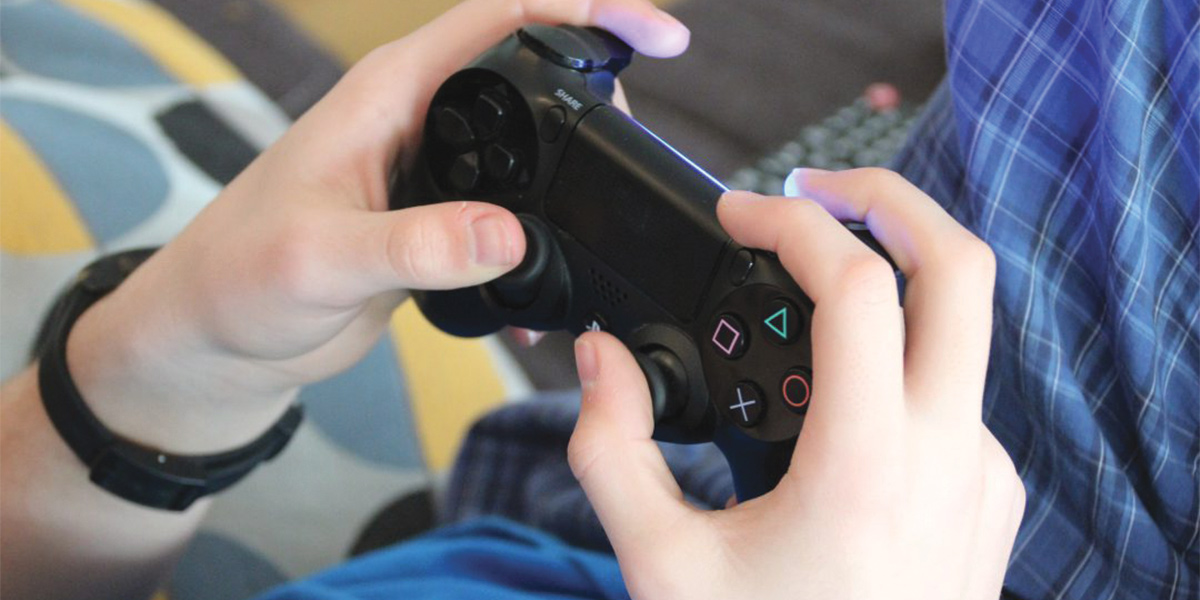
97% of American teens play video games. You'd be hard-pressed to find many other activities that 97% of teens do. Maybe school and sleep. Maybe. So what is it about video games that appeals to nearly all teens? Well, to get the obvious out of the way, video games are play, and play is fun. (It's also more important than many people realize.) But in addition to using video games as a source of play, teens might be doing something else quite sophisticated. Whether they know it or not, teens are harnessing video games to boost well-being by meeting their psychological needs.
GAMING TO THRIVE
According to Self-Determination Theory, all people share three basic psychological needs: competence, autonomy, and relatedness. And the same psychologists who developed this theory argue that one reason video games are so motivatingis that they help players meet all three of these needs. Here's how.
COMPETENCE: VIDEO GAMES CAN HELP TEENS FEEL MASTERFUL.
You know those word searches on the back of Honey Nut Cheerios boxes where you have to locate obscure cereal jargon like "milk" and "spoon"? Have you ever started one of those and refused to leave the table until you completed it, even though you had long since devoured your bowl of Cheerios? No? Just me? Well, in a (honey) nutshell, that's the need for competence. Teens (and people of all ages) seek out opportunities to be challenged and to master a given task-even if that task is finding inane words on a soon-to-be recycled strip of cardboard.
Video game developers use a set of tools that reliably help players feel masterful. Great video games get harder as you progress through them. They ensure that you're always challenged, but not so much that you'll give up. And they provide constant feedback via leaderboards, achievements, and progress bars to make your accomplishments tangible and highlight how to succeed.
Take Guitar Hero. As you play through story mode, the songs get harder, requiring trickier strumming patterns and more fingers on the fretboard. But you also get concrete affirmations of your skills: the song sounds radio perfect when you get it right, your note streaks are satisfyingly tallied and displayed on the screen, and the crowd cheers you on when you shred a sweet solo. In other words: Challenge? Check. Mastery? Check. More fun than the Cheerios word search? Check.
AUTONOMY: VIDEO GAMES PUT TEENS IN CHARGE.
In Self-Determination Theory, the need for autonomy means that people are more motivated to do something if they can make choices about it and shape their own experience. This need becomes a top priority as kids grow into teens. Teen expert Laurence Steinberg calls becoming autonomous "one of the fundamental developmental tasks of adolescence."
The majority of people who play video games do it because they want to, not because they have to. The very decision to pick up a controller and pour hours into a boss battle is one way a teen exercises autonomy. What's more, there are so many styles of games (racing, action-adventure, role-playing, simulation, platformers...) that, just by picking a genre that matches their tastes, teens have the freedom to generate the experience they want every time they switch on a PC or console.
And there's one video game genre that's just brimming with opportunities to feel autonomy. "Sandbox" games-Minecraftis one example-let the player roam wherever, build whatever, and complete tasks whenever. Minecraft players have the choice to build a home (or not), explore the far reaches of the map (or not), and slay the Ender Dragon (or not). In games like this, teen players have the freedom to-quite literally-craft their own experience.
RELATEDNESS: VIDEO GAMES CONNECT TEENS.
What is relatedness? Relatedness is friends. Relatedness is fellow adventurers, soldiers, teammates, band members, and super heroes. Relatedness is humans' desire for connection with others. Positive relationships are key to leading a healthy, fulfilling life, and research finds that teens are using games to make friends.
According to a Pew Research Center report, gaming is social for most teens. Three-quarters of teens play video games with other people at least part of the time, and nearly half of the time that gameplay is done with someone a teen already knows in "real" life.
Katherine Isbister looks to players' publicly posted reflections on gameplay as one way to research how digital games support relatedness. Isbister's book calls out examples of meaningful connections forged through gaming, like the surprisingly deep bond a player felt with an unknown fellow traveler in Journey, even though no words passed between them. Or another player's re-connection with an old friend she didn't know lived in the same city, until Words With Friends matched them up for a challenge.
Game-based relatedness covers a range of connections. Feeling the warm fuzzies for a non-playable character run by the game's artificial intelligence, deepening a connection with someone a player already knows, or taking a friendship with a fellow player out into the real world are just some of them.
APPRECIATING WHY TEENS PLAY
So the next time you're playing a video game (or watching a teen play), see if you notice how the game challenges, frees, or connects. Does the game succeed at teaching skills little by little, paving the way to mastery? Are players free to customize their avatars, choose their difficulty level, or explore at their leisure? Are quests more fun when completed with companions sitting across the room or across the globe? Considering video games from the viewpoint of competence, autonomy, and relatedness, you may develop a deeper appreciation for why many teens choose great video games as one reliable way to meet their needs.
Thriving Teens Use Their Superpowers

DISCOVERING AND USING STRENGTHS IS A PATH TO TEEN THRIVING.
Teens have superpowers. Need evidence?
Consider Malala Yousafzai. At just 15, she defied the Taliban by insisting on her (and all girls') right to go to school. The Taliban shot her in the head, and she survived. Then, she strode right back into the classroom and the public eye to promote equal access to education for all. At 17, she became the youngest Nobel Peace Prize winner ever. Her superpowers: bravery, a thirst for learning, perseverance, and a passion for justice.
Malala's superpowers are on display for the world to see. But each teen has his or her very own set (even if they're hidden under a Peter Parker hoodie for the moment). What are these superpowers? They're the strengths of character that form the foundation of a person's unique impact on this world.
TEENS SET THE STAGE FOR THRIVING WHEN THEY DISCOVER AND USE THEIR STRENGTHS.
Using strengths to thrive is a keystone of positive psychology. Martin Seligman and Christopher Peterson, founders of the field, identified 24 universally valued strengths—including hope, zest, and kindness—that form the pillars of thriving. According to Seligman's model of flourishing, individuals who discover and use their strengths are taking active steps to generate the 5 components of well-being in their lives: positive emotions, engagement, achievement, good relationships, and meaning. Put simply, teens can use their strengths to feel good, do good, do well, and connect both with others and a greater purpose.
Research backs up the link between strengths and well-being for teens, and even shows that strengths can give teens an academic advantage in school. What's more, some studies suggest that cultivating strengths may have a bigger payoff for personal growth and well-being than "fixing" weaknesses.
HOW DO TEENS DISCOVER AND BUILD THEIR STRENGTHS?
Like muscles, strengths of character can be enhanced over time with attention and effort. And, compared to adults, teens' efforts to grow their strengths might be especially effective. That's because teens' brains are remarkably plastic. This malleability makes the teen years a perfect time to learn and build positive habits that can last a lifetime.
At iThrive, we encourage teens to take charge of their well-being by finding opportunities in both the real and virtual worlds to practice habits that align with the strengths of positive psychology.
Here are three things teens can do right now to reveal and strengthen their superpowers:
1. BE CURIOUS.
Exploring different identities and possible future selves is a key part of teens' development. Make strengths a part of that exploration. Teens can take the free VIA Youth Survey to discover their signature strengths. Once those are tallied up, teens can ask themselves: Where did my strengths come from? How and where can I use them more often? How far can I take them?
2. ADOPT A GROWTH MINDSET.
How far can teens take their strengths? Time will tell for each individual. But teens are likely to feel motivated to grow their strengths if they believe their abilities can be stretched and magnified through effort. Teens who think in this optimistic and expansive way are practicing what Carol Dweck calls growth mindset, a state of mind that has established links to achievement and resilience among youth. One way to cultivate a growth mindset is to frame failures as opportunities to learn.
3. PLAY!
Play expert, Stuart Brown, argues that humans of all ages are built to play and learn important skills through play. For teens, video games are one socially acceptable way to incorporate playfulness regularly into their lives (Related: Why Do Teens Play Video Games?). And through this type of play, teens stand to improve their self-awareness. Video games prompt players to constantly reflect on their skills and strengths in order to assess their readiness to take on the challenges at hand. Many video games also offer the opportunity to try on a range of identities and roles. Does a particular teen gravitate towards embodying the healer, the warrior, the builder, the explorer? These tendencies may uncover strengths that teens can explore further in their offline worlds.
Have video games ever helped you identify one of your signature strengths? Tell us about it.
